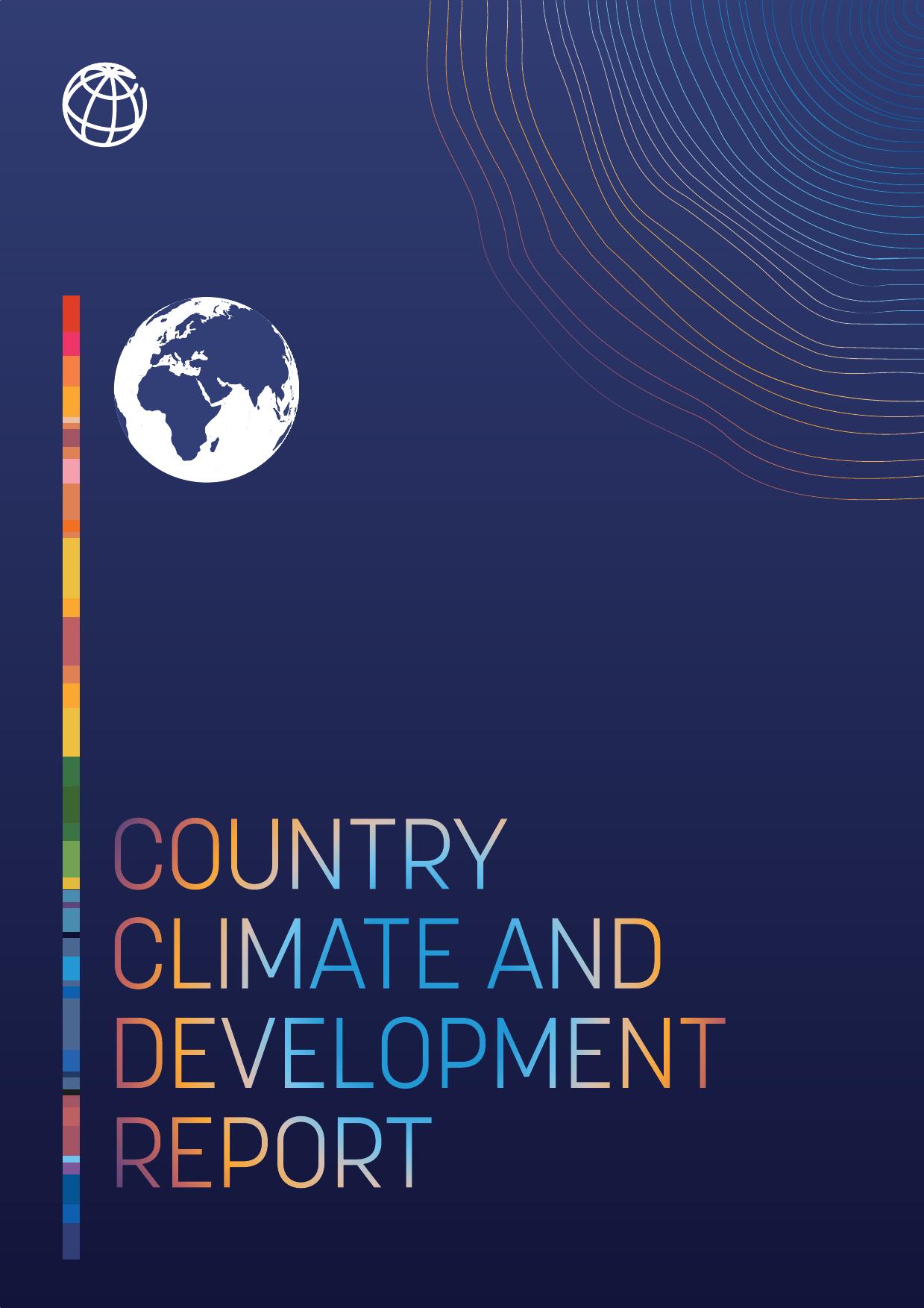EUROPEANDCENTRALASIAROMANIAWorldBankGroupOctober20230CountryClimateandDevelopmentReport:Romania©2023TheWorldBankGroup1818HStreetNW,Washington,DC20433Telephone:202-473-1000;Internet:www.worldbank.orgThisworkisaproductofthestaffoftheInternationalBankforReconstructionandDevelopment(IBRD),theInternationalDevelopmentAssociation(IDA),theInternationalFinanceCorporation(IFC),andtheMultilateralInvestmentGuaranteeAgency(MIGA),collectivelyknownasTheWorldBank,withexternalcontributors.TheWorldBankdoesnotguaranteetheaccuracy,reliabilityorcompletenessofthecontentincludedinthiswork,ortheconclusionsorjudgmentsdescribedherein,andacceptsnoresponsibilityorliabilityforanyomissionsorerrors(including,withoutlimitation,typographicalerrorsandtechnicalerrors)inthecontentwhatsoeverorforreliancethereon.Theboundaries,colors,denominations,andotherinformationshownonanymapinthisworkdonotimplyanyjudgmentonthepartofanyoftheorganizationsofTheWorldBankconcerningthelegalstatusofanyterritoryortheendorsementoracceptanceofsuchboundaries.Thefindings,interpretations,andconclusionsexpressedinthisvolumedonotnecessarilyreflecttheviewsofIBRD/IDA,IFCandMIGA,theirrespectiveBoardsofExecutiveDirectors,andthegovernmentstheyrepresent.Thecontentsofthisworkareintendedforgeneralinformationalpurposesonlyandarenotintendedtoconstitutelegal,securities,orinvestmentadvice,anopinionregardingtheappropriatenessofanyinvestment,orasolicitationofanytype.SomeoftheorganizationsofTheWorldBankortheiraffiliatesmayhaveaninvestmentin,provideotheradviceorservicesto,orotherwisehaveafinancialinterestin,certainofthecompaniesandpartiesnamedherein.NothinghereinshallconstituteorbeconstruedorconsideredtobealimitationuponorwaiveroftheprivilegesandimmunitiesofanyofIBRD/IDA,IFCandMIGA,allofwhicharespecificallyreserved.RightsandPermissionsThematerialinthisworkissubjecttocopyright.BecausetheWorldBankencouragesdisseminationofitsknowledge,thisworkmaybereproduced,inwholeorinpart,fornoncommercialpurposesaslongasfullattributiontothisworkisgivenandallfurtherpermissionsthatmayberequiredforsuchuse(asnotedherein)areacquired.TheWorldBankdoesnotwarrantthatthecontentcontainedinthisworkwillnotinfringeontherightsofthirdpartiesandacceptsnoresponsibilityorliabilityinthisregard.AllqueriesonrightsandlicensesshouldbeaddressedtoWorldBankPublications,TheWorldBank,1818HStreetNW,Washington,DC20433,USA;e-mail:pubrights@worldbank.org.1CountryClimateandDevelopmentReport:RomaniaTableofContentsAcknowledgements............................................................................................................................................3Acronyms............................................................................................................................................................4ExecutiveSummary...............................................................................................................................................71.Climateanddevelopmentcontext........................................................................................................171.1.Developmentcontext..........................................................................................................................171.2.Climateandenvironmentalchallenge...............................................................................................181.3.(Aconcrete)decarbonizationchallenge............................................................................................212.Romania’sclimatecommitments,policies,stakeholdersandcapacities........................................242.1.Romania’smajorcommitmentsandpoliciesonclimatechange....................................................242.2.Stakeholderlandscapeandpoliticaleconomyanalysis...................................................................252.3.Institutionalandgovernanceframeworksforclimatechangeaction.............................................263.Policiesandinvestmentstoadvancedecarbonizationandaddressresiliencechallenges............293.1.HowRomaniacanachievenetzeroby2050:anillustrativepath..................................................303.2.Energy+:Decarbonizingenergy—opportunitiesandchallenges......................................................313.2.1.Decarbonizingelectricity............................................................................................................333.2.2.Decarbonizingtheindustrialsector...........................................................................................343.2.3.Decarbonizingtheresidentialandservicessectors.................................................................353.2.4.Decarbonizingtransport.............................................................................................................353.2.5.Bringingitalltogether:ResultsoftheEnergy+Modelling.......................................................393.3.Buildingresiliencetonaturaldisasters;adaptingtoclimatechange..............................................413.3.1.Integratedwaterresourcemanagement(IWRM).....................................................................413.3.2.ClimateSmartAgriculture..........................................................................................................433.3.3.Biodiversityandforestecosystems...........................................................................................453.3.4.Sustainableandresilientlogistics.............................................................................................463.3.5.Resilient,climate-smartcities....................................................................................................473.3.6.DataResilience...........................................................................................................................494.Economy,People,andCompanies—inTransition..........................................................................504.1.Acompetitivewhole-of-economytransitiontonetzero....................................................................504.1.1.Macroeconomicimplicationsofdecarbonizationpolicies.......................................................504.1.2.Decarbonizingtheeconomywhileenhancingitscompetitiveness.........................................544.2.Anequitableandinclusivetransitionforworkersandhouseholds.................................................584.2.1.Potentialwelfareimpactsofclimatechangemitigationandadaptationpolicies..................584.2.2.Reskillingandupskillingworkersforthegreentransition.......................................................624.3.Financinggreengrowth:therolesofthepublicandprivatesectors...............................................654.3.1.Climate-resilientgreentransitionwillrequiresubstantialinvestment....................................654.3.2.Fiscalpoliciesfordecarbonization............................................................................................734.3.3.Theroleofprivatesectorinfinancingthegreentransition.....................................................755.Recommendations......................................................................................................................775.1.Mediumtermdevelopmentfocus......................................................................................................775.2.Shorttomediumtermclimatechangepriorities..............................................................................78Annexes.................................................................................................................................................82Annex1:Modellingandassumptions............................................................................................................82References.............................................................................................................................................872CountryClimateandDevelopmentReport:RomaniaAcknowledgementsThisCountryClimateandDevelopmentReport(CCDR)isacollaborativeeffortoftheWorldBank,theInternationalFinanceCorporation(IFC),andtheMultilateralInvestmentGuaranteeAgency(MIGA),ledbyMarcSadler,EmilijaTimmisandMarianoGonzalezSerrano.ThisRomaniaCCDRisunderpinnedbysubstantive,highlycoordinatedmodellingwork.Energymodellingteamwascomprisedof:ZuzanaDobrotkova,TomRemy,andJavierGustavoInon.MacroeconomicmodellingworkwasledbyWolfgangKarlHeinzBritz,withcontributionsfromMartinAaroeeChristensen,HasanDudu,CatalinPauna,AndreiDospinescu,PaulinaEstelaSchulzAntipa,FaustynaGawryluk;andadditionalinputsfromMonaPrasad,ColletteMariWheeler,ThomasPaulovici,andAichiroPrabowo.DistributionalimpactandpovertyworkwasconductedbyMonicaRobayoandVladimirKolchin.WatersectorteamincludedChris-PhilipFischer,RitaCestti,GabrielIonita,AmparoSamperHiraldo,IvayloHristovKolev,FanZhang,HomeroAlejandroPaltanLopez,VeraKehayova.TransportteamwascomprisedofNadiaBadea,GregoireGauthier,EduardoEspitiaEcheverria,withadditionalinputsfromMeiMeiAileenLam.Inaddition,substantiveanalyticalworkhasbeenconductedbythefollowingsectoralteams.AlexandruCosminButeicaandElizaMaraBarnealedthestakeholderanalysis,stocktakeofRomania’sclimatecommitments,andresilienceandadaptationcoordination.PrivateandfinancialsectorassessmentsweredonebyLukaszMarekMarc,MagdaMalec,PabloAndresSalasBravo,SamuelRosenow,YiYan,BujanaPerolli,PietroCalice,CristianNacu,JohannesHerderschee.InstitutionalassessmentwasconductedbyHollyBurduja,ShomikhoRaha,andAdinaDragoman;CarolinaRendonandMariusNicolaescuprovidedinputsondataresilience.GreenskillsassessmentwasledbyJavierSanchez-Reaza,withinputsfromDiegoAmbasz,AlejandraTorresCuello,TomaszGajderowicz,MaciejJakubowski,RafaelE.DeHoyosNavarro.BehavioralanalysiswasconductedbyJonathanGeorgeKarver,AilinTomio,andAlessandroSilvestri.DisasterandriskmanagementworkwasledbyAlexandraCalin,withinputsfromAlannaSimpson,PaoloAvner,BramkaArgaJafino,NicholasK.W.Jones,CamillaKnudsen,andBucharestTechnicalUniversityofConstructions.MarcelIonescu-Heroiuledsubnationalandurbanassessments.JulieRozenbergcontributedinputsondecisionmakingunderuncertainty.ValerieMorricaandChifundoPatienceChileraprovidedinputsonsocialsustainabilityandinclusion.AnatolGobjila,LuzBeraniaDiazRios,AdinaPasarel,andJasonDanielRussrepresentedtheagricultureteam.MarcelloArrigoeditedthereport.Helpfulcommentsatvariousstagesofthepreparationofthereportwerereceivedfrom:StephaneHallegatte,DavidStephenKnight,LaurenClaireCulver,NicolasPeltier,BodinBulatovic,RuthQuintHupart,JameleRigolini,XiaodongWang,FanZhang,PabloFajnzylber,AhmadouMoustaphaNdiaye,AlbertoRodriguez,GiovanniBo,HectorPollitt,DavidGroves,DanielJamesBesley,AndreaFitriWoodhouse,MoritzNikolausNebe,KevinCarey,andmanyothers.TheCCDRbenefittedfromdialoguewiththeGovernmentandPresidentialAdministrationofRomania,privatesectorstakeholders,academia,andcivilsocietyorganizationsduringmultipleengagementsinRomania.Ioana-AlexandraIrimiaandCorinaMirabelaGrigorewereinstrumentalinstakeholderengagement.IrinaElenaTalos,MihaiPreda,AnnaKarpets,MarianaIsturiz,CameliaGusescuandmanyothersprovidedexcellentadministrativesupport.TheCCDRwaspreparedundertheleadershipandguidanceofAntonellaBassani,AlfonsoGarciaMora,EthiopisTafaraTadros,SamehNaguibWahba,RanaKaradsheh,HiroyukiHatashima,GallinaAndronovaVincelette,CharlesCormier,LalitaM.Moorty,andFadiaSaadah.ManagerialguidancewasprovidedbyAnnaAkhalkatsi,AryNaim,JasminChakeri,SudeshnaGhoshBanerjee,andThomasFarole.3CountryClimateandDevelopmentReport:RomaniaAcronymsAverageannuallossModelArtificialintelligenceAALArtificialIntelligenceandMachineLearningAIAgriculturalKnowledgeandInnovationSystemsAI/MLActiveLaborMarketPoliciesAKISAtriskofpovertyALMPsFinancialSupervisoryAuthorityAROPBusiness-as-UsualASFBatteryelectricvehicleBAUCommonAgriculturalPolicyBEVsCarbonBorderAdjustmentMechanismCAPClimatechangeCBAMCountryClimateandDevelopmentReportCCCombinedCycleGasTurbineCCDRCarboncaptureusageandstorageCCGTCentralEasternEuropeCCUSComputableGeneralEquilibriumCEEInterministerialCommitteeonClimateChangeCGECapitalMarketBoardCISCCarbondioxideCMBCarbondioxideequivalentCO2CenterofgovernmentCO2eClassificationofindividualconsumptionbypurposeCoGCarbonPricingAssessmentToolCOICOPConsumerPriceIndexCPATCountryPrivateSectorDiagnosticCPIClimateSmartAgricultureCPSDCorporatesocialresponsibilityCSACorporateSustainabilityReportingDirectiveCSRDisabilityAdjustedLifeyearsCSRDDirectorateforCoordinatingPoliciesandPrioritiesDALYsDigitalEconomyandSocietyIndexDCPPDevelopmentFinanceInstitutionsDESIDecisionMakingUnderDeepUncertaintyDFIsDisasterRiskManagementDMDUDepartmentforSustainableDevelopmentDRMEuropeanCommissionDSDEuropeandCentralAsiaECEnergyEfficiencyECAEuropeanGreenDealEEEnvironmentalImpactandSustainabilityAppliedGeneralEquilibriumEGDEnergyPerformanceofBuildingsENVISAGEElectricityPlanningModelEPBDEnergyServicesCompanyEPMEffortSharingDecisionESCOEnvironmentalSocialandGovernanceESDEffortSharingRegulationESGEuropeanSustainabilityReportingStandardsESREmissionsTradingSystemESRSEuropeanUnionETSEuropeanUnionStatisticsonIncomeandLivingConditionsEUElectricvehicleEU-SILCFAOdatasetEVForeigndirectinvestmentFAORuralCreditGuaranteeFundFDINationalCreditGuaranteeFundforSmallandMediumEnterprisesFGCRFNCGIMM4CountryClimateandDevelopmentReport:RomaniaFOLUForestryandOtherLandUseFRCRomanianCounter-GuaranteeFundFRMPFloodRiskManagementPlansGCAMGlobalChangeAssessmentModelGCIGreenComplexityIndexGCPGreenComplexityPotentialGDPGrossdomesticproductGFCGlobalFinancialCrisisGHGGreenhousegasGSGGeneralSecretariatoftheGovernmentGTAPGlobalTradeAnalysisProjectGVCGlobalvaluechainGWGigawatthaHectareHDVHeavyDutyVehicleHD-SDMHigh-DimensionalStochasticDynamicModelHICsHigh-IncomeCountriesHOAHome-OwnerAssociationsICSDInterdepartmentalCommitteeforSustainableDevelopmentICTInformationandcommunicationtechnologyILOSTATInternationalLabourOrganizationStatisticsINECPIntegratedNationalEnergyandClimatePlanIPIndustrialpoliciesIPPUIndustrialprocessesandproductuseIRAInflationReductionActIWRMIntegratedWaterResourceManagementJRCJointResearchCentreoftheEuropeanCommissionkgKilogramktoeKilotonneofoilequivalentLSILatentSemanticIndexingLTRSLong-termrenovationstrategyLTSLong-TermStrategyMABMulti-ApartmentBuildingsMDBsMultilateralDevelopmentBanksMEIPMinistryofEuropeanInvestmentsandProjectsMEWFMinistryofEnvironment,Water,andForestsMFFMultiannualFinancialFrameworkMFModTheWorldBank’sMacro-FiscalModelMICROSIMMicro-simulationMLMachine-learningMMBtuOnemillionBritishthermalunitsMOFMinistryofFinanceMSMemberStateMSMEsMicro,small,andmedium-sizedenterprisesMWMegawattNACENomenclatureofEconomicActivitiesNBMPUpdatedNationalBasinManagementPlanNBSNatureBasedSolutionsNDCNationallyDeterminedContributionNECPNationalEnergyandClimatePlanNGEUNextGenerationEUNGFSNetworkforGreeningtheFinancialSystemNGOsNon-GovernmentalOrganizationNRRPNationalRecoveryandResiliencePlanNSPNationalStrategicPlanNUTSNomenclatureofTerritorialUnitsforStatisticsnZEBNetZeroEnergyBuildingsOECDOrganizationforEconomicCo-operationandDevelopment5CountryClimateandDevelopmentReport:RomaniaPEVCPrivateequityandventurecapitalPIAACProgramfortheInternationalAssessmentofAdultCompetenciesPNASCNationalActionPlanforAdaptationtoClimateChangePPIProducerpriceinflationPPPPurchasingpowerparityPPPsPublic-privatepartnershipPVPhotovoltaicR&D+IResearch,development,andinnovationRCPRepresentativeConcentrationPathwaysRDARegionalDevelopmentAgenciesRERRegularEconomicReportROWRestoftheWorldRRFRecoveryandResilienceFacilitySCDSystematicCountryDiagnosticSDMSystemdynamicmodellingSMEsSmallandmedium-sizedenterprisesSNASCNationalStrategyforAdaptationtoClimateChangeSOEState-ownedenterpriseSSMSSustainableandSmartMobilityStrategySSPSharedSocioeconomicPathwaysSTEMScience,technology,engineeringandmathTCOTotalCostofOwnershipTTWTank-to-wheelTWhTerawatt-hourUHIUrbanheatislandUNFCCCUNFrameworkConventiononClimateChangeVHIVegetationHealthIndexWDLsWorkingdayslostZETZeroEmissionTruck6CountryClimateandDevelopmentReport:RomaniaExecutiveSummaryRomaniahasmadeimpressivestridesinraisingitseconomicperformanceoverthepasttwodecadesbutcontinuestofacesubstantiveeconomic,inclusionandsustainabilitychallenges.Overthepastcoupleofdecades,Romaniahasachievedimpressiveeconomicprogress,transitioningtoamarket-basedeconomicmodel,accedingtotheEuropeanUnion(EU)in2007andreachinghighincomestatus.Between2000and2022,livingstandards(realGDPpercapitainPPP)morethandoubled(fromUS$12,177toUS$32,738).From2015to2020,theshareofRomanianslivingbelowtheupper-middle-incomepovertyline(i.e.,onlessthanUS$6.85-a-dayin2017PPP)declinedrapidlyfrom27.8to10.7percent.However,witheconomicprosperityunevenlydistributed,regionaldisparitiesinincomeandservicedeliveryarewide,withpovertyandinequalityratesamongthehighestintheEU.Povertyremainshighlyconcentratedinruralareas,whichhostapproximately70percentofRomania’spoor.TheSystematicCountryDiagnostic(SCD)of2018summarizedtheoverarchingnarrativeofthecountry’ssocio-economicdevelopmentas‘ATaleofTwoRomanias’.Thiscontinuestoday:oneurban,dynamic,andintegratedwiththeEU;theotherrural,poor,andisolated.ArangeofstructuralchallengesimpactRomania’sprospectsforeconomicallysustainablegrowthandinclusion,whilealsohamperingthetransitiontoagreenereconomicmodel,withaclearneedforcontinuedstructuralreformsgoingforward.Challengesrelatedtoinstitutionalcapacity;abilitytoabsorbanddeployfunds;andpersistentstructuralchallengeswillneedtobeaddressedtounlocktheopportunitiesthatthegreentransitioncanoffer.(SCDUpdate2023).RomaniaisactivelypursuingNetZeroby2050(Net0@2050).AsaMemberState(MS)oftheEU,RomaniahascommittedtokeytenetsoftheEuropeanGreenDeal(EGD):(i)reducingnetGHGemissionsbyatleast55percentby2030,relativeto1990levels(‘Fitfor55’);and(ii)achievingnetzeroGHGemissionsby2050(‘netzero’).Giventhesubstantialreductionsinemissionsinrecentdecades,themedium-termtargetsarewithinreach.AccordingtoEurostatdata,Romaniaalreadyreduceditsemissionsfrom1990-2018by53.2percent,leavingitonlyafurther3.9percentreductiontomeetthegoalsof“Fitfor55”in2030.WhiletheEUemissionsinventoryreportof2023showsevenfurtheremissionsreductionsforRomania,caremustbetakenininterpretingthistrend,whichhasclearlyslowedinthepastfewyearsandwhichhasbeendistortedbyreductionsinemissionsrelatedtoCOVID.Indeed,the2023reportnotesthatemissionsincreasedinRomaniafrom2020to2021.1ReachingNet0@2050willpresentsubstantialchallenges,requiringpoliticalandpopulationbuy-in.Achievingambitiousobjectiveswillrequiresubstantiveemissionsreductionsinhardtoabatesectorsandanadditional96percentreductioninemissionseveniftheFitfor55targetismet.RomaniahaspassedanumberofcriticalclimaterelatedlawsinordertodrivethedecarbonizationoftheeconomyintheshortrunandimportantlyreleaseditsproposedLong-TermStrategy(LTS)inearly2023,whichwillfollowintoforceinduecourse.Inaddition,ithasestablishedstructurestoencourageinter-governmentalcollaboration,themostimportantofwhichistheInterministerialCommitteeonClimateChange(CISC),currentlydisplayinghighbuy-inatthepoliticallevel.Inthebroadersociety,publicconcernaboutclimatechangenowratesinthetopfiveofsocio-economicconcerns.However,onlyaminority(justover40percent)ofRomaniansindicatewillingnesstopayforclimateaction.1Somedatapresentedinthisreportmaynotreflectthelatestdataavailableduetoacombinationoffactors,includingbutnotlimitedto:betterrepresentationofstructuralfactorsbypre-COVIDdata;alignmentwiththedataunderpinningthemodelsusedfortheanalysis;consistencywithrecentlypublishedWorldBankreports;generalcut-offpointforthepreparationofthereport.7CountryClimateandDevelopmentReport:RomaniaEarlysuccessinreducingFigureES.1:AchievingRomania’snetzerotargetsemissionswillneedtobefollowedbyverydeterminedeffortstodecarbonize,nowandinthemediumterm,withactionrequiredacrossthewhole-of-economy.WhilegoodprogresshasbeenmadealreadyinreducingRomania’semissions,muchofthiswasduetostructuralchangesintheeconomyduringthepost-Communistera.Withanexpandingeconomyandgrowinglivingstandards(which,forinstance,comeswithhighermaterialSource:WorldBanksimulationbasedonCGEBox,incoordinationwithothermodels,withGTAPastheprimarydatasource.Note:‘IPPU’denotesIndustrialProcessesandProductUse.Carbonconsumptionandcarsinksreflectadditionalsinkscomparedtocurrentstocks.ownership),thereisarealthreatthatcurrentemissionscouldincrease,asopposedtomeetingthecurrentplansforNet0@2050.Therequireddecarbonizationwillhavetooccuracrossthewholeeconomy,requiringallsectorstoraiseenergyefficiencyandshiftawayfromfossilfuels.FigureES.1demonstratesapotentialpathwaytoachievethis,highlightingtheneedforadditionalfocusandacceleratedactiononexistingandfuturesectoralinterventions.Notably,allsectorsaretofacemajordecreasesintheircurrentemissionslevels,withpowergeneration,agricultureandtransportneedingtoacceleratetheirreductionssubstantiallyinthenearterm.TheFigurealsodemonstratestheneedtoexpandcarbonsinks(specifically,additionalforestsandcarboncapture-orotherfuturetechnologies).TheseadditionalsinkswillbecriticaltobalanceresidualemissionsinlateryearstoreachNet0@2050andtheirachievementwillrequiredeliberatepolicyandregulatoryinterventionstorationalizelanduseandincreaseafforestation.ShiftingfromdirectfossilfuelFigureES.2:Evolutionofpowergenerationundertheproposednetconsumptiontoanelectrifiedzeropathwayeconomybasedonlowcarbonsourceswillrequireamajortransitionincludingamassiveelectrificationprogram.Althoughthecarbonintensityofenergyhasfalleninthepasttwentyyears,itremainsveryhigh.Currentlyover70percentofRomania’stotalenergyusageisdependentonfossilfuels,withtransport,industryandresidentialheatingbeingthemainconsumersofhighcarbonfuels.Ontheotherhand,only34percentofelectricitygenerationisfossilfuelSource:EPMincoordinationwithothermodels.based,withtheother66percentcomingfromrenewablesandnuclearpower.ToreducethedependencyonfossilfuelsandreachNet0@2050,amassiveelectrificationprogramwillbenecessarytoremovedirectconsumptionoffuelsandreplaceitwithenergygeneratedfromnon-fossilfuelsources.Resultsofmodelling(FigureES.2)8CountryClimateandDevelopmentReport:Romaniaindicatethat47percentofpowergenerationwouldcomefromsolarandwindby2050underthenetzeropathway,withanadditionalsevenpercentfromhydropower,fivepercentfromgreenhydrogenandonepercentofotherrenewables,bringingtheshareofrenewablesto60percent.Allcoal-basedgenerationwillbephasedoutfrom2032,andlimitednucleargenerationisprojectedtobeaddedafter2030,representing13percentofgenerationby2050.Bythemid-2030s,CarbonCapture,UtilizationandStorage(CCUS)willhavetobedeployedandscaleduprapidlytodecarbonizenaturalgas-basedpowergeneration,whichhasanimportantroletoplayinbalancingoutthevariabilityofsolarandwindpower,reachinga23percentshareby2050.Theremaining4percentsharewillbecoveredwithelectricityimports.Whileelectrificationandeconomicgrowthmaydoubledemandforelectricity,theincrementalcostofdevelopingagreener,renewablepowersystemdoesnotsubstantiallyincreaseinvestmentneeds.Underallscenarios,themodellingoftheCCDRshowsthatdemandforelectricitywillmorethandoubleasaresultofelectrificationandgrowth.AnalysispresentedinthisCCDR(FigureES.2)andalsotheLTSshowthatthisswitchingispossible,mainlyusingexistingpowergenerationtechnologies,andwithonlylimitedrelianceinlateryearsontechnologiesthatarecurrentlynotfullymature(e.g.,greenhydrogenandindustrialcarboncapture).Notably,theincrementalcostofdevelopingagreener,renewablepowersystemversusanon-greenapproachdoesnotsubstantiallyincreaseinvestmentneeds.However,thebuild-outandstrengtheningofelectricitytransmissionanddistributionnetworkswillbeessentialtosuccess.Batterystorage,criticaltosupporttherapidgrowthofrenewables,isprojectedtoreach4GWofcapacityby2030andmorethan11GWby2050,althoughitsearlyuptakemayrequirepolicysupportandsomegrantfinancing.TheNECPestimatesaneedfor400MWofbatterystorageby2030butachievingregionalclimateneutralityby2050willrequirearapiddeploymentoflargeramountsofstorage.Itwillbecriticaltoincreaseenergyefficiencyinbuildings,especiallythroughbetterinsulation,withasizeableroleforprivatefinancetocomplementnationalandEUpublicfunding.PertherevisedEUDirectiveontheEnergyPerformanceofBuildings(EPBD2010/31/EU),everyEUmemberstatemustdevelopalong-termrenovationstrategy(LTRS)toachieveanear-zeroenergybuildingstockby2050(theso-calledRenovationWave).Currently,approximately0.5percentoftheRomanianbuildingstockisrenovatedperyear,withtheLTRSindicatingagradualincreaseto3.39percentperyearby2030.TheLTRSestimatestotalinvestmentneedsintheamountof€12.8billionby2030,whichmaygrowto€16-18billionduetorisingcosts.Amajorchallengewiththeplanisthat61percentofthecostsareexpectedtocomefromprivateandcommercialsources.TheNRRPalreadyallocates€2.2billiontotheRenovationWave,butmorecapitalneedstobeurgentlymobilizedandfinancingmodelscreatedtocatalyzetheprovisionofprivatefinance.Additionally,thislevelofrenovationwillrequirea500percentincreaseinthenumberofsuitableworkersanda600percentincreaseinthenumberofarchitectsandengineers.Householdsandtheservicessectorarereadyforgreaterelectrificationandenergyefficiency,thoughsolvinghighup-frontcostsforthepoorerconsumerswillrequiremoresupport.Theresidentialandservicessectorstogetheraccountforalmost40percentofthecountry’sdemandfornaturalgas,50percentofelectricitydemand,and74percentofdistrictheatingdemand.Furthermore,risingtemperaturesareexpectedtoboostdemandforcoolingandchangeitsseasonalprofile.Decarbonizationwillrequirefurtherelectrificationofcookingappliancesandtheadoptionofheatpumpsforindividualheatingsystems(preferablyreversibleheatpumps,capableofcoolinginthesummer);thelatterinparticularwillrequireinnovativefinancinginstrumentswithpotentialblendingwithgrants,giventheirconsiderableup-frontcosts.Forthepooresthouseholds,whichcurrentlyburnwoodforheating,theimpactofheatpumpsonelectricitybillsmaymakethemunaffordableevenifinstallationcostswerefullycoveredbygrants.9CountryClimateandDevelopmentReport:RomaniaDecarbonizingdistrictandothercentralizedheatingsystemsremainsachallenge,yetwithabundantuntappedopportunities.District,large-neighborhood,andcentralizedbuildingheatingsystemsremainanimportantsourceofheatinginRomania,althoughtheiruserbaseshrankby85percent,toonly1.3millionpeople,between1992and2020.Low-temperaturerenewableheatfromgeothermal,solarthermal,bioenergy,andwasteheatsourcesiswidelyavailableinmanyregionsofRomaniabutremainsuntappedduetolimitedtechnicalcapacityandtheneedtorenovateandadaptexistinginfrastructure.Industryfacesadoublechallengeofneedingbothtomoveupvaluechainsandtodecarbonize,yetexistingtechnologiespresentsomealreadyworkablesolutions.Industryaccountsforalmost46percentofthecountry’stotalelectricitydemand(plusdirectconsumptionof26percentofnaturalgas,17percentofcoaland10percentofoilusedinthecountry).Theemissionsintensity(measuredinCO2equivalentemissionspereuroofvalueadded)ofRomanianmanufacturersisthreetimesgreaterthantheEU27sectoralaverage,andmorethantwiceashighasthesectoralaverageofpeercountriessuchasPolandandHungary.BringingemissionintensityinmanufacturingdowntotheEU27averagelevelwouldlowerRomania’stotalGHGemissionsby14percent,whilematchingthelevelsachievedinbest-performingDenmarkwouldcuttotalemissionsby25percent,althoughthelattergoalwouldrequiremovingupthevalue-addedladder,inadditiontoreducingactualemissions.Intheshort-term,reductionsareachievableinlightindustrythroughi)energyefficiency;ii)usingrenewablesourcesforlow-tomedium-temperatureheatproduction;iii)electrifyingmanufacturingprocesses;andiv)substitutingexistingprocesseswithlow-carbonalternatives.Moreover,certainindustrialprocesses(e.g.,fertilizersproduction)maysubstitutenaturalgaswithgreenammoniaproducedwithelectricityfromrenewables.ForheavyindustryCCUSandgreenhydrogensolutionsareexpectedtoplayanimportantrole,buttheircurrentcostisunattractive.TheEU’sCarbonBorderAdjustmentMechanism(CBAM),settotakeeffectin2026,willhaveaninfluenceonthepaceofindustrialdecarbonization,thoughmoreworkisneededtounderstanditsfullimpactonthevaluechains.Thedoubledevelopment-climatechallengepertainsalsotoRomania’stransportsector,whichremainsunderdeveloped,holdingbackgrowth;andisbothcriticaltoNet0@2050andhardtoabate.ThesubparqualityoftransportinfrastructureisoneofthekeybottleneckstoRomania’scompetitiveness,developmentanditsconvergencewiththeEU.Thecountryfacesarangeoftransport-relatedchallenges,includingregionaldisparitiesinconnectivityandvulnerabilitytoclimatechange.DespitesizeableEUfundsprovidingaboostforsignificantpublicinvestment,especiallyfocusedonroads,RomaniastilllagsinEuropeintermsoftransportinfrastructureandservicequality(pleaseseeRomaniaCountryPrivateSectorDiagnosticformoredetails).Emissionsfromthesectorincreasedby50percentfrom2005to2019,nowaccountingfor17percentoftotalandsettoriseintheabsenceofincreasedclimateaction.96percentoftransportemissionsrelatetoroadtransport–in2019,95percentofpassengerkilometerswerebycarorcoachand70percentoftonne-kilometerswerebytruck,theimpactofwhichisexacerbatedbyavehiclefleet40percentolderthantheEUaverage.Acceleratinginvestments,deployingexistingtechnologiesandencouragingbehavioralshiftscanalreadyhelpcurbtransportemissionsandhelpputthesectoronthedecarbonizationpath.Thedecarbonizationofthetransportsectorwillrelyonreducingthenumberofroadtrips,shiftingtransporttourbantransitsystemsandrail,andprogressivelyreplacingtheexistingfleetwithlowandno-emissionvehicles.Promotingactivemobilityandpublictransporttoreducingthenumberofroadtripsshouldbeprioritized,especiallyinurbanareas,throughtheexpansionofdedicatedspaceforpublictransportvehicles,parkingandaccessmanagementstrategies(includingpricinginstruments),investingincyclinginfrastructure,anddevelopingHighSpeedRails(HSR),i.e.,theconstructionofHSRbetweenConstantaandtheHungarianborderatOradea.Onfreighttransport,acceleratinginvestmentstorenewtherailwayinfrastructure–morethan60percentoftherailwaynetworkweredueforrenewalasof2020–andimprovethesector’sperformancewillbekeytoachievetheRomanianRRPtargetofshifting10percentoffreightroadtraffictorailby2026,andsubsequentdecarbonizationobjectives.10CountryClimateandDevelopmentReport:RomaniaInterventionsshouldalsoaimatstrengtheningintermodaltransportthroughmoreseamlessandefficientintermodaltransitions(e.g.,withinlandwaterwaystransport).Moreover,decarbonizingthetruckingsectorbyimprovingfuelefficiencyintheshortertermandtheprogressiveuptakeofZeroEmissionTrucks(ZET)iscrucial,asitwilllikelyremainrelevantevenwithasignificantmodalshifttorail.Likewise,theelectrificationofpassengercarsneedstobeaccelerated,aimingatreaching50percentofnewregistrationsofpassengercarsandvansbeingzero-emissionby2030,and90percentby2035,includingsecond-handimports.Toreachthesetargetsofreplacingthevehiclefleet,theGovernmentshoulddeployamixofpoliciesincludingtargetedmeasurestoreducetheshareofsecond-handvehicles,carbontaxesonroadfossilfuels—withappropriatecompensatorymeasures,differentiatedvehicletaxationorfeebatesforlowemittingvehicles,incentivestoelectrifyhighlyutilizedfleetsandtailoredfinancinginstrumentsandchargingschemes,withparticularsupporttosmallcapital-constrainedenterprisesandvulnerableuserstoensureajusttransition.Partneringwiththeprivatesectortodeploypubliclyaccessibleandrapidcharginginfrastructurewithlargecoveragewouldbeakeyenablerforthetransitiontoe-mobility.Consideringtheinstrumentalroleofe-mobilityinthedecarbonizationofthetransportsector—especiallyforpassengervehicleswhichshowcaserapidlydecreasingcosts,thestrengtheningofthechargingnetworkwithalargernumberofchargers,increasingcoverageandreducingchargingtime,shouldbeapriority.Incentivizingchargingtariffs,deployingtaxincentiveschemes,financingmechanisms,andpartnershipscanhelpimprovethebusinesscaseforprivatesectorinvestmentandensurefastbuild-upofcharginginfrastructure.WaterisamongthemosturgentemergingissuesinbothFigureES.3:WateravailabilityadaptationandmitigationagendasinRomania,withcriticaldevelopmentgapsalsoyettobeplugged.Onthem3perpersonperyear4000adaptationside,climatechangeandnaturalhazardspose3000atwinthreattocontinuedgrowth.Intermsofnaturerelatedrisks,Romaniafacestwinthreatstoitslong-term2000growth—theimpactsofclimatechangeandexposureto1000naturalhazards.ClimatechangeinRomaniawillparticularlyimpacthydrologicalcycles,alteringthetiming,0frequencyandintensityofprecipitation.Romaniaalreadyfacesadichotomy—ontheonehandalreadyclosetotheRomaniaEUwaterscarcitythreshold(FigureES.3),includingAveragewateravailability(m3percapitaperyear)Waterstressthresholdmanifestingthroughrecentdroughts;andontheotherSource:BankStaffwithEurostatdata.severelyatriskofflooding,withprojectedpotentialannuallossesofuptoalmost€2billionperyear.Thedevelopmentchallengesrelatedtothesectorareclear—Romaniahadthehighestpercentageofpopulation(21percent)withoutaccesstobasicsanitaryfacilitiesin2020,wateriscriticaltolowcarbonpowergeneration(bothhydroandnuclear);transportdecarbonizationhingesonusingmaritimeandriverroutes,andtraditionallyrainfedagricultureisincreasinglyneedingirrigation.TheneedforRomaniatodramaticallyincreaseitsimplementationofIntegratedWaterResourceManagement(IWRM)isurgent.Risingtemperaturesandanincreasedfrequencyofheatwaveswillposeadditionalthreatstotheeconomy,people,andinfrastructure.Urbanclimateprojectionsshowasubstantialincreaseinurbanheatby2050(50percentincreaseinthenumberofheat-wavedaysinahigh-emissionsclimatescenario)anditisestimatedthatfatalitiesassociatedwithextremetemperatureeventsalreadyincreased25percentinthe1991–2018period.Thiseffectisfurtherexacerbatedbythetendencyofbuilt-upneighborhoodstoabsorbandtrapheat(theUrbanHeatIsland{UHI}effect)andisaparticularproblemforurbanpopulations(wherealsomuchoftheeconomicactivityisconcentrated),withheatwavedaysinBucharestandClujmorethanthreetimesthesurroundingruralareas.Addressingthischallengewillleadtoanincreaseindemandforenergyforcooling(andtherebyincreased11CountryClimateandDevelopmentReport:Romaniaemissions)unlessproactivestepsaretakentoreducetheUHIeffectthroughagreeningofurbanspacesinconjunctionwithdeploymentofothertechnologiesandapproachesthatreducetemperatureabsorptionofstructuresandsharedspaces.Thecombinedthreatsofwaterscarcity,increasedvariabilityofprecipitationandincreasingheatposesignificantchallengestotheagricultural,land-useandforestrysectors.Withagricultureaccountingforaround20percentoflaborand4percentofGDP,itholdsanimportantsocio-economicplaceinRomania.Withalreadyrelativelyhighinterannualvariability,growthhasbeencharacterizedbyexpansionoflow-valuecommodities;contractionofotheragri-foodandlivestocksectors;modestgainsinproductivity;anderraticyieldpatterns.Climatechangewillincreaseweatherrelatedlosses,particularlyundernon-irrigatedconditions,furtherincreasingthedividebetweenlarge-andsmall-scaleproducerswherethelatterarelessabletomanagerisks.Expansionofirrigationsystemsinparticularlydroughtproneareasshouldbeapriority,whilesimultaneouslyidentifyingthedriversbehindcurrentlowusageratesofexistingirrigationinfrastructureandriskmanagementtoolsavailableundertheEUCommonAgriculturalPolicy(CAP).AnalysisintheCCDRdemonstratesthatRomaniahasthepotentialtoundertakelargescalelandrationalizationandassociatedexpansionofforestation,whileevenexpandingoverallagriculturalproduction.Investinginmitigatingtheimpactsofearthquakesandenergyefficiencyintandempresentsanopportunitytosavescarcefunds.Althoughnotrelatedtoclimatechangedirectly,seismicrisksinRomaniaalsoremainveryhigh(thirdintheEUbasedonlossratios).WhileseismicriskisnotimpacteddirectlybyclimatechangetheissuesarelinkedbecauseRomania'sexistingbuildingstockaccountsfor42percentoftotalfinalenergyconsumptionandishighlyvulnerabletoseismicrisks.Tocopewiththehighseismicriskandtoachievesignificantenergyefficiencyco-benefits,almost4millionpre-1980Romanianbuildings(ofwhicharound95percentaresingle-familydwellings)locatedinareasexposedtomedium/highseismichazardwillneedretrofittingorreconstructing,andrehabilitation.Considerablesavingsarepossiblefromleveragingthesynergiesofseismicandenergyefficiencyrenovations.RomaniahasthepotentialtosignificantlyimproveitslivingstandardswhiledecarbonizingtheeconomytowardstheclimateobjectiveofreachingNet0@2050.Althoughthechallengestoachievingdecarbonizationarehighandnecessitateconsiderablestructuralandcomplementarysocio-economicreforms,analysisindicatesthatRomania’seconomyhasthepotentialtobenefitfromastrongconvergencedynamicwithaboveEUaverageGDPgrowthratesoverthecomingdecades,almosttriplingstandardsoflivingby2050(FigureES.4).SimulationsundertakenaspartoftheCCDRanalysisshowonlymarginal(2percent)foregoneGDPcomparedtoabusiness-as-usualpathwherenetzerotargetsarenotachievedandonlytowardstheendoftheperiod,whereprojectionsarehighlyuncertain(FigureES.5).Analysisalsopointstolimitedexternalcompetitivenesseffects,inpartduetotherestoftheEUbeingRomania’smaintradingpartner.However,thesefindingshingenotonlyonthecost-competitivenessoftheexistingtechnologiesforenergydecarbonizationandcontinuedstructuralreforms,butalsoontheimplementationofefficientcarbonpricing,i.e.,thepricingofcarbonatsocialcostacrossallsectorsoftheeconomywherethecarbonexternalityispresent.12CountryClimateandDevelopmentReport:RomaniaFigureES.4:WithRomania’shighgrowthpotentialFigureES.5:Thecumulativeimpactofdecarbonization(hingingonstructuralreforms),standardsoflivingcanonthesizeofRomania’seconomyismodest,providedalmosttripleby2050complementarypoliciestominimizetradeoffsarepursuedSource:WorldBanksimulationsusingCGEBoxincoordinationwithothermodelsThereareconcretegreeneconomyopportunitiesintheshortterm,buildingupRomania’sexistingstrengthsandpotentiallymovingitupthevaluechains.Thetransitiontoagreeneconomywillpresentunprecedentedopportunitiesforgrowth,development,andtechnologicalupgrades.Seizingupontheseopportunitieswillrequirecompaniesandbusinesseswho,inadditiontoneedingsuitablytrainedlabor,willalsoneedaccesstofinanceandanenablingenvironmentthatisstable.BasedontheWorldBank’sGreenTransitionNavigator,analysisshowsthatRomaniahasadvantagespluggingintothevaluechainsforlow-carbonenergygeneration—particularlywind(FigureES.6).ThishighlightssomeconcreteopportunitiesforRomaniatomoveupthesectoralvaluechains,whichisimportantbothforitscompetitivenessandforreducingemissionintensityintheeconomy.FigureES.6:RomaniaGreenOpportunitiesFigureES.7:ProjectedEvolutionofPovertyRate(AROP,fixedat2016),BAUvslineardecarbonizationscenario11.811.611.510.510.09.58.58.68.17.57.16.911.811.69.98.68.27.77.06.52019202520302035204020452050BAULinearSource:WorldBankGreenValueChainExplorer,using2016-2020dataSource:WorldBankestimatesbasedonmicrosimulation;povertymeasureisanchoredat-risk-of-povertyPovertyrate(percent)at2016Importantly,distributionalsimulationsindicatethat,evenambitiousdecarbonizationpoliciesneednotsignificantlyaffecttheoverallpaceofnationalpovertyreductionandmayevenimproveitsprospects.SimulationsshowcasethatpoliciestoachieveNet0@2050donothaveasignificantimpactontheoverallrateatwhichpovertyisreducedandmayevenacceleratepovertyreductioninthelong-term(FigureES.7).Whiletherearenomajorimpactsonthepaceofpovertyreductionatthenational13CountryClimateandDevelopmentReport:Romanialevel,decarbonizationpoliciescanhavedisproportionateimpactsinlaggingregions,andoncertainpopulationgroups,necessitatingtargetedinterventions.Themicrosimulationresults(coordinatedcloselytoenergyandmacrosimulations)indicatethatwhilereachingnetzeroandreducingpovertyisfeasible,carefulconsiderationofthetradeoffsbetweenpovertyandenvironmentalgoalsisrequired;bothmustbeaddressedinacoordinatedandintegratedmannertoachievelong-termsustainabledevelopment.Well-fundedandtargetedsocialtransfersmayplayacrucialroleinfacilitatingthegreentransitionandcanleadtoabetterlong-termpathtowardpovertyreductionthanthebusiness-as-usual(BAU)scenariowithoutachievingnetzeroemissions(seeAnnex1forthesummaryofmodellingassumptions).Humancapitalandskillsdevelopmentwillbecriticaltoachievingeconomicallyandenvironmentallysustainablegrowth.AsarticulatedintheSCDUpdateandtheCPSD,Romaniaalreadyfacesconsiderableskillsgaps,impedingthequalityandinclusivenessofeconomicgrowth.Thepotentialtoachievenotonlyeconomicallybutalsoenvironmentallysustainablegrowthrestsnotonlyonsuitablepoliciesandinvestments—itiscriticallylinkedwiththedevelopmentofhumancapital.Toenablegreentransitionatthemacrolevel,andtoensurethelaborforceandhouseholdscanbenefitfromthetransition,existingandfutureworkerswillneedtobeupskilled,includingthroughrethinkingschooleducationandleveragingActiveLaborMarketPolicies(ALMPs)tohelpvulnerablepopulationgroups,inparticularwomenandtheRoma,adapttothegreeneconomyandcontributetoanewproductivemodel,basedonnewtechnologiesandacircularapproachtoproductionandconsumption(WorldBank2023).Theabilityofeducationsystemstodelivernotonlytheskills,buttheresearch,development,andinnovationcapacityfortechnologicalchange,isessentialtoachievingtheEGDgoals.FigureES.8showsthatnotonlydotheemerginggreenjobsinRomaniarequiremoreskills,butalsoonesthatRomaniacurrentlylacks.Giventhattheavailabilityofthesenewgreenjobsandspecializedtrainingiscurrentlymainlyavailableinmajorurbancenters,measureswillbeneededtoensurethatexistingspatialdisparitiesarenotfurtherworsened.Astrengthenedadaptivesocialprotectionsystemwillbeneededtoensuresupportforworkersthatlosetheirjobsbutcannottransitiontogreenerroles.FigureES.8:RomaniaGreenOpportunitiesSource:WorldBankcalculationsbasedonAI/MLanalysis.Note:Skilllevelsmin:0,max:5,Knowledgelevelsmin:0,max:7.Knowledgedefinitions:ONET.Skillsdefinitions:ONET.Thewhole-of-economygreentransitionwillrequiresubstantialinvestments:thegreendevelopmentinvestmentneedsinkeyselectedsectorsareestimatedataround3percentofcumulativeGDPby2050.Theinvestmentneedscapturingdevelopmentandclimatemitigationinkeydecarbonizingsectors—electricity,buildings,andtransport—areestimatedatUS$356billionupto2050(2.9percentofcumulativeGDP)withmoreuncertainadditionalinvestmentneedsinothersectors.AnadditionalUS$160billion(1.3percentofcumulativeGDP)investmentsmayberequiredforclimateadaptation.Mobilizingpublic,blended,andprivatefinancehingesonputtinginplaceappropriateinstitutionalandgovernanceframeworksandincentives(includingefficientcarbonpricingacrossemittingsectors),14CountryClimateandDevelopmentReport:Romaniaenablingthefinancialsectortoefficientlyallocatecapitaltowardthetransitiontonetzero.Althoughpublicfinancing(includingfromtheEUfunds)willplayacriticalrole,Romaniafacessubstantivefiscalconstraints,andincentivizinggreeninvestmentfromtheprivatesectorwillbekey.Withreducedfiscalspace,itwillbecriticaltogalvanizegreenprivateinvestmentthroughpricesignals(manifestedthroughthecarbonpricing,withinstrumentssuchasETS,carbontaxes,andfossilfuelsubsidyreductions)thatdirectinvestorstowardscleanersectorsandtechnologies.However,asthefinancialindustryremainslessdevelopedthantheEU27average,bothdevelopingandgreeningthefinancialsystemwillberequiredintandem,includingthrougheffortsonfundamentalfinancialsectorreformstoimproveaccesstocredit,increasecapitalmarketfinancing,andexpandtheprivateequity,venturecapitalandassetmanagementmarkets,insynergywithgreenfinancedevelopment.Longtermsuccesswilldependonproactivityintheimmediatefuturetodefinecleargoalsandactionsandtoensurecoordinatedresponses.TomeettheinterimgoalofFitfor55andputinplacethecriticalfoundationsfordeeperdecarbonizationthatwillbeneededtoachieveNet0@2050,theCCDRpresentsanumberofpriorityrecommendations(FigureES.9)whichwillrequirethegovernment’sattentionintheshortandmediumterm,aswellasalreadylayingfoundationsforactionfurtherdowntheline.Notably,theserecommendationsandtheoverallanalysisoftheCCDRareverywellalignedwiththerecentlyreleasedLTS.ToimplementtheserecommendationsandtodeliverontheLTS,collaborationandcoordinationacrossgovernmentwillneedtobefurtherdeepenedandstrengthened.TheroleofCISCinthisprocesswillbecritical,especiallyinitsabilitytoconveneministriesandagenciesaroundparticularsectorsandchallenges,wheremulti-stakeholderplanningandimplementationwillbeneededforsuccess.Recommendation:Consistingof:IncreaseIncreasingrenewablegenerationtoabout735MWperyearupto2030;reducingelectrificationandconnectionandadministrativeconstraints;increasecompetitionandtransparencyinfuelswitchingwholesaleandbalancingmarkets;progressivelyredressprice-distortingemergencymeasurestakenduringtheenergycrisisin2022and2023;urgentinvestmentintransmissionandinternationalinterconnectors;focuseddevelopmentofhydrogenresources;andimplementationoftheJustTransitionandspecificallyTerritorialJustTransitionPlans.IncreaseenergyIncreasetherenovationpacefromcurrent0.5percentto3.4percentofthebuildingefficiencystockperyear,mobilizinginvestmentsofover€1.6billionperyear–over€1billionperyearofprivateinvestment.IntroductionoffinancialproductstoincentivizeattractingprivatecapitalandincreasingstabilityintheEErenovationmarket.Additionalfocusoncompaniesandindustrythroughfinancialproducts.IncreasestrategicImprovegovernmentalintegratedwaterresourcemanagementsystems;enhancemanagementofdiagnosticsrelatedtoclimatechange,wateravailabilityandwateraccounting;investwaterresourcesurgentlyinwaterstorageandirrigationsystems;integratingeconomicvalueofwaterinpowerwholesalemarkettooptimizewateruseforelectricitygeneration;anddevelopmentofdrought/floodriskmanagementplans.BuildandprotectFocusedinterventionstoreduceexistingskillsgapsandprovideenhancedskillshumancapitalneededforgreenjobs;introductionofactivelabormarketpoliciesandsocialprotectionsystemstoprotectdisplacedworkers.AccelerateMeetingtheNRRPtargetof10%shiftfromroadstorailby2026andtargetinga25%decarbonizationshiftby2050.Acceleratetheelectrificationoftheroadvehiclefleetthrougharangeofoftransportmeasures,aimingat50%ofnewregistrationsofpassengercarsandvansbeingzero-emissionby2030and90%by2035(includingsecond-handimports).Fortrucks,outperformingthecurrentlyadoptedCO2emissionstandardsfornewHDViscrucialandtargetshouldbe70%ofnewregistrationsbeingzeroemissionby2035(includingsecond-handimports),acceleratingthereafter.15CountryClimateandDevelopmentReport:RomaniaImprovefiscalReducedconsumerenergyrelatedsubsidies;introductionofcarbonpricingthroughincentivesaligningenvironmentaltaxburden;anduseofcarbontaxrevenuestoacceleratethegreentransitionandadoptionofgreentechnologies.DeepengovernmentEnhanceexistinggovernmentsystemsofcollaboration(CISC);deepensectoralcollaborationandcollaborationonspecifictransitionissues(e.g.,transport);expandknowledgesharingcoordinationacrossgovernmentandbetweencentralthroughtolocaladministrations;increasemonitoringandanalysisofresults16CountryClimateandDevelopmentReport:Romania1.Climateanddevelopmentcontext1.1.DevelopmentcontextRomaniahasachievedthestatusofhigh-incomecountryandremainsonapathofeconomicprogress.Asoutlinedinthe2018SystematicCountryDiagnostic(SCD)andtheSCDUpdate(2023),Romaniahasmadeimpressivestridesineconomicperformanceoverthepasttwodecades,transitioningtoamarket-basedeconomicmodel,accedingtotheEUin2007,andreachinghighincomestatus.Onmanykeymetrics,thecountry’sgrowthduringthistimehasbeenamongthefastestintheEU:between2000and2022,incomepercapitainPPP(2017internationalUS$)rosefrom26.4percentto76.7percentoftheEUaverage(Figure1),realGDPpercapitainPPPmorethandoubled(fromUS$12,177toUS$32,738),andGDPgrewatanaverageannualrateof3.8percent(nearlytripletheEUaverage).Whilerobusteconomicgrowthhastranslatedintopovertyreduction,RomaniastillhasamongthehighestpovertyrateintheEU.Between2015and2020,theshareofRomanianslivingbelowtheupper-middle-incomepovertyline(i.e.,onlessthanUS$6.85-a-dayin2017PPP)declinedrapidlyfrom27.8to10.7percent,onthebackofstronglabormarketsdomesticallyandacrosstheEUandrisinglaborandpensionincomes.However,thecountry’spovertyrateremainsamongthehighestintheEU,andinequalityisacute.TheGinicoefficientofequivalizeddisposableincomewas34.3in2020(improvingto32percentin2022),amongthehighestamongEUmembers,whiletheimpactofsocialtransfersonreducingpovertyandinequalityisamongtheweakestinthebloc.Witheconomicprosperityunevenlydistributed,a‘taleoftwoRomanias’persists.Regionaldisparitiesinincomeandservicedeliveryarewide.Povertyishighlyconcentratedinruralareas,whichhostapproximately70percentofRomania’spoor.TheSCD2018summarizedtheoverarchingnarrativeofthecountry’ssocio-economicdevelopmentas‘ATaleofTwoRomanias’:oneurban,dynamic,andintegratedwiththeEU;theotherrural,poor,andisolated(Figure2).Thepopulationinthebottom40percentoftheincomedistributionhaslimitedaccesstoopportunitiesforproductiveemploymentandstrugglestobenefitfromthecountry’sgrowth.PovertyandinequalityalsohaveastrongethnicdimensionwithRomapopulationsfacingstarkgapsfromnon-Romaacrossalldevelopmentindicators.Nearlyhalfofthoseinthebottom40percentdonotwork,afurther28percentareinvolvedinsubsistenceagricultureandonly41percentofRomaadultshavepaidworkastheirmainactivity.Socialdisparitiesarewidening,withvulnerablegroups(forexample,theRoma)sufferingfrommultipleformsofdeprivation.Moreover,thegendergapinlaborforceparticipationisthelargestintheEU.ArangeofstructuralchallengesaffectRomania’sprospectsforgrowthandinclusion,whilealsohamperingthetransitiontoagreenereconomicmodel.WeakfundamentalsthreatentheeconomicsustainabilityofRomania’sdevelopmentoverthelongterm.Growthremainslargelyconsumption-drivenandinstitutionalreformsareneededtosustainablyboostpublicinvestmentandimprovethebusinessenvironment.Theprivatesectorisdynamicwithrelativelyhighlevelsofinvestmentbutremainsunderdeveloped.Thecombinationofashallowfinancialsectorandtheprevalenceofmicro,small,andmedium-sizedenterprises(MSMEs)constraintheavailabilityoflong-termfunding.Notably,RomaniahasoneofthelowestlevelsoffinancialintermediationintheEU,bothinbankingandcapitalmarkets.Thequalityandquantityofavailablelaborandcapital,aswellasslowproductivitygrowth,limitthecountry’spotentialanditsinternationalcompetitiveness.Thepopulationisshrinkingduetoemigrationandageing,whilewidespreadinactivityamongwomenandtheyoungdepresseslaborforceparticipationrates.Skillsshortagesandmismatches—alreadythemostwidelyreportedconstraintforbusinesses,withvacancyratesdoublingbetween2013and2019—aregrowingevermoreacute.DespiteathrivingICTsector,thebasicdigitalskillsoftheRomanianpopulationarethepoorestintheEU.Thevastshadoweconomy,estimatedat21percentofGDP(EC2019),generatesadditionalchallenges.17CountryClimateandDevelopmentReport:RomaniaFigure1:BoostedbyoneofthehighestratesofeconomicFigure2:Romaniaisahigh-incomecountry,butvastgrowthintheEU,Romania’slivingstandardshavebeenruralareashavelow-incomestatusconvergingtowardthebloc’saverage95EU-27=10085756555453525RealGDPpercapita,EU-27=100(PPS)20002001200220032004200520062007200820092010201120122013201420152016201720182019202020212022BulgariaCzechiaCroatiaPolandRomaniaSloveniaSource:EurostatSource:NationalInstituteofStatisticsInparallel,governanceandinstitutionalconstraintsimpederesponsiveandcoordinatedpolicymaking,privatesectordevelopmentandinvestment,aswellasprogressonenvironmentalsustainability.Politicalvolatilityishigh—theaveragetenuresofPrimeMinistersandcabinetmembersareamongtheshortestintheEU—leadingtoconstantchangeinprioritiesanddiscontinuityinreforms.Firmsroutinelycitepoliticalinstabilityandcorruptionamongthetopfiveconstraintsinthebusinessenvironment.Theinsufficientadministrativecapacityofpublicinstitutions,andalackofcross-sectoralandcross-institutionalcollaborationresultinlimitedstrategicplanning,less-than-adequatepolicymakingandreformimplementation,andlowabsorptionanduseofEUfunds.Inefficientpublicinvestmentsandscarcecapacityfortheirplanninghampertheprovisionofpublicservicesinkeysectorssuchashealthcare,education,energy,andwater.Strikingly,RomaniaistheonlycountryintheEUwithoutuniversalaccesstowaterandsanitation(seeSCDUpdate2023formoredetails).1.2.ClimateandenvironmentalchallengeRomania’sgreenhousegas(GHG)emissionsarerelativelylowandhavebeendeclininginrecentyears(Figure3).Romaniacontributesapproximately3percentoftheEU’semissions,whileaccountingfor1.2percentofthebloc’sGDPand3.8percentofitspopulation(asof2019).Notably,emissionshavebeenonadownwardtrend—includingonapercapitabasis,despiteashrinkingpopulation.Economicactivity2accountsfor82percentofRomania’sGHGemissions,withtheremaining18percentgeneratedbyhouseholds.However,withoutpolicyaction,emissionsareprojectedtoincrease,andriskcompromisingtheachievementoftargetssetoutintheParisAgreementandtheEuropeanGreenDeal(EGD).Emissionintensityinthecountryremainshigh,signalingtheneedforashifttodifferentformsofeconomicactivitythatsithigheruponsectoralvaluechains(Figure3).At0.61kgCO2e/€ofvalue-added,Romania’semissionintensity(i.e.,theratiobetweenemissionlevelsandvalue-addedproduced)isalmost2.5timeshigherthantheEU27average(Figure4).AlthoughemissionintensityhasdecreasedbyathirdinRomaniaoverthepastdecade—duetoa10percentdropinemissionlevelsanda40percentincreaseinvalue-added—itremainshigh,largelybecausethevalue-addedgeneratedinthecountryisstilllimited.ForRomania,successinreducingemissionintensitywillhingeonbothmovingupthevaluechainandreducingGHGemissionsthroughgreaterenergyefficiencyandashifttorenewableenergy.2EconomicactivityencompassesallactivitieswithNACERev.2codes,including,amongothers:agriculture,manufacturing,supplyofelectricity,gas,andwater,construction,wholesaleandretailtrade,publicadministration,education,andhealthcare.18CountryClimateandDevelopmentReport:RomaniaFigure3:Romania’semissionspercapitaarebelowtheEUaverageandhavebeendeclining25GHGemissionspercapita20(MtCO2epermillionpersons)20022018EU27(2018)151050LUEEIEFICZNLCYBEDEPLSIDKELATSKESPTLTITHUFRLVHRROMTSEBGSource:EurostatFigure4:TotalGHGemissions(LHS)andintensity(RHS)fromeconomicactivityinEurope,20216001.2GHGemissions(LHS)GHGemissions(mlntones)Germany500Emissionintensity(RHS)1.0Poland400EUaverageintensity(RHS)0.8Italy3000.6FranceSpain2000.4NetherlandsRomania1000.2CzechiaBelgium00.0GreeceDenmarkNorwayAustriaIrelandBulgariaHungaryPortugalFinlandSwedenSlovakiaLithuaniaCroatiaSloveniaEstoniaLatviaLuxembourgCyprusIcelandMaltaEmissionintensity(kg/EUR)Source:WorldBankanalysisbasedonEurostat.Note:FollowingEurostat,theemissionintensityisdefinedaskgCO2-eq/EURvalue-added(chainlinkedvolumes,2010).SimilarlytoGHGemissions,thelevelsofbroaderpollutionandotherenvironmentalexternalitieshavebeendeclining,butremainabovetheEUaverage(Figure5).BucharestisoneofEurope’smostpollutedcities,whilewastemanagementinthecountryreliesonlandfillsatthehighestrateintheEU,andrecyclingratesareamongthelowestintheEU(0.39tonspercapita,versustheEUaverageof2.30tonspercapita,perEurostat).AtatimewhentheEGDhighlightstheimportanceoftheCircularEconomy,RomaniaistheleastcirculareconomyintheEU:only1.4percentofthematerialsusedinthecountryin2021weresourcedfromrecycledwaste,3andmorethan98percentofallmaterialseventuallygotowaste(justoverhalfoftheminlandfills).4Romania’snaturalcapitalcallsforincreasedenvironmentallysustainablegrowthactions.Romania’soverallforestsinkhasnotexpandedincomparisontothelevelsrecordedin1990andhasshowcasedaslightdecliningtrajectorysince2016(Figure6).Althoughsignificantmeasureshavebeentakeninrecentyearstoaddresstheissueofoverexploitationofforestsandcombatillegalloggingthroughenhancedwoodtraceability,itisimperativetosubstantiallyscaleupmeasurestoachievetherequiredsinksfornetzeroby2050.3ec.europa.eu/eurostat/databrowser/view/cei_srm030/default/table?lang=en4https://ec.europa.eu/eurostat/statistics-explained/index.php?title=Waste_management_indicators&oldid=590469#Landfilling19CountryClimateandDevelopmentReport:RomaniaFigure5:AirpollutioninRomaniahasFigure6:EmissionsandremovalsofCO2-eqfromforestland,MtCO2-eqbeendecreasing,butremainsabovetheEUaverageSource:EuropeanEnvironmentAgency(EEA)greenhousegase—dataviewerprovidedbyEEA,basedonnationalemissionsreportedtotheUNFCCCandtotheEUGreenhouseGasExposuretoairpollutionbyparticulatematter202019MonitoringMechanism(Particulates<2.5µm)191817161514131211102009EU27RomaniaSource:Eurostat(sdg_11_50)Romaniaisvulnerabletoawiderangeofhazardsinducedorexacerbatedbyclimatechange,especiallyfloodsanddroughts,exposingRomaniatosignificantmacro-fiscalrisks.Exposuretofloodrisk,alreadyconsiderablethroughoutmostofthecountry(Figure7)issettoincreaseduetoclimatechange.Moreover,aEurope-widedroughteventinthesummerof2022hadsevereimpactsinRomania—especiallyoncropyields,andonaccesstowaterincertainurbanareas.In2016,aNationalRiskAssessmentcoordinatedbyRomania’sGeneralInspectorateforEmergencySituationshadalreadyfoundthat48percentofagriculturallandinthecountrywasvulnerabletodrought,especiallyinsouthernandsouth-easternregions(Figure8).Overall,Romaniahasalreadysufferedanestimated€12billioninlosses(99percentofwhichwereuninsured)andmorethan1,300fatalitiesduetoclimatologicalandhydro-meteorologicaleventssince19805—including36riverfloodsthataffected368,000people,causing403deathsand€2.6billionofdamages,aswellas11coldwavesandeightheatwaves.AccordingtotheJointResearchCentreoftheEuropeanCommission(JRC),morethan660,000peopleinRomaniaareexposedtowindstormhazards,withanestimated€83millioninannualdamages.6Thepotentialresultingdamagetonatural,physical,andhumanassetscancurtaileconomicgrowthwhiledeepeninginequality,aspoorercountiesinRomaniaandvulnerablesegmentsofthepopulationlivinginthosespacesaredisproportionatelyimpactedbydisasterrisk.Despiteitshighvulnerabilitytotherisksofclimatechange,Romaniaisnotsufficientlyreadytorespondandadapttothem.Althoughthecountryhasmadesignificanteffortstostrengthenitsinstitutionalframeworkfordisasterresponseoverthepastdecadeandhasdevelopedaframeworkforadaptation7,moreneedstobedonetomitigatedisasterriskandadapttoclimatechange.Incertainsectors—notably,agricultureandforestry—adaptationmeasureswillalsohelpmitigatetheeffectsofclimatechange.Inthiscontext,well-fundedandadequateresponsesystemsarecrucial.Inaddition,enhancedfinancialandsocialprotectionsystemswillensurenotonlydirectsupporttothepopulation,butalsothefoundationforeffectivemitigationefforts.5MunichReNatCatdatabasehttps://www.munichre.com/en/solutions/for-industry-clients/natcatservice.html.6RomaniaDisasterProfilefromWorldBank.2021.FinancialRiskandOpportunitiestoBuildResilienceinEurope.EconomicsforDisasterPreventionandPreparedness.7NationalAdaptationFramework,accessibleherehttp://mmediu.ro/categorie/cadrul-national/40820CountryClimateandDevelopmentReport:RomaniaFigure7:MostregionsinRomaniaareatriskofFigure8:…whiledroughtriskisconcentratedintheeastfloods…ofthecountrySource:WebviewerindicatingallAreasofPotentialsignificantFloodSource:DroughtRiskClasses.Soure:RORiskCountryReport5.1RiskforwhichdetailedmapsareavailableConditionalityRomania2016https://harticiclul2.inundatii.ro/map@45.9891990,23.4491860,7zNote:ThemapshowsAreasofPotentialSignificantFloodRisk(APSFR)1.3.(Aconcrete)decarbonizationchallengeAsanEUmember,Romaniahascommittedtoachievingnetzeroemissionsby2050(Net0@2050).RomaniaisacontributortotheEGDandhasmadealegallybindingcommitmenttoitstwokeygoals:(i)reducingnetGHGemissionsbyatleast55percentby2030,relativeto1990levels(‘Fitfor55’);and(ii)achievingnetzeroGHGemissionsby2050(‘netzero’).TheEGDalsoprovidesanactionplanforEUmemberstatestoboosttheefficientuseofresourcesviaaclean,circulareconomy,restorebiodiversity,andcutpollution.Whileallsectorsoftheeconomywillneedtodecarbonize,theenergytransitionisparamount.Theenergy8sectoristhemaincontributortoGHGemissionsinRomania(66percentofemissions),highlightingtheimportanceoftheenergytransition.Amongtheemissionsattributedtoenergy,32percentcomedirectlyfromenergygeneration,24percentfromtransport,and15percentfrommanufacturingactivities(Figure10).Beyondtheenergysector,othermajorsourcesofemissionsinthecountryareagriculture(17percent),industrialprocessesanduseofproducts(12percent),andwaste(5percent).DeliveringonRomania’sambitiousclimatetargetswillrequireawhole-of-economyapproach.Romaniaisontracktoachievingthe2030target,butthetrajectorytonetzeroby2050isnotfullydetailedandmeetingthatgoalwillrequiresubstantivepolicyactionandinvestments.Bothclimateandeconomicsystemsareinherentlycomplex,withmanycross-cuttinglinkageswithineachsystemandacrossthetwo.Certainelementsofasuccessfuldecarbonizationstrategyareclear:electrifyingfuel-intensiveprocesses(e.g.,inthetransportationandheatingsectors);greeningtheelectricitysupply;andboostingenergyefficiency.ThankstoEUregulation,globaltechnologicaldevelopmentsandthepushfromgeopoliticaleventsfollowingRussia’sinvasionofUkraine,theshareofrenewablesinRomania’senergymixhasbeenontherise,drivingdownemissionsandfacilitatingprogresstowardthe2030target(Figures9and10).AccordingtotheEUemissionsinventoryreportof2023,emissionsin2021werealready71percentbelow1990levels.However,caremustbetakenininterpretingthistrendforanumberofreasons:(i)somereductionsaredrivenbythedeclineofheavyindustriesduring8Energycovers,amongotherthings:i)electricity(whichpowersbothindustrialplantsandhouseholds);ii)heating(bothindustrialandhouseholdconsumers);iii)transportation(ofgoodsandpassengers);iv)someindustrialprocesses.21CountryClimateandDevelopmentReport:Romaniathetransitiontomarketeconomy;(ii)emissionsincreasedfrom2020to2021;(iii)2021shouldstillbeconsideredaCOVIDyearintermsofeconomicactivity;and(iv)somesectors(e.g.transport)continuetopostincreasesinemissions,notreductions.Whileprogressisbeingmadeintheshortterminsomesectors,thepathtodecarbonizingthewidereconomyisyettobedefined,bothattheEUanddomesticlevels.InparalleltothenationalauthoritiesdevelopingtheLong-TermStrategy(seeChapter2),thisCCDRaimstoassesstheoptionsRomaniahas(Chapter3)andtheireconomicimpacts(Chapter4).Importantly,therelevantpolicydecisionswillhavetobeforward-lookingdespitebeingmadeunderconsiderableuncertainty,beittechnological,geopolitical,orbehavioral(seeBox1).Figure9:GHGemissionreduction,actual(1990-Figure10:Romania’semissionsbysector2018)andrequired(until2030and2050)tomeetEuropeanGreenDealcommitmentsPercentActualToachievetargetchange1990-20182018-2030--20.720302050-42.8EU27-24.8-43.2-56.8Bulgaria-12.6Croatia-53.2-21.3-78.7Poland-40.2-59.8Romania-48.5-51.5-3.9-96.1Source:Eurostat,WorldBankcalculationsasinWorldBank(2022)Source:Romania.2021CommonReportingFormat(CRF)TableSource:GovernmentofRomania(2021).ThegreentransitionundertheEGDwillimpactpeopleasmuchastheeconomy.Decarbonizationeffortswillpromptastructuralchangeintheeconomy,shiftingdemandforjobsawayfrombrown(emitting)togreensectors.Intheprocess,demandforhigherskillswillincrease,inacontextwhereskillsshortagesarealreadyamajorconstraint.Suchtransformationwillinturnhavedistributionalimpacts,throughadjustmentsinpricesandhouseholdincomes.PleaseseeChapter4formoredetails.Romania’sshifttoasustainablegrowthmodelwillrequiresubstantialactionfromthepublicandprivatesectors,aswellasachangeinconsumerbehavior.Theenvironmentalexternalitiesattherootofclimatechangestemfrommarketfailuresthatrequiregovernmentinterventions(e.g.,carbonpricing,regulation,investments,andindustrialpolicy).Notably,fiscalmeasureswillbecriticaltoachievingtheobjectivesoftheEGD;relevantstepsincluderaisingcarbontaxes,eliminatingfossilfuelsubsidies,and—withsupportfromEUfunds—rampingupgreenpublicinvestment,especiallytodecarbonizetheenergyandtransportsectors.Furthermore,climatechangemitigationandadaptationpolicieswillcreatewinnersandlosers.Therefore,thegovernmentwillneedtoenactredistributivemeasures(e.g.,targetedtransfersandreskillingprograms)toensurethegreentransitionisequitable(‘just’)andalignedwithRomania’ssocio-economicdevelopmentobjectives.Atthesametime,thefinancialsectorisexpectedtofinancethebulkoftheanticipatedgreeninvestments,butalsofacesrisksfromthegreentransition(e.g.,fromstrandedassetsinpollutingsectors).Inthiscontext,thegovernment’sroleinsteeringthecomplextransitionisparamount,andcoordinationisrequiredwithinthecentralgovernmentaswellasbetweennationalandsubnationalentities.Theprivatesectorhasacriticalroletoplayinthegreentransitionbutmayrequiretargetedincentivestoinvestandinnovateintheabsenceofadequatepricesignals.Greenpolicyactionwillalsoneedpublicsupportandsubstantivechangeinconsumerbehavior.22CountryClimateandDevelopmentReport:RomaniaPlansfora‘just’transitionneedtoaccountforexistinginequalities.Whileoverallthegreentransitionisexpectedtobringlongtermbenefits,itcarriesrisksthatmaydeepenregionalandincomeinequalities,requiringpolicyactiontoprotectthoseadverselyaffectedandensurethatchangesaremanagedinajustandequitablefashion.Climatemitigationactionmaydisproportionatelyaffectregionswherepollutingactivities(e.g.,thecoalindustry)areconcentrated,aswellasspecificoccupations,skills,orincomegroupsthroughstructuralchanges.Theimpactsfromclimatechange-relatedextremeweatherevents(suchasfloodsanddroughts),thepotentiallossesfrommitigationmeasures,andthecapacityforadaptationarenotdistributedequitablyacrosstheRomanianpopulation.Forexample,low-incomehouseholdsarehighlydependentonsubsidizedsolidfuelforheating,withfewornocleanalternativesavailabletothem.Manyamongthepoorandvulnerable,especiallytheRoma,liveininformalsettlementsand/orfaceseverehousingdeprivationandaredisproportionatelyexposedtonaturaldisasters,heatstressanddisease.WithhalfofRomania’sfemalelaborforcenotformallyemployedandthehighestshareofinformallyemployedwomeninagricultureintheentireEU27,womenrisktobecomedisproportionatelyimpactedbythetransition.Thepossibilityforsuchgroupstohaveavoiceandinvolvementthroughoutthegreentransitionwillbecriticaltoitsfairness.23CountryClimateandDevelopmentReport:Romania2.Romania’sclimatecommitments,policies,stakeholdersandcapacitiesA‘whole-of-economy’approachtoclimatechangemitigationrequires‘whole-of-government’action,witharangeofpoliciesbeyondthespecificmandateofanysingleministry.AsnotedinChapter1.3,thepublicsectorwillneedtotakeactiononclimatechangethroughdirectinterventions(e.g.,carbonpricing),coordinationwithandincentivestotheprivatesector,andredistributivemeasuresfora‘just’transition.Nosinglegovernmentagencyisequippedtobethesolepointofengagementforsuchabroadandchallengingagenda.ThischapteroutlinesRomania’skeycommitmentsandpoliciesforclimateaction,aswellasthedomesticstakeholderlandscapeandrelevantinstitutionalandgovernanceframeworks.2.1.Romania’smajorcommitmentsandpoliciesonclimatechangeRomaniahascommittedtomultipleframeworkstostabilizeGHGemissionsandpreventharmfulhuman-induceddisruptiontotheclimate.Notably,RomaniaratifiedtheUNFrameworkConventiononClimateChange(UNFCCC)in1994,theKyotoProtocolin2001,theDohaAmendmenttotheKyotoProtocolin2016,andtheParisAgreementin2017.Inaddition,RomaniaispartytotheSendaiFrameworkforDisasterReduction,theMinamataConvention,theRamsarConvention,andthe2030AgendaforSustainableDevelopment.AsanEUmember,RomaniaiscoveredbytheEuropeanGreenDeal(EGD)andotherEUpolicieswhichestablishedandrelatetofirmdecarbonizationtargetsandtimelines.AsnotedinChapter1,theEGDisanambitiouspackageofmeasuresaimingtoturntheEUintothefirstclimate-neutralcontinentalblocby2050,resultinginacleanerenvironment,moreaffordableenergy,smartertransport,newjobs,andbetterqualityoflifeoverall.Beyonddecarbonizationtargets,theEGD’sprioritiesincludesupplyingclean,affordable,andsecureenergy;mobilizingindustryforacleanandcirculareconomy;buildingandrenovatinginanenergy-andresource-efficientway;acceleratingtheshifttosustainableandsmartmobility;designingafair,healthy,andenvironmentallyfriendlyfoodsystem;preservingandrestoringecosystemsandbiodiversity;andachievingazero-pollutionambitionforatoxic-freeenvironment.ThissupranationalagendacomeswithsubstantialEUfundstohelpmemberstatesachieveitsobjectives(seeChapter4.3andBox).TheEUsubmitsajointNationallyDeterminedContribution(NDC)coveringallitsmemberstates,includingRomania.InadditiontothesupranationalNDC,EUmembersarerequiredtodevelopnationallong-termstrategies(LTS)forreachingnet-zeroby2050andmeetingtheircommitmentsundertheParisAgreement.Romania’semissionreductiontargets9areoutlinedintherecentlypublishedLTS,basedonamodelingexercisewithscenarioworkfollowingsimilarlogictothisCCDR.WhiletheLTSprovidesanoverviewofRomania’sprogressinreducingemissionsandsetsoutsectoralemissiontargetsandthecorrespondinginvestmentneeds,thisCCDRadditionallyassesses:(i)institutionalsetupforclimateaction;(ii)economicanddistributionalimpacts;(iii)implementationchallengesandselectedbottlenecks(e.g.,onfillingtheskillsgap);andiv)moredetailedandbroaderscenariowork.Tofulfillitsinternationalcommitments,Romaniahasdevelopedseveraloverarchingstrategiesandimplementationplans.TheserangefromnationalpoliciesaimingforbroadcutstoGHGemissions,tonarrowerframeworkstargetingspecificsectors(e.g.,forestryorbuildingrenovation.Localgovernmentsarealsosteppingupeffortstodevelopclimate-relatedactionplans.Forexample,themunicipalitiesofCluj-NapocaandSuceava,aswellastheSector2administrativeunitinBucharest,arepreparingtheirclimateneutralityactionplansaspartof100ClimateNeutralandSmartCities—theEC’sflagship9PreviouslyoutlinedinitsNationalEnergyandClimatePlan(NECP)2021-203024CountryClimateandDevelopmentReport:Romaniainitiativetosupportcitiesinachievingclimateneutralityby2030.OthermunicipalitieshavesigneduptotheGlobalCovenantofMayorsforClimateandEnergy,acoalitionofcitiesthathavepledgedtocutGHGemissionsandpreparefortheimpactsofclimatechange.Overall,RomaniahastakenimportantstepstoalignwiththeEU’sclimateefforts.Furtheractionisneededtoensureconsistencyacrosssectoralpoliciesandstabilityinthelegalframeworkforenvironmentalaction,aswellastofosterpublicparticipationindecision-makingonclimate-relatedissues.Astricterimplementationofexistingenvironmentallawsisalsoimportant—especiallywithregardtoenvironmentalimpactassessments,andtowaiversfromenvironmentalprotectionrulesforprojectsofnationalimportance.2.2.StakeholderlandscapeandpoliticaleconomyanalysisDecision-makingandpolicyimplementationonclimatechangeinRomaniatakeplacewithinanintricatestakeholderlandscape.Althoughnationalgovernmentagenciesholdsignificantpowertoshapeclimateanddevelopmentpolicies,theyhavetoaccountforvariouscompetinginterestsandresourceconstraints.Localauthoritieshavedirectinfluenceoverpolicyimplementation,butfacecapacityandresourcelimitations.EnvironmentalNGOshaverelativelylittleinstitutionalpowerbutcaninfluencepublicopinion.Multilateralorganizationssupportclimateanddevelopmentactionthrougharangeoffinancialandtechnicalprograms.Researchandacademicinstitutionsprovideessentialevidence-basedinputforpolicyformulation.Theprivatesectorhasbeenshowinggrowinginterestingreenmarketsandcorporatesocialresponsibility(CSR).Romaniacanmakeprogresstowarditsclimatechangegoalsthroughstakeholdercollaboration,privatesectorengagement,internationalsupport,enhancedpublicawareness,andincreasedtransparencyandaccountabilityinsustainabledevelopmentinitiatives.Toaddressthechallengesonitspath,Romaniacan:(i)enhancestakeholdercoordinationthroughplatformsthatbringtogethergovernmentagencies,localauthorities,multilateralorganizations,theprivatesector,communitiesandcivilsociety;(ii)encourageprivatesectorinvolvementinclimatechangemitigationandadaptationinitiatives,throughincentives,PPPs,andregulatoryframeworksthatpromotesustainablepractices;(iii)leverageinternationalsupport,bothfinancialandtechnical,tobuildthecapacityofthenationalgovernment,localauthorities,theprivatesector,andcivilsociety;(iv)strengthenpublicawarenessthrougheducationalcampaignsonclimatechangeandenvironmentalprotection,whileengagingwithcivilsocietyorganizations,themedia,andeducationalinstitutions(seeBox1);and(v)increasethetransparencyandaccountabilityofclimateanddevelopmentinitiativesthroughpublicparticipation,opendata,andregularmonitoringandevaluation.Box1:Publicperceptionswillmakeorbreakthetransition—behavioralinsightsClimate-changemitigationactionwillrequirepopularsupport.Mitigationeffortswillinvolveincreasesincarbonpricesandpotentialtransitoryincreasesinconsumerpricesand/ortaxes,whileneworrevisedregulationsmayentailchangestocertainpatternsofconsumption.Thesuccessfulimplementationofthenewparadigmhingesonsupportfromconsumers,taxpayers,andvoters.ThisisparticularlyimportantsinceRomania’ssocialcontractisalreadystrained:63percentofRomaniansstatetheytendtonottrusttheirnationalgovernmentand76percentidentifylackofsocialrightsasaseriousproblem.ManyRomaniansareconcernedaboutclimatechangeandtheenvironment.iIntheECACitizensSurveyonClimateAttitudes,iiclimatechangeandtheenvironmentwerethefifth-andseventh-mostcitedsocio-economicissuesamongRomanianrespondents,with41percentofthemlistingclimatechangeasanimportanttheme(comparedwithhealthcareat71percent,andcorruptionat68percent).25CountryClimateandDevelopmentReport:RomaniaButnotmanyRomaniansarewillingtopaytoavertclimateandenvironmentaldamage.Lessthanhalf(about46percent)ofrespondentsinRomaniawouldbewillingtopayanamountequalto1percentofthecountry’smonthlyGDPpercapitatoreducetheimpactsofclimatechange,whileanother12percentwouldpayhalfthat—considerablybelowtheestimatedinvestmentneedsforclimatechangemitigationandadaptation(Chapter4).Theshareofrespondentswillingtopaythisamountisslightlyhigherforwomenandpeoplelivingindenselypopulatedareas.Themostsupportedalternativeusesofsuchrevenueswereinvestingincleanenergyandprovidingaboosttoeconomicgrowth.Knowingthatfriendsandneighborswouldalsopayafixedamounttoaddressclimatechangeimpacts,trustingtheinternationalmediaandthegovernment,andfeelinghighlyconcernedabouttheenvironmentwerefeaturesassociatedwithagreaterwillingnesstopay.Socialinfluenceandeducationarethemaindeterminantsofthewillingnesstoadoptenergy-savingpracticesagainstclimatechange.Romanianshavearelativelyhighpropensitytoadoptmoresustainableconsumptionbehaviors,butoftendonotfeelwellinformedabouttheimpactsofclimatechange.Notably,peoplewhoare‘strongly’or‘somewhat’sensitivetotheactionsoftheirfriendsandneighborsare,respectively,11and12percentmorelikelytoreducetheiruseofelectricityandfuelathometocontrastclimatechange.Similarly,peoplewhocompletedtertiaryeducationare9percentmorelikelytoadoptenergy-savingpractices,buttheyappearmorewillingtochangetheirconsumptionhabitsthantheirmobilitypatterns.i.‘Climate’-relatedconcernspertaintoprecipitationsandtemperatures,while‘environmental’issuesaremeanttoencompassland,air,andwaterpollution.ii.FinancedbytheWorldBank,thesurveywasconductedbyIpsosinRomaniaand13othercountriesinEasternEuropeandCentralAsiabetweenOctoberandDecember2021.Figure11:RelativeperceivedimportanceofclimatechangeandothersocialissuesinRomaniaHealth(accessandquality)10%20%30%40%50%60%70%CorruptionInfrastructure(energyandtransport)Education(accessandquality)ClimatechangeJobs/employmentopportunitiesEnvironmentalissues(land,air,water)Inequality:gapbetweentherichandpoorSocialsafetynetandpovertyCrimeandviolenceEconomicgrowthDistributionofCOVID-19vaccine,ifandwhenavailableThedevelopmentofRomania'sprivatesectorMigrantsandregfugees0%%ofrespondentslistingissueintheirtop5Source:WorldBankcalculationsbasedonECACitizensSurveyonClimateAttitudes2.3.InstitutionalandgovernanceframeworksforclimatechangeactionTosupport‘whole-of-government’climateaction,Romaniahasbeenestablishingnewinstitutionalarrangements.Thesefocuson:i)ensuringinter-institutionalcoordination;ii)settingministerialmandateswithasectoralfocus,oroccasionallycross-sectoral(e.g.,onsustainabledevelopmentmonitoring);andiii)implementingsub-nationalinitiatives.InadditiontotheGovernment,thePresidentofRomaniaandhisadministration(throughtheDepartmentofClimateandSustainability–DCS)playanactiveroleinfosteringconcertedaction.Romania’sinternationalcommitments,especiallythoseassociatedwithaccesstoEUfunds,havebeenaprimarydriverandcatalystofsuchefforts.ForaninstitutionalmappingofRomania’semergingmulti-levelgovernancecontext,seeFigure12.TheestablishmentofanInter-ministerialCommitteeonClimateChange(CISC)inApril2022wasanimportantsteptowardbettercross-governmentcoordination.CISCwascreatedtomeetakeyNRRPmilestone,whichentailedreinforcingcoordinationatthecenterofgovernment(CoG)foranintegratedapproachtoclimatechange.TheCISCconvenedregularlythroughout2022and2023andremains26CountryClimateandDevelopmentReport:Romaniaoperational,withthesupportofthePresidentialAdministration.ThroughtheworkofCISC,Romaniaisexpectedtomeet90percentoftheNRRP’s2025targetsbyMarch31,2026.Inaddition,theInterdepartmentalCommitteeforSustainableDevelopment(ICSD)proposeslegislativeandinstitutionalstepstofostertheimplementationofRomania’ssustainabledevelopmentcommitmentsacrossministries.TheICSDmeetsbiannually.TheDCSandadedicatedDepartmentforSustainableDevelopment(DSD)withintheGeneralSecretariatoftheGovernment(GSG)supportbroadstakeholderengagementsandstrategydevelopment.TheDCSformedaworkinggrouptoproducehigh-levelreformstrategies,conveningnationalandinternationalexperts,membersoftheacademiccommunity,andrepresentativesofpublicinstitutions,NGOs,andinternationalfinancialorganizations.Withinthecentralgovernment,theDSD—whichreportsdirectlytothePrimeMinister—overseestheimplementationoftheNationalStrategyforSustainableDevelopment2030andwasrecentlytaskedwithimplementingthenewlyadoptedNationalStrategyontheCircularEconomy.Moreover,theDirectorateforCoordinatingPoliciesandPriorities(DCPP)setstheframeworkfordefininggovernmentprioritiesinrelationtoclimatechangeandadvisesministriesinformulatingtheirclimatechangepolicies.TheMinistryofEnvironment,Water,andForests(MEWF)istheministerialauthorityprimarilyresponsibleforpolicyonenvironmentalprotectionandclimatechange.Althoughotherministrieshavespecificmandatesforclimateactioninsectorssuchasenergy,agriculture,andeducation,theMEWFdevelops,updates,andcoordinatestheapplicationoftheNationalStrategyandNationalActionPlanforAdaptationtoClimateChange,2022-2030(SNASCandPNASC),andtheNationalStrategyandNationalPlanonRomania’scontributiontotheEGD’semissiontargets.CertainentitiescontrolledbytheMEWFhavespecificclimate-relatedtasks:(i)theNationalAgencyforEnvironmentalProtectionisresponsibleforenvironmentalmonitoring,theimplementationofenvironmentalpolicies,andtheproductionofclimatechangescenariosandforecasts;(ii)theEnvironmentalFundAdministrationprovidesfinancialsupporttoenvironmentalprotectionprograms,whilecollectingleviesbasedontheEUprinciplesof“polluterpays”and“producerresponsibility”;and(iii)theNationalMeteorologicalAdministrationmonitorsextremeweathereventsandconductsmeteorologicalresearch.TheMinistryofFinance(MOF)andtheMinistryofEuropeanInvestmentsandProjects(MEIP)havecriticalrolesingreenfinancing.TheMOFplaysamajorpartindraftinganannuallistofpriorityinvestmentsandassessingprojectsforfinancingfromthestatebudget.Inaddition,theMOFleadsonthedevelopmentofagreenbudgetingframework,tobeimplementedacrossthegovernmentwithsupportfromtheCISC.Foritspart,theMEIPistaskedwithoverallcoordinationofEU-fundedinvestments,includingthoseundertheNRRP,andworkstowardachievingatargetofallocating30percentofallexpendituresfromEuropeanStructuralandInvestmentFundstosupporttheclimateagenda.Forthe2021–2027period,theMEIPisalsoresponsibleformanagingsixprograms—includingtheProgramforSustainableDevelopment,whichhasbeenallocated€5.2billionfromEUanddomesticfunds(seeChapter4onfinancinggreentransition).Subnationalimplementationofclimateinitiativesinvolves71municipalitiesandeightRegionalDevelopmentAgencies(RDA),andcoordinationisakeychallenge.Themulti-levelgovernancesystemforimplementingtheenvironmentandclimateagendainRomaniaiscriticallylinkedtoClimateandEnergyActionPlanspreparedbymunicipalities.Attheregionallevel,theRDAsassessneedsanddistributefunds—usuallytolocalauthorities—forprojectsrelatedtothezero-carboneconomy,theenergytransition,aswellasclimatechangemitigationandadaptation.Institutionalcapacityatthesubnationallevelremainsuneven.27CountryClimateandDevelopmentReport:RomaniaFigure12:GovernanceSystemSupportingimplementationofclimatechangepoliciesinRomaniaINTER-INSTITUTIONAL/CROSS-GOVERNMENTCOORDINATIONCLIMATECHANGECOREMANDATESMAINSTAKEHOLDERINSTITUTIONS•Climatechangeworkinggroup“Fightingclimatechange:anintegratedapproach”forissuingreportsThePresidentofRomania(supportedbythePresidentialAdministration)•EnsuresthestrategiccoordinationofclimatechangepolicydevelopmentacrossinstitutionsInter-ministerialCommitteeonClimateChange(2022)•Otherkeyobjectives:approveindicatorsformeasuringRomania’sclimatecommitments;settingannualpolicyInter-ministerialCommitteeforcoordinatingtheintegrationofenvironmentalpriorities;coordination,monitoringandevaluationofpublicinstitutionsformeetingEuropeantargets.protectionintosectoralpoliciesandstrategiesatnationallevel(2011)•Takesdecisionsforensuringcoherenceintheprocessofcreatingregulationsforenvironmentalprotection•ApprovaloftheNationalActionPlanforEnvironmentalProtectionandplanstoensureenvironmentalGeneralSecretariatoftheGovernment,DirectorateforCoordinatingPoliciesandPrioritiesprotectionintegrationintoimplementationofsectoralpoliciesandstrategiesatnationallevelGeneralSecretariatoftheGovernment,DepartmentforSustainable•Monitorstheireffectiveimplementationandinitiatestepstoallocateandmobilizefinancialresources.Development•Establishesthemethodologicalandorganizationalframeworkforthesystemofplanning,elaborationandInterdepartmentalCommitteeforSustainableDevelopment(2019)NATIONALimplementationofCCpublicpolicies(includingstrategies).MinistryofEnvironment,WatersandForests(incl.subordinatedinstitutions)•CoordinatesandmonitorstheimplementationoftheNationalStrategyforSustainableDevelopment2030MinistryofFinance•EnsurescoherenceintheprocessofelaborationandpromotionofregulationsaimedatsustainableMinistryofEuropeanInvestmentsandProjectsdevelopment,tocomplywiththereportingobligationsofRomaniaatinternationalandEUlevel.MinistryofEnergyMinistryofDevelopment,PublicWorks,andAdministration•Coordinatesthenationalenvironmentandclimatechangepolicy;MinistryofAgricultureandRuralDevelopment•Formulatesandimplementsclimatepolicies,inlinewiththeinternationalandEUframework,inthecontextofthelong-termtemperatureobjectivesetoutintheParisAgreement.•Reviewsandapprovessignificantinvestmentprojects(rejectsinvestmentswithoutenvironmentalagreement)•CoordinatestheimplementationofEUfundsinRomaniaandNRRP•ManagementAuthorityfortheSustainableDevelopmentProgram2017-2021•DraftsandcoordinatestheimplementationoftheIntegratedNationalEnergyandClimatePlan•PreparedandwillhelpimplementtheLong-TermRenovationStrategy•DraftedtheUrbanismCode,withmeasuresforaddressingurbansprawl•CoordinatestheInter-ministerialCommitteeforMitigatingtheEffectsofClimateChangeinAgricultureMinistryofEducation•CoordinatestheimplementationoftheNationalStrategyforEducationonEnvironmentandClimateChangeMinistryofForeignAffairs•CoordinatesanetworkofclimatediplomacyMinistryofInternalAffairs•CoordinatestheimplementationoftheNationalPlanforDisasterRiskManagementMinistryofEconomy;MinistryofEntrepreneurshipandTourism•Performsriskassessmentanalysis,includingclimateprojections.SUBNATIONAL•PotentialforcoordinatinggreenindustrialpoliciesandcirculareconomyinitiativesRegionalDevelopmentAgencies•ManagementAuthoritiesfortheRegionalOperationalProgram,includingregionalobjectives,measuresforCountyCouncils/LocalCouncilsfightingclimatechangeSource:WorldBankanalysis•DraftActionPlansforSustainableEnergyandClimate(EUCovenantofMayorsforClimateandEnergy)•Responsibilityforlocal-levelemergencymanagement—assessmentsandriskmaps.28CountryClimateandDevelopmentReport:Romania3.PoliciesandinvestmentstoadvancedecarbonizationandaddressresiliencechallengesThischapterbuildsonamodellingexercisewhichconsidershowRomaniacanachievethenet-zeroemissionstargetandadapttoclimatechange,andwhateconomictrade-offseachrelevantpolicychoiceentails.Theanalysis,underpinnedbyacoordinatedsystemofmodelsandtools,illustrates:i.variousscenariosforthedecarbonizationofthepowergenerationandtransportsectors,andrelevantclimatechangeimpacts(Chapter3.2).ii.theeconomicanddistributionalimpactsofdecarbonizationanditsfinancingrequirements,dependingonthepaceatwhichitmayproceed(Chapter4).PleaseseeBox2foranoverviewofthemodellingsystemandkeyscenarios,andAnnex1formoredetailsonselectedmodelsandthekeyunderpinningassumptions.Box2:AnalyticalunderpinningsandscenariosforthemodellingexerciseThemodellingexerciseinvolvedtheWorldBank’senergy,transport,water,urban,macroeconomics,microeconomics,andfiscalteams,amongothers.Itreliedontwotypesofmodels:(i)coremodels:EPMforelectricity,CGEboxformacroeconomics,andmicrosimulationmodelfordistributionalimpacts;and(ii)auxiliarytools,mainlyusedtocapturesectoralinputs(Figure13).Asetofscenarioswereusedtohighlightkeyaspectsofpotentialdecarbonizationpathways(Figure14).InlinewithEU-levelcommitments,allscenariosweresettoachievenetzeroemissionsby2050(Net0@2050).i.ChoiceofPacescenariosillustrateoptionsaboutthepaceofprogresstowardNet0@2050,andtherelatedimpactsongrowth,investmentneeds,householdconsumption,andotherkeysocioeconomicvariables.Threesuchscenariosweremodelled:a)“linear”,wherethepaceisinlinewithkeyEUtargets(specifically,theFitfor55milestone);ib)“fast”andc)“slow”,wheredecarbonizationactionisfrontloadedordelayed,respectively.ABusiness-as-Usualscenario,whichcapturesexistingdecarbonizationpolicies,isusedtoshedlightonthetrade-offsfromtheotherscenariosbutisnotconsideredaviablepathtoNet0@2050.ii.Contextscenariostestthe‘choiceofpace’scenariosagainstarangeofvariables,namely:a)decarbonizationeffortsintherestoftheEUandglobally;b)associatedclimateimpactsanddamages;c)domesticpolicies;andd)adaptationandresiliencemeasures.PleaseseeAnnex1:Modellingandassumptionsforabriefexplanationofthemacroeconomicmodel(CGEBox)usedforthisreport,andthekeyeconomicandsectoralassumptionsunderpinningthescenarios(TableA1).i.Fitfor55entailsreducingnetGHGemissionsbyatleast55percentby2030,relativeto1990levels.Figure13:ModelsandtoolsforthemodellingFigure14:KeyscenariosconsideredScenariosCONTEXTSCENARIOSPACELinearSupportiveChallengingSCENARIOS:SlowcontextcontextAllFastNet0@205014‘Central’Risks25Trade-offsRisks36Trade-offsRisksSource:WorldBankelaboration.Notes:‘Core’modelsinblue,‘auxiliary’modelsandtoolsingrey.29CountryClimateandDevelopmentReport:RomaniaBox3outlinesfurthermethodstohelpdecisionmakersunderconsiderableuncertainty.Chapter3.3,whichconsidersmajoradaptationandresiliencechallenges,isbasedonexistingreportsandanalysisandhasnotbeenthesubjectofaseparate,consolidatedmodelingexercise.Box3:Decision-makingunderdeepuncertaintyAchievingRomania’sambitiousclimatetargetsinatimelyandcost-effectivemannerdependsonnumerousuncertainfactors,suchasthefuturecostoflow-carbontechnologies,fuelprices,consumptionchoices,andfuturedemandforelectricity.Policymakerscanuseamethodologycalled“DecisionMakingUnderDeepUncertainty”(DMDU),whichestimatestheprobabilityofsuccessofalternativetargetsandpolicychoicesunderawiderangeoffuturescenariosandidentifiesthoseexpectedtoi)besuccessfulinasmanyscenariosaspossible,orii)minimizefutureregret.RomaniacouldconsiderapplyingDMDUmethodstoassesstherobustnessofpotentialpolicychoices.Bysystematicallyevaluatingtheprobabilityofsuccessofpossiblestrategiesinawiderangeoffutureconditions,DMDUmethodswouldhighlightkeyvulnerabilities,andprovidetransparentinformationtohelppolicymakersdecidewhichstrategymightbemostappropriate.ThisCCDRdoesnotfullyapplyDMDUmethods,whichrequiremultipleconsultationswithstakeholdersandroundsofanalysis.However,thefewscenariosdevelopedforthisCCDRcouldbethestartingpointforamorein-depthDMDUassessment.3.1.HowRomaniacanachievenetzeroby2050:anillustrativepathRomania’scommitmenttoNet0@2050willrequiresubstantialdecarbonizationeffortsacrossallsectors.Decarbonizationtechnologiesarewelldevelopedormakingrapidprogressincertainsectors(e.g.,energygeneration),buttheirpotentialcontributioninothersectorsisuncertain(e.g.,agricultureandheavytransport).Inthiscontext,theillustrativescenarioinFigure15presentsafeasiblepathtoNet0@2050forthecountry.Figure15:Romania’spotentialpathtonetzeroby2050(linearscenario)120MilliontonnesofCO2equivalentunits10080604020020202025203020352040204520502015-20TransportAgricultureWasteIPPUPowergenerationRestofindustryFinaldemandCarbonsinksTotalNettotalSource:WorldBanksimulationbasedonCGEBox,incoordinationwithothermodels,withGTAPastheprimarydatasource.Note:‘IPPU’denotesIndustrialProcessesandProductUse.Carbonsinksreflectadditionalsinkscomparedtocurrentstocks.Suchascenarioassumesthefollowing:•Changesinpowergenerationdeliveranimportantcontributiontothenet-zerostrategy.Thisentailsthephasing-outofcoalgenerationby2032;greateruseofrenewablesandnuclear;andtheuseofcarboncaptureingasgeneration.30CountryClimateandDevelopmentReport:Romania•Romaniaimplementsanambitiousprogramtoimprovetheenergyefficiencyofbuildings;adoptsheatpumpsandelectrifiedheatingonalargescale;anddecarbonizestransport.Heatpumpsshouldenable75percentoftheelectrificationoflow-heatprocessenergyindustrialprocesses,withtheremaining25percentcoveredbysolarandgeothermalheating.Inaddition,transportdecarbonizationentailsagradualelectrificationandmodalshifts,includingagreaterroleforpublictransport.•ProcessemissionsfromagricultureandFigure16:Highcarbonpriceafter2040reflectsCarbonpricesinrealUS$certainindustrieswillbeachallenge,considerableuncertainty2014pertonofCO2eespeciallyafter2040.Thepriceofcarbonisexpectedtorisesixfoldoverthedecade300startingin2040(Figure16),whichwill250necessitateinterventionsinsectorswhere200abatingemissionsiscurrentlydifficultand150expensive.Evenifsuchemissionswere100offsetthoughcarboncaptureornaturalcarbonsinks,reachingnetzerowillrequire50theuseofabatementmeasuresthatare0projectedtocostaround5percentofGDP2022202520302035204020452050in2050(aftermorecost-efficientoptionshavebeenexhausted).FutureSource:WorldBanksimulationsusingCGEBoxincoordinationwithothertechnologicaldevelopmentisexpectedtomodels.Note:Thedecarbonizationscenarioassumesahighlyefficientreducethesecosts.market-baseddecarbonizationpolicywherebyallclimate-changerelevantemissionsandemittersaretaxed.Conceptually,thisentailsattachingtheEUETScarbonpricing(oranETS-equivalentdomesticcarbontax,whoseamountissetattheEUlevel)toallsectorsoftheeconomy.Dataandsimulationsarepresentedinreal(2014)US$.•Timelyinvestmentsinforestscanexpandcarbonsinksandprovideflexibilityas2050approaches.Reducingdeforestation,afforestingareasfreedupbymoreefficientintensifiedagriculture,andimprovingforestmanagementcouldoffsetmuchofthecountry’sremainingemissions(seechapter3.3).Conservatively,sinksfromForestryandOtherLandUse(FOLU)canabsorb10percentofbenchmarkemissions.•Whilevariablespertainingtoresiliencearehardtocapture,themodellingsetsouttoincorporatethem.Forexample,themodellingaccountsforwateravailability(includingforrivertransport)andvariability,impactsoncriticalinfrastructure(transportandelectricitygeneration),andpotentialdamagesfromfloods.•ThedecarbonizationpathwaypresentedhereisbroadlyalignedwiththepathwayarticulatedinRomania’sfirstLTS.WhiletheprecisesectoralemissionreductionendpointsandthetechnologiesorpoliciestoachievemaydifferbetweentheCCDRandLTS,thedecarbonizationpathwaysinthesetworeportsarebroadlyaligned.3.2.Energy+:Decarbonizingenergy—opportunitiesandchallengesRomaniaremainsheavilydependentonfossilfuelsforitsenergyneeds.Around72percentoftotalavailableenergyinRomaniacurrentlydependsonfossilfuels.Thetransportsectoristhemainconsumerofoilproducts;coalistransformedintoelectricityordirectlyconsumedbytheindustrialsector;andnaturalgasiswidelyusedbyindustryandhouseholds,includingafterbeingtransformedintoelectricityanddistrictheating(Figure17).Moreover,Romania’senergyintensityremainsmorethan60percentgreaterthantheEUaverage,despitehavingdroppedby30percentoverthepastdecade(Figure4).31CountryClimateandDevelopmentReport:RomaniaFigure17:EnergybalanceflowinRomania—2021Source:EUROSTATTheenergysectorisstillresponsibleforabouttwo-thirdsofRomania’stotalGHGemissions,butcurrentdecarbonizationpoliciesarebuildingontheemissionreductionsalreadyachieved.Energy-relatedemissionsdroppedby37percentbetween1988and1994,largelyduetostructuraleconomicchange,andby21.5percentbetween1994and2019.TodeliveronEU-levelcommitments,RomaniaadopteditsIntegratedNationalEnergyandClimatePlan(INECP)2021-2030,whichaimstoreduceprimaryenergyconsumptionby45.1percentandfinalenergyconsumptionby40.4percent(from2007levels);andtoincreasetheshareofrenewablesintheenergymixto30.7percent.Inaddition,theenergycrisisstemmingfromRussia’sinvasionofUkrainedroveanotherpolicyinitiative(REPowerEUCommunication)focusedonshoringupenergysecurity,diversifyingtheenergymatrix,andincreasingtheuseoflocalrenewableenergysources.TomeetNet0@2050,Romaniawillneedtomakemajorprogressinenergygenerationandconsumption,andtoexpandtheelectrificationoftheeconomy.Short-termprioritiesshouldincludearapidimprovementinenergyefficiency,increaseddeploymentofrenewables,andgreaterelectrificationoftheeconomy—especiallyinroadtransport,lightindustry,andlow-temperatureheatingforbuildings.Whilethereductionofemissionsfromenergygenerationcanrelyonreadilyavailableandaffordabletechnology,itwillbecriticaltoalsolaythefoundationsforthelong-termdecarbonizationofhard-to-abatesectors(e.g.,heavyindustry,agriculture,wastemanagement,andshipping).Thelatterstepwillhingeontechnologicalprogresscomingtofruitioninthelateryearsofthetransition,e.g.,ongreenhydrogenandcarboncapture,use,andstorage(CCUS).Reducingfossilfueldemandwouldcontributetoenergysecuritybymitigatingsupply-andprice-relatedrisks.AlthoughitisthelargestproducerofoilandgasinCentralandEasternEurope,Romaniastillimports32.1percentoftheenergyitneeds,whichexposesittovolatileglobalenergypricesandpotentialsupplydisruption.In2021,Romaniaimported69.0percentoftheoil,23.4percentofthegas,and24.1percentofthecoalthatitconsumed.Notably,naturalgasdiscoveriesintheBlackSeahavethepotentialtoreducedependencyongasimports.32CountryClimateandDevelopmentReport:Romania3.2.1.DecarbonizingelectricityFigure18:Romania’sElectricitygenerationbysource(2021)AlthoughRomania’selectricityNaturalGasHydroHydrogenerationmatrixiswelldiversified,18.0%30.9%NuclearfossilfuelsmaintainanimportantBiomassrole.In2021,fossilfuelsaccountedOilNuclearWindforabout36percentofRomania’s0.1%19.2%Solarelectricityproduction(Figure18),Coalwiththeremaining64percentCoalOilcomingfromrenewablesandnuclear.17.9%NaturalGasInstalledcapacityamountsto16.5GWwith7GWdeliveredtothesystemSolarBiomassonaverage,ofwhich46percentis1.5%0.4%consumedbyindustry,31percentbyhouseholds,and19percentbytheWindservicessector.12.1%Source:ANREDecarbonizingelectricityrequiresphasingoutcoalgenerationintheshortterm.Coalaccountsforlessthan18percentofelectricitygeneration,butmorethan68percentofsectoralemissions.Thephase-outofcoalgenerationissettobecompletedby2032,buttogetherwiththelikelyriseinelectricitydemandfromnaturalgrowthandincreasedelectrification,itwillcreatesupplypressures.Toaddressthem,threemaintoolsareavailable:•Additionalnon-fossilfuelgeneration.RomaniahasthegreatestpotentialforwindgenerationinsoutheastEurope,estimatedataround14,000MWor23TWhperyear.TheINECPtargetsadding6,000MWofsolarandwind,1,100MWofhydro,and675MWofnuclearpowerby2030,relativeto2015levels.•Additionalgasgeneration.TheINECPindicatesaneedtoadd1,400MWofgasgenerationcapacityby2030,toensurethesystemisflexibleenoughtoaccommodatemorerenewableenergy.However,theEUTaxonomyforSustainableActivitiesdefinestightconditionsaroundtheeligibilityofnewinvestmentsingas-firedpowerplantsforEUfunding,whichrequireashifttolow-carbongasesby2035.InvestmentinCCUSmaybenecessarytodecarbonizefinalemissions.•Energyefficiencyandconservation.Progressonthisfrontwillbekeytoeasingthepressureonelectricitysupply,reducingemissionsinacost-effectivemanner,enhancingindustrialcompetitiveness,andmakingelectricitymoreaffordableforendusers.Tomanagetheexpectedincreaseintheshareofelectricityfromrenewablesandapotentialdropinhydropoweravailability,majorinvestmentsinelectricityinfrastructurewillbenecessary.PowergenerationishighlyconcentratedineasternRomania,neartheBlackSea.Thisareahasamplerenewableresources,hostsanuclearplantinCernavoda,andisexpectedtobeonthereceivingendofbothfutureoffshorewindproductionontheBlackSeaandaplannedsubmarineinterconnectionwithGeorgia.Astrongertransmissionsystemwillbenecessarytoconnecttheregion’scapacitywithdemandhubsinthewestofthecountry,whileinvestmentsinancillaryservicesandback-upcapacitywillbeneededtoensuresecurityofsupply.Moreover,reinforcedinternationalinterconnectionswillshoreupenergysecurityandfacilitatetheexportofrenewableenergy.Transelectrica,Romania’stransmissionsystemoperator,hascommittedtoinvesting€1.4billionby2031tomodernizetransmissionnetworks,integratesupplyfromrenewables,andboosttheshareofregionallyinterconnectedcapacityuptothe15percentthresholdrequiredbytheEU(pleaseseemoredetailoninvestmentsinChapter4).TheNECPestimatesaneedfor400MWofbatterystorageby2030butachievingregionalclimateneutralityby2050willrequireevenmore.33CountryClimateandDevelopmentReport:RomaniaWaterresourcesarecriticaltoRomania’senergysecurityanddecarbonization.About50percentofthecountry’selectricitygenerationalreadycomesfromhydropowerandnuclear,andthusreliesonwateravailability.Hydroprovidescleanenergyatscaleandcanhelpcompensateforthevariabilityofotherrenewables,whilenuclearensurescarbon-freebase-loadelectricitygeneration.Furthermore,waterisnecessarytotheelectrolysisprocessthatproducesgreenhydrogenandisthusevenmoreimportantfortheenergytransition.Withwaterbecomingincreasinglyscarce,theenergytransitionandclimateadaptationareinextricablylinked.Asrainfallvariabilityanddemandforwaterincrease,balancingtheneedsofallwateruserswillbeevermorecomplex.Thedroughtof2022wasaharbingerofthechallengestocome-hydropowergenerationdroppedtoahistoricallow;nuclearpowerplantswerereadytostopduetoreducedwaterflowintheDanube;andmorethan200smalltownsneededtankerstosupplythemwithwater.Moreover,extremefloodsmayimpacthydropowergenerationbydamagingstoragereservoirsandpowerplants,aswellasbymakingitnecessarytousereservoirsforfloodcontrolpurposes.3.2.2.DecarbonizingtheindustrialsectorAsindustryisamajorconsumerofenergy,itsdecarbonizationwillbecriticaltoachievingbothclimategoalsandgreencompetitiveness.Romania’sindustryaccountsforalmost46percentofthecountry’stotalelectricitydemand.Moreover,itdirectlyconsumes26percentofthenaturalgas,17percentofthecoal,and10percentoftheoilusedinthecountry,aswellas15percentofthedistrictheatingsupply.Romanianindustryishighlyemissionintensive,withopportunitiestoimproveusingexistingtechnologies.Romanianproducersofbasicmetals,non-metallicmaterials(i.e.,glass,ceramics,clay,concrete,cement),andchemicalshavethehighestemissionintensityamongthecountry’smanufacturersandhaverecordedthesharpestincreaseinemissionintensityinrecentyears.TheemissionintensityofRomanianmanufacturersisthreetimesgreaterthantheEU27sectoralaverage,andmorethantwiceashighasthesectoralaverageofpeercountriessuchasPolandandHungary(Eurostat).BringingemissionintensityinmanufacturingdowntotheEU27averagelevelwouldlowerRomania’stotalGHGemissionsby14percent,whilematchingthelevelsachievedinbest-performingDenmarkcouldcuttotalemissionsby25percent—althoughthelattergoalwouldrequiremovingupthevalue-addedladder,inadditiontoreducingactualemissions.Specialpolicyattentionmustbepaidto,andmoreresearchisneededtounderstandtheunderlyingheterogeneitywithintheemission-intensesectors.Opportunitiestodecarbonizealreadyexist,especiallyinlightindustry.Intheshortterm,thebestoptionsfordecarbonizingtheindustrialsector(especiallyintextiles,foodandbeverages,andotherlightindustry)are:i)energyefficiency;ii)usingrenewablesources(solar,geothermal,andbioenergy)forlow-tomedium-temperatureheatproduction;iii)electrifyingmanufacturingprocesses;andiv)substitutingexistingprocesseswithlow-carbonalternatives.Moreover,certainindustrialprocesses(e.g.,fertilizersproduction)maysubstitutenaturalgaswithgreenammoniaproducedwithelectricityfromrenewables.Thedecarbonizationofheavyindustry(e.g.,iron,steel,andcementmanufacturing)ismorecomplex.CCUSandgreenhydrogensolutionsareexpectedtoplayanimportantroleinthedecarbonizationofheavyindustryoverthelongterm,buttheircurrentcostisunattractive.TheEU’sCarbonBorderAdjustmentMechanism(CBAM),settotakeeffectin2026,isboundtoinfluencethepaceofindustrialdecarbonization(seeBox8).34CountryClimateandDevelopmentReport:Romania3.2.3.DecarbonizingtheresidentialandservicessectorsHouseholdsandtheservicessectorarereadyforgreaterelectrificationandenergyefficiencybutgrowingdemandforcoolingisachallenge.Theresidentialandservicessectorstogetheraccountforalmost40percentofthecountry’sdemandfornaturalgas,50percentofelectricitydemand,and74percentofdistrictheatingdemand.Decarbonizationwillrequirefurtherelectrificationofcookingappliancesandtheadoptionofheatpumpsforindividualheatingsystems(preferablyreversibleheatpumps,capableofcoolinginthesummer)—althoughthelatterwillrequireinnovativefinancingoptionsorgrants,giventheirconsiderableup-frontcosts.Forthepooresthouseholds,whichcurrentlyburnwoodforheating,theimpactofheatpumpsonelectricitybillsmaymakethemunaffordableevenifinstallationcostswerefullycoveredbygrants.Notably,risingtemperaturesareexpectedtoboostdemandforcoolingandchangeitsseasonalprofile.Decarbonizingdistrictandothercentralizedheatingsystemsremainsachallenge.District,large-neighborhood,andcentralizedbuildingheatingsystemsremainanimportantsourceofheatinginRomania,althoughtheiruserbaseshrankby85percent,toonly1.3millionpeople,between1992and2020.Low-temperaturerenewableheatfromgeothermal,solarthermal,bioenergy,andwasteheatsourcesiswidelyavailableinmanyregionsofRomaniabutremainsuntappedduetolimitedtechnicalcapacityandtheneedtorenovateandadaptexistinginfrastructure.Buildingsmustbecomemoreenergy-efficient,especiallythroughbetterinsulation.AkeypillarinRomania’sdecarbonizationstrategyfortheresidentialsectoristherenovationofthebuildingstock,toimproveenergyefficiencyandcutemissions(Box4).Suchrenovationscanbecombinedwithstructuralbuildingimprovements,toenhanceresiliencetoseismicevents.Toavoidoverinvestmentinheatingandcoolingsystems,upgradesofthisnatureshouldonlyoccurafterabuildinghasbeenrenovatedanditsenergydemandoptimized.Box4:TheRenovationWaveinRomaniaPertherevisedEUDirectiveontheEnergyPerformanceofBuildings(EPBD2010/31/EU),everyEUmemberstatemustdevelopalong-termrenovationstrategy(LTRS)toachieveanear-zeroenergybuildingstock,highlyenergy-efficientanddecarbonized,by2050(theso-calledRenovationWave).Currently,approximately0.5percentoftheRomanianbuildingstockisrenovatedinagivenyear.Romania’sLTRSproposesagradualincreaseto3.39percentperyearby2030,aswellasimprovementsinenergyperformanceonatleast18percentofthetotalfloorareaofallheatedandcooledbuildings.TheLTRSestimatestotalinvestmentneedsintheamountof€12.8billionby2030—whichmaygrowto€16-18billionduetorisingcosts—ofwhich39percentisexpectedtobefinancedfrompublicsources,and61percentfromprivateandcommercialsources.TheNRRPalreadyallocates€2.2billiontotheRenovationWave,butmorecapitalneedstobemobilized.DeliveryoftheLTRSwillrequiregreaterrenovationcapacity,includingafivefoldincreaseinthenumberofsuitableworkers(to85,600),andasixfoldincreaseinthenumberofarchitectsandengineers(to5,000).Boostingcapacitydependsonanenablingenvironmentthatencouragesprivatesectorinvestment,aswellasavailabilityofworkerswithadequateskills(pleaseseeChapter4forpotentialchallenges).However,anexcessiverelianceongrantsforbuildingrenovationhassofarexacerbateddemandvolatilityanddistortedthewillingnessofthepublictopayforrenovations.3.2.4.DecarbonizingtransportAlthoughoverallGHGemissionshavedeclinedinRomaniainrecentyears,emissionsfromtransporthaveincreased.In2019,emissionsfromtransportwere50percenthigherthanin2005,andaccountedfor17percentofRomania’stotalGHGemissions(Figure19),withroadtransport35CountryClimateandDevelopmentReport:Romaniaresponsiblefor96percentofthesectoremissions(Figure20).PertheEU’sNDC,RomaniahasatargetofreducingitsGHGemissionsfromnon-ETSsectorsby12.7percent(asamendedinMarch2023)by2030relativeto2005levelsandtheEGDsetsatargetofreducingtransportemissionsby90percentby2050,relativeto1990levels.Figure19:GHGemissionsinRomania,2005-2019Figure20:GHGemissionsfromtransportinRomania2019Source:OwnelaborationusingdatafromtheEuropeanEnergyAgency(NationalemissionsreportedtotheUNFCCCandtotheEUGreenhouseGasMonitoringMechanism).Growthinroadtransport,whichislikelytocontinue,hasbeendrivingtheriseintransportemissions.From2009to2019,overallpassengertransportincreasedby39percent,whilefreighttransportincreasedby24percent.Notably,in2019transportbycarorcoachaccountedfor95percentofpassenger-km,whiletransportbytruckaccountedfor70percentofton-km.Moreover,Romania’sfleetofbothlightandheavy-dutymotorvehiclesisabout40percentolderthantheEUaverage.Despiteashrinkingpopulation,thevehiclestockwillkeepgrowing,astherateofcarownershipisexpectedtorisefromitscurrentlevelof400cars/1000inhabitants,whichisstillbelowtheEUaverage(560cars/1000inhabitants).Finally,freighttransportbyroadisprojectedtogrowrapidly,potentiallydoublingintermsofton-kmby2050.PleaseseeRomaniaSCDUpdateandtheforthcomingRomaniaCPSDformoredetailontrendsandchallengesintransportsector;andBox5forrecentcostdevelopmentofelectricvehicles(EVs).Romaniahasalreadyinitiatedeffortstowardsdecarbonizingthetransportsector,butmuchmoreneedstobedone.Initiativesatcentrallevelincludesubsidiesforpurchasingelectricandhybridnewvehicles(e.g.,RablaPlusProgram)andenvironmentaltaxation.Yet,existinginvestmentandpoliciesinRomaniaarelimitedandthesectorisoff-tracktomeetits2050climateobjective.Inparticular,Romania’stransportsystemisincreasinglyrelyingonprivatecarsandtrucking,whilerailusehasbeenconsistentlydeclining,contrarytothetargetssetintheEUSustainableandSmartMobilityStrategy(SSMS).Acomprehensivedecarbonizationstrategyfollowingthe“Avoid-Shift-Improve”principles,couldreducetransport-relatedemissionsbyupto90percent:•Avoidunnecessarytravel,especiallymotorizedtravel,withoutlimitingaccesstogoodsandservices.•Shifttomoresustainablemodesoftravel,suchasactivemobility,publictransport,andintermodalfreighttransport.•Improvevehicletechnologyforgainsinfueleconomyand,ultimately,zeroemissions.36CountryClimateandDevelopmentReport:Romania‘Avoid’strategiesforpassengertransportshouldfocusoncreatingtransit-orienteddevelopments.Suchdevelopmentsallowforgreateraccesstoserviceswithincompactmixed-usecommunities;combinedwithtechnology-enabledremoteaccesstoworkandservices,theycanlimittheneedforbothlongtripsanddailycommuting.Infreight,consolidationcenters,logisticsdigitalization,assetsharing,andtheuseofHigh-CapacityVehiclescanreducetheaveragedistancetravelledperunitoffreight.Suchmeasuresalonecouldenablea10percentreductionintransportGHGemissions.Forpassengertransport,activemobilityandpublictransportshouldbeprioritized,especiallyinurbanareas.Incentivizingmodalshiftawayfrompassengercarswillrequireasetofmultiplepolicies,including:(i)dedicatedspaceforpublictransportvehicles;(ii)parkingandaccessmanagementstrategies(includingpricinginstruments);(iii)enhancingtheintegration,reliabilityandcoverageofpublictransportservices;(iv)investinginextensive,safe,attractive,andcohesivecyclinginfrastructure.Fornon-urbantransport,thedevelopmentofHighSpeedRail(HSR),stillmissinginthecountry,shouldbeexplored.TheEuropeanCommissionmadeaproposalin2021torevisetheTEN-Tregulation10,includingtheconstructionofHSRbetweenConstantaandtheHungarianborder(atOradea),aspartofabroaderstrategytogetontrackwiththeEUtargettotripleHSRtrafficby2050assetintheEUSSMS.Asignificantfreightmodalshiftfromroadstorailshouldbepursued,requiringastepupininvestmentpacetorenewtheinfrastructureandimprovethesector’sperformance.TheRomaniaNRRPsetatargetofshifting10%offreightroadtraffictorailby2026,butlargereffortsshouldbepursuedinthelongerterm,targetingashiftofupto25%by2050(comparedtoaBAUscenario).ThisshiftwouldresultinvolumesthattheRomanianrailwaysystemhasalreadyshowntobeabletomoveinthepast,andthisalonewouldreduceGHGby14%comparedtotheBAUscenarioin2050.Thiswillrequiresignificantinvestmenteffortstoovercometherehabilitationbacklog,asmorethan60%oftherailwaynetworkweredueforrenewalasof2020,whichhinderscommercialspeedsandreliability.Revertingthedecliningtrendsinmodalshareofthepastdecadeswillrequireastepupininstitutionalcapacitytoabsorbavailablefunds,butalsotoproperlyprioritizeandexecuteinvestmentsthattrulyreflectinperformanceimprovements.Interventionsshouldalsoaimatstrengtheningintermodaltransportthroughmoreseamlessandefficientintermodaltransitions(e.g.,withinlandwaterwaystransport).Theelectrificationofpassengercarsisunderwaybutneedstobeaccelerated(Box5:),withtargetedmeasuresforthesecond-handmarket.Thehighshareofsecond-handimportsandthelongerlife-spanofvehiclesinRomaniamaysignificantlydelaythesectordecarbonization,evenifallnewpassengercarsandvansarezero-emissionby2035aspertherecentlyadoptedEUregulation11.Romaniashouldaimat50%ofnewregistrationsofpassengercarsandvansbeingzero-emissionby2030,and90%by2035(includingsecond-handimports).ReachingtheseinterimgoalsalonemayreduceTTWemissionsby29%in2050comparedtoaBAUscenariowithlowerEVuptake.Carbontaxesonroadfossilfuels,withappropriatecompensatorymeasures,canacceleratethistransition.Additionalrecommendedactionsinclude:(i)CO2-differentiatedvehicletaxationtargetingalsosecond-handimports.CurrentsubsidiesprovidedthroughtheRablaPlusProgrambenefitonlynewvehicles,whichrepresentlessthanonethirdofthemarketandtendtobepurchasedbyhigher-incomesegments.Alternatively,carefullydesignedCO2-differentiatedvehicletaxationorfeebatescouldbemorefiscallysustainableinthelongertermandsociallyequitable12,andhavelargerimpactifappliedtosecond-handimportsaswell.(ii)Regulatorymeasuresandincentivestoelectrifyhighlyutilizedfleets(bothpublicandprivate),whichbenefitthemostfromreducedoperationalcostsofEVs.EarlyelectrificationoffleetscanalsoincreaseavailabilityofaffordableEVslateroninthedomesticsecond-handmarket.10EuropeanCommission.2021.ProposalforaREGULATIONOFTHEEUROPEANPARLIAMENTANDOFTHECOUNCILonUnionguidelinesforthedevelopmentofthetrans-Europeantransportnetwork,amendingRegulation(EU)2021/1153andRegulation(EU)No913/2010andrepealingRegulation(EU)1315/201311Regulation(EU)2023/851oftheEuropeanParliamentandoftheCouncil12Transport&Environment.2019.HowVehicleTaxesCanAccelerateElectricCarSales.37CountryClimateandDevelopmentReport:RomaniaDecarbonizingthetruckingsectoriscrucial,asitwilllikelykeepthelargestshareofdomesticfreighttransportevenwithasignificantmodalshifttorail.Whilefuelefficiencyimprovementswillcontributetotheobjective,theemissionreductionneededtoreachtheclimategoalwillrequiretheprogressiveuptakeofZeroEmissionTrucks(ZET).Reaching70%ofnewregistrationsoftrucksbeingZETby2035(includingsecond-handimports)andacceleratingfleetrenewalafterwards,couldreducetransportTTWGHGemissionsin2050by36%comparedtoaBAUscenariowithminimumlevelsofZETpenetration.ThemodellingresultsindicatethatthecurrentCO2emissionstandardsfornewHeavy-DutyVehiclesadoptedbytheEuropeanCouncilin201913arenotstringentenoughtobealignedwiththe2050sectoralobjective.FurtheranalysisshallbedevelopedinthisareaatEU-leveltoassessandenhancethereadinessofthesectortodevelopandadoptmorerapidlynewtechnologies,aswellastoboostinnovationandprivatesectorinvolvement.Inaddition,financingandtaxationinstrumentsmightbeneededtoachievesoonerTCOparitywithdieselcounterparts.ThiscantaketheformofCO2-differentiatedtaxation/chargingschemes,carbonpricing,anddifferentiatedlow-interestrates,withparticularsupporttosmallcapital-constrainedenterprisestofacilitateajusttransition.Publicfinancialsupportforthedeploymentofpubliclyaccessiblecharginginfrastructureshouldbestrengthenedandextendeduntilhigherelectrificationlevelsareachieved.Taxincentives,financingmechanisms(withproperlyidentifiedfundingsources),andpartnershipscanhelpimprovethebusinesscaseforprivatesectorinvestmentandensurefastbuild-upofcharginginfrastructure.Successfuldecarbonizationwillrequireachangeinhowrevenueisraisedfromtransportusers.Theshifttoelectricvehicleswillresultinasignificantreductioninfueltaxrevenue;alternativefundingmechanisms,suchasdistance-basedcharges,willbenecessary.Suchchargescouldhelpinternalizesomeoftheexternalitiesfromtransport,otherthanemissions,andmayalsosupportajustandinclusivetransition.Box5:EVsareincreasinglyattractivegreenoptionintheEUandRomaniaWhilecarownershipisontherise,EVuseinRomaniaremainslimited.Romania’scarusecontinuestoincrease,withrisingincomesandstilllimitedpublictransportalternatives.Whilee-mobilityhasbeenontherise,currentlyonly0.3%ofpassengercarsarefullybatteryelectricandother1.6%arehybrid.Whileregistrationsofelectricvehiclesaregrowingeveryyear,theprevalenceofsecond-handimports,holdingaround70%ofthemarket,slowsdownthetransition:only0.2%ofsecondhandimportedpassengercarswereBatteryElectricVehicles(BEV)and4%hybridduringthefirstsemesterof2023,comparedto10%BEVand28%Hybridfornewvehicles.RapidlyfallingcostsmakeEVsanincreasinglyattractivegreenalternativeforconsumers.OverthelasttenyearsEVcostshavefallenbyoverseventypercentacrosskeysegmentsofownership.Meanwhile,pricesofinternalcombustionenginevehicles(ICEVs)havebeenrelativelystable,shrinkingthecostdifferencebetweenEVsandICEVs.ResultsfromtheFutureTechnologyTransformation(FTT)modelshowsthatwhileBEVsmaycurrentlyhavehigherpurchaseprices,theyhaveloweroperatingandmaintenancecosts,makingthemacost-effectiveoption.Withfallingupfrontcostsandloweroperatingexpenses,BEVsareexpectedtohavelowercostofownershipinEuropeby2022-2025(Figure21).Theautomotiveindustry,accountingforaround15%1ofthetotalmanufacturingemploymentinRomania,needstobepreparedforthetechnologicaltransition.Althoughelectrificationoftheautomotivesectorisnotexpectedtohavesignificantimpactsinvehicleassemblyplants,adaptingmanufacturingcapacitiesmightbeneededtocompensateforemploymentlossesintransmissionandcombustionenginepartsmanufacturing1.GiventheimportanceoftradewithmanyEUcountrieswherethepowertraintransitionhasalreadystarted,opportunitiestodevelopandadaptmanufacturingcapacitiesshouldbestrategicallyassessedandplannedforintheshortterm.13Regulation(EU)2019/1242oftheEuropeanParliamentandoftheCouncil38CountryClimateandDevelopmentReport:RomaniaFigure21:CostcomparisonofEVsandcombustionenginevehiclesSource:FTT.Note:Trajectoryoftotalownershipcosts(dashedlines)andprices(solidlines)ofBEVs/PHEVs/ICEVs(medianand95%confidencerangelearningrates).Totalcostofownership=ICEVprice+fuelcost/electricitycost+maintenancecost.3.2.5.Bringingitalltogether:ResultsoftheEnergy+ModellingThissectionhighlightsthemainfindingsofthemodelingexercisedescribedinsections3and3.1regardingthefutureofRomania’selectricityandtransportsectors.Theassumptions,methodologies,anddetailedresultsforallscenariosconsideredintheexerciseareoutlinedinasupportingbackgroundreport.Thedecarbonizationpathwayproposedinsection3.1requiresavariedmixofsourcesforpowergeneration,accountingforgreaterelectrificationthroughouttheeconomy.Themodellingindicatesthat47percentofpowergenerationwillcomefromsolarandwindby2050,andanadditionalsevenpercentfromhydropower,fivepercentfromgreenhydrogenandonepercentofotherrenewables,bringingtheshareofrenewablesto60percent(Figure22).Allcoal-basedgenerationwillbephasedoutfrom2032,andlimitednucleargenerationisprojectedtobeaddedafter2030,representinga13percentofthegenerationby2050.Bythemid-2030s,CCUSwillhavetobedeployedandscaleduprapidlytodecarbonizenaturalgas-basedpowergeneration,whichhasanimportantroletoplayinbalancingoutthevariabilityofsolarandwindpower,reachinga23percentshareby2050.Theremaining4percentsharewillbecoveredwithelectricityimports.Powerdemandmorethandoublesbetween2022and2050inallprojectednet-zeroscenarios(Figure23).Asaresult,thebuild-outandstrengtheningofelectricitytransmissionanddistributionnetworkswillbeessential.Batterystorage—criticaltosupporttherapidgrowthofrenewables—isprojectedtoreach4GWofcapacityby2030andmorethan11GWby2050,althoughitsearlyuptakemayrequirepolicysupportandsomegrantfinancing.Themodellingsuggeststhatthe90percentreductionintransportemissionstargetedbytheEGDrequiresambitiouspolicyactionsandinvestments.Thepathwaytonearnet-zerointransportentailsadramaticreductionintank-to-wheelemissions(i.e.,thoseproducedwhileavehicleisinuse)(Figure24),achievablemainlythroughshiftingtomoresustainablemodesandlarge-scaleelectrificationoftransportsystemsplusalimitedamountofhydrogenusage(Figure25).39CountryClimateandDevelopmentReport:RomaniaFigure22:EvolutionofpowergenerationundertheFigure23:Evolutionofpowergenerationcapacityproposednet-zeropathwayacrossthreenet-zeroscenarios(linear,fast,slow)Source:WorldBankelaborationbasedonEPMincoordinationwithotherSource:WorldBankelaborationbasedonEPMincoordinationwithmodels.othermodels.Figure24:Tanktowheel(TTW)GHGemissionsFigure25:TotalenergyconsumptionfromtransportSource:WorldBankelaborationbasedonEPMincoordinationwithotherSource:WorldBankelaborationbasedonEPMincoordinationwithmodels.othermodels.40CountryClimateandDevelopmentReport:Romania3.3.Buildingresiliencetonaturaldisasters;adaptingtoclimatechangeClimateinRomaniaisalreadychangingFigure26:Projectedmeantemperaturesandwitnessingmoreextremeweatherevents.DatafromtheEuropeanClimateAdaptationPlatformfor1901to2020showsanongoingwarminginRomaniaatannualtimescale(with1.3°Covertheentireperiod),resultinginwarmersummers,wintersandsprings,aswellasheatwaves.Overallmeantemperatureshaveincreasedandareprojectedtoincreaseundermultipleclimatescenarios(Figure26).Whileprecipitationtrendsoverthe1901-2020periodshownomajorchangesinannualtotals,regionalvariabilityisincreasing.SomeregionsofRomania(e.g.,theTransylvanianSource:WorldBankClimateChangeKnowledgePortalDepression,theApuseniMountains)exhibitedanincreaseinautumnprecipitation,whereasothers(suchastheDanubeDelta,theBanatRegion)showdecreasesinwinterandspring.IPCC(2021)predictsthatRomania’sclimatewillbedifferent50to100yearsfromnow,withdamagesfromextremeweathereventsincreasinguptosixtimes,causedbyfloods,droughts,fires,landslides,epidemicsandzoonoses.Changesintemperatureandprecipitationwillimpacteverysocio-economicsectorinRomania.Notallpopulationgroupswillexperiencethesameeffectsofclimatechange.Certaincommunitieswillfacemoresignificantchallengesthanothers,especiallythoseresidinginclimate-sensitiveareaslikelargeurbancentersorfloodplains.Additionally,vulnerabilitywillbeexacerbatedbyinadequateinfrastructureandsocio-economicfactors(e.g.gender,age,povertylevel)andchronichealthconditions.Forexample,elderlyareatparticularriskofextremeweatherandnaturaldisasters,withpastheatwavesresultinginincreasedmortality.Healthconditions,socialandeconomicdisadvantagesandinsufficientcoverageofsocialprotectionmechanismscanhindertheabilityofelderlyandothervulnerableandmarginalizedgroupstoprepareforandadapttonaturaldisasters.Moreover,disabledandolderindividualsareoftennotsufficientlyconnectedtopubliccommunicationandfrequentlyoverlookedinemergencyresponsesystems,oftenrelatedtotheircapacitytoevacuateandsurviveintemporaryshelterarrangementsduringnaturaldisasters.Whiletheimpactsofclimatechangeareuncertain,especiallyinlateryears,thereporthasidentifiedspecificareasofactionableconcern,whichareconsideredinthischapter.3.3.1.Integratedwaterresourcemanagement(IWRM)Romaniaishighlyvulnerabletofloodsanddroughts,withimpactsfeltacrossvarioussectors.Romaniahasexperiencedsignificantinterannualvariabilityinwateravailabilityoverthepastthreedecades(Figure27),withmanyregionsatsignificantriskoffloods,whileothersfacewaterscarcity.From1970to2021floodshavebeenthemostsevereweather‑relateddisasterintermsofnumberofevents,affectedpeopleandtotaldamage.Goingforward,averageannuallossesduetofloodcouldreachupto€1.7billion,whileaffecting150,000people,forareaswiththemostsubstantialfloodrisk.14Injuxtaposition,wateravailabilityinRomaniaisaroundhalfoftheEUaverageandveryclosetothewaterstressthreshold(Figure29).Romaniafacedin2022themostseveredroughteverrecorded,disrupting14EuropeanCommission.2021.ProposalforaREGULATIONOFTHEEUROPEANPARLIAMENTANDOFTHECOUNCILonUnionguidelinesforthedevelopmentofthetrans-Europeantransportnetwork,amendingRegulation(EU)2021/1153andRegulation(EU)No913/2010andrepealingRegulation(EU)1315/201341CountryClimateandDevelopmentReport:Romaniawatersuppliesin220localities;reducingenergyproductionbyone-third(hydropower)andriskingotherenergysources(nuclear);reducingagriculturalproductionbyatleastone-quarter;increasingforestfiresbyseven-fold;andcausingnavigationrestrictionsintheDanubeRiver.Withthistrendexpectedtocontinue,pressureonwaterresourceswillcontinuetorise,increasingcompetitionforwaterbetweenagriculture,urban-usersandenergyproduction(asnotedin3.2).Withclimatechangeintensifyingandvaryingthewatercycle,increasingstoragecapacityandbuildingdroughtandfloodresiliencearecritical.Theincreasedfrequency,intensityandvariabilityofhydrologicaleventsandtheoveralldecreaseofwateravailability(Figure28)andrequiresincreasedrehabilitationandretrofittingofexistingbuiltstorage,aswellastheconservationandrestorationofnaturalstorage.Majorinvestmentsareneededfordamsafety;rehabilitationofdeteriorateddams;retrofittingfornewmulti-purposeuses;andadjustmenttonewhydrologicalregimes.TheNRRPestimatesimprovingsafetyoftwentyexistinghigh-prioritydamsandtheinstallationofearlywarningsystemsinallexistingdamsat€316.5million.UnderthecurrentnationalFloodRiskManagementPlans(FRMP)investmentsof€3.8billionwereidentified.Inaddition,theUpdatedNationalBasinManagementPlan(NBMP)hasincludedmeasurestoreducetheclimatechangerelatedimpactsofimpoundmentsinkeywaterbodiesvaluedat€1.05billion.Figure27:InterannualvariabilityinwateravailabilityFigure28:ProjectedChangesinWaterAvailabilityinRomania706050403020100Source:BankstaffwithdatafromEurostat(EC2023b)InbillioncubicmetersSource:EstimatesfromanIntegratedAssessmentModel,GCAM.Worldm3perpersonperyearBankinternalassessment.Romania’swaterresourcesarecriticalforensuringFigure29:Wateravailabilityenergysecurityandgreenenergy.Hydropoweriscurrentlythelargestsourceofrenewableelectricityin5000Romania(65percentofrenewablesand33percentofnationalinstalledcapacity)andthereareplansto4000expanditsusefurther.ThehydropowerproducerHidroelectricaplansexpansionandmodernizationof3000infrastructure(including714MWofnewhydropower).Additionaladaptationmeasuresincludeimproved2000hydrologicalforecastingtools;bettercoordinationwithotherusersinthewatershed/riverbasin;increased1000evaluationofsystemperformanceandoperationundermodifiedclimateconditions;increasingcapacityof0spillways;modifyingturbinesanddimensionofcanals;andinstallingfloatingsolarpanelsinreservoirs.RomaniaEUAveragewateravailability(m3percapitaperyear)Source:Eurostat.42CountryClimateandDevelopmentReport:RomaniaExistinginequalitiesinwateraccessriskbeingexacerbatedbyclimatechange,butsolutionsexist.About25percentofthepopulationisnotconnectedtoapublicwatersupply(mainlyrural),and60percentofdrinkingwatercomesfromsurfacewatersources(morevulnerabletodroughts).Additionally,25percentofruralinhabitantsrelyonunimprovedsanitation,increasingtheirriskofusingcontaminatedwaterfromshallowaquiferspollutedfrominadequateagriculturalpracticesandlackofsolidwastecollection.Buildingresilienceamongtheruralpopulationwillrequirediversifyingwatersources;reducingwaterleakages;acceleratingclosureofthewatersupplyandsanitationgap;adoptingenergyefficiencystandardsforthewaterindustry;andpromotingrecyclingandbiogascapture.TheupdatedNBMPestimatesinvestmentneedsforensuringcompliancewiththeDrinkingWaterandUrbanWastewaterDirectivesandclosingthewaterandsanitationgapsinruralareasat€18billion.3.3.2.ClimateSmartAgricultureAgricultureplaysasignificantsocio-economicroleinRomaniabutisvulnerabletoclimate-inducedshocks.WhileagriculturalGDPhasdeclinedovertheyears,at4.1percentoftotalGDPin2021itwasconsiderablyabovetheEUaverageof1.3percentandemploysabout20percentofthetotalworkforce(ILOSTAT).Romanianwomenaccountfor43.1percentoftheagriculturalworkforce.ThemajorityofRomanianfarm-managersaremanagingmicro-andsubsistencefarmsandwithashareof71percent,womenareoverrepresentedintheclusterofthevulnerableself-employedinagricultureinRomania.Theaddedvalueofagriculturalproductiongrewatanaverageof2.6percentduringtheperiod2010-2021,butwithhighinterannualvariability.Thegrowthhasbeencharacterizedbyexpansionoflow-valuecommodities;contractionofotheragri-foodandlivestocksectors;modestgainsinproductivity;anderraticyieldpatterns.Climatechangewillincreaseweatherrelatedlosses,particularlyundernon-irrigatedconditions,furtherincreasingthedividebetweenlarge-andsmall-scaleproducerswherethelatterarelessabletomanagerisks.ClimateSmartAgriculture(CSA),anapproachtoagriculturethatfocusesonincreasingproductivity,reducingemissionsandincreasingresiliencewillbekeytodrivingagreentransitioninthesectorinRomania.Whileagriculturalgrowthhasbeenachievedwithareductioninemissions(50percentof1989levelsattainedin2010andstablesince),thesectoristhesecondlargestsourceofemissionsafterenergy(17percentoftotal).ForgrowthtooccurinthesectorwithinthesetboundariesoftheINECP,itmustbeachievedbyminimizingemissionsinnewproduction,reducingemissionsinexistingpracticesandenhancingcarbonsinks(seeBox6).Thiswillneedtobedrivenbystrategicplanning,strongcoordinationandasolidknowledgebaseandfocusoncreatingsynergiesbetweenagriculturalsystems.Investmentsinirrigationandtheadoptionofconservationagriculturepracticesarekeyadaptationstrategies.Increasingrainfallvariabilitywillthreatennon-irrigatedagricultureandelevatetheneedforrehabilitationofexistingirrigationschemesandinvestmentingreenirrigationinfrastructure.Thisisparticularlyimportantinvulnerableareaslikeinthesouth,south-eastandeast,whereclimatemodelspredictdroughtwillbemostfrequentandthemostsevere.TheupdatedIrrigationStrategycallsfortherehabilitationandexpansionoftheirrigationinfrastructuretoreach2.87millionhawithfunctionalinfrastructure,includingdevelopmentof123,500haofnewgravityfedirrigation.Itwillbeimportantforanyexpansiontobeforlandsthatareeconomicallyviableandwhichrequirefarmers'contributionstoensureutilizationandmovetogravitysupply.Currently,gravitysuppliedschemes(about250,000ha)arelessthan15percentutilized,whichisthemainhurdletofightingdroughtandaddressingweather-variabilityofyields.Underthe2023-2027NationalStrategicPlan(NSP)fortheEUCommonAgriculturalPolicy(CAP),theGovernmenthasallocated€400millionforthemodernizationofexistingon-farmirrigationinfrastructureand€85millionforestablishmentofnew,smallirrigationsystemsatthefarmlevel.Tosupporttheseinvestmentsinirrigation,theadoptionofagriculturalpracticesthatconservesoilmoisturewillbeessentialtoenhancetheoverallproductivityofwatermanagement,reducingwaterrequirementsandincreasingwaterproductivityinbothrainfedandirrigatedconditions.43CountryClimateandDevelopmentReport:RomaniaInadditiontoincreasingsoilwaterretention,CSAandotherconservationpracticesprovideotheradaptationandmitigationbenefits.Thewarmerclimateandtheassociatedextremeconditions,likemorefrequentheavyrainstorms,exposeRomaniatoerosionandlanddegradation.ConservationAgriculturemethodslikereducedtillageprovideamorestablesoillesspronetoerosion,maintainsoilorganiccarbon,improvingsoilstructure,fertilityandwaterholdingcapacity.Thepracticeofcoveringthesoilwithcropresiduesandleavingstubbleonthefieldalsoprotectsthesoilsurfaceagainstwaterandwinderosion.Furtherdevelopmentofriskmanagementtoolsinagricultureisneededtoprotectfarmersandcushionlosses.LessthanonepercentofRomanianfarmersutilizeEUCAPriskmanagementtoolsandthosethatdoarelargefarms.Themostvulnerableproducers—thesmallfarms—donottakeoutinsuranceeitherduetoalackofknowledgeaboutthemorlackofabilitytopayforthepremiums.Withrisksincreasingunderclimatechange,developmentofriskmanagementproductssuitableforandattractivetosmallfarmersisessential.ThecurrentNSPhasprioritizedthecreationofariskmanagementinstrumenttocomplementtheagriculturalinsurancesystemandensurethecompensationofallfarmersforlossesduetoclimaticandenvironmentaleffects.Improvingagriculturerelatedresearch,developmentandinnovationcandrivemodernizationintheRomanianagriculturesector.Romaniahas2,686communesandonly450LocalAgriculturalConsultancyCenters,usuallystaffedwithasingleagronomist.Oneagriculturalconsultantinthegovernmentsystemserves12,000to13,000farmers,whiletheoptimalratioinotherEuropeancountriesis1consultantto65-100farmers.Thelackofagriculturalextensionservicescreatesbarrierstomodernizationsuchasconservationagriculture,precisionagriculture,nutrientmanagement,renewableenergy,etc.TheCAPincludesfunding/provisionstostrengthenAgriculturalKnowledgeandInnovationSystems(AKIS),openingthewayforcreatingastrongknowledgeandinnovationagendainsupportofsectoralinvestments.Box6:MaximizingtheefficiencyofnaturalcapitaltoincreasecarbonsequestrationwithouteconomictradeoffsHowcanRomaniamaximizeitsuseofitsnaturalcapitalendowmentstoincreasecarbonsequestration,withouteconomictradeoffs?ModellingworkdescribedinDamaniaetal.(forthcoming)examinesRomania’suseofitsland,water,andforeststofindwherelandscapescanbeusedmoreefficientlytosimultaneouslyachievebotheconomicandenvironmentalgoals,includingGHGsequestration.Theanalysisestimatestheneteconomicproductionofmarketedoutputsforcrops,grazing,andforestry,measuredinmonetarytermsandnetgreenhousegas(GHG)sequestered,whichincludeschangesincarbonstorageduetolandusechange,aswellasmethaneemissionsfromlivestockproduction.ItisestimatedthatRomania,withitscurrentconfigurationofinputuseandefficiencylevels,hasasustainableproductionofUS$2.3billionperyearfromcrops,livestock,andforestry.Anefficiencyfrontieriscalculateddescribingthemaximumsustainableoutputs(economicandenvironmental)thatcanbeproducedwithgivenendowments(i.e.,Romania’sgeographyandclimate).ThisfrontierisdepictedbythegreenlineinFigure.Pointsonthefrontierrepresentefficientlanduseandlandmanagement,whereenvironmentaloutcomescannotbeincreasedfurtherwithouteconomiclosses(andviceversa).Pointsinsidetheresourceefficiencyfrontiercanbeimprovedonbymovingtowardsthefrontier.Thiscanbeachievedbyallocatingresourcesmoreefficientlyacrossdifferentuses,orbyusingexistingresourcesmoreefficiently,orboth.Figure30highlightstwoimportantpoints—pointsBandC.AtpointBRomaniawillcontinuetoproduceUS$2.3billionfromcrops,grazing,andforestry,butwillsequesteranadditional490milliontonnesofCO2ecomparedtothecurrentscenario.AttheWBGsshadowpriceofcarbonofUS$40-US$80pertonne,thiswouldamounttoavalueofUS$19.6-US$39.2billion.AtpointCeconomicproductionismaximizedwithoutreducingcarbonsequestration,sothattherearenotradeoffs;i.e.,44CountryClimateandDevelopmentReport:RomaniaRomaniaiscontinuingtosequester911milliontonnesCO2e,butwillincreasethevalueofcrop,grazing,andforestryproductionbyUS$1.3billionperyearcomparedtothecurrentscenario.ComparinglanduseandmanagementbetweenscenariosAandCinFigure30oneseesthatmuchofthelandremainsdevotedtoeconomicproduction.Indeed,inthisscenario,landdevotedtocroppedagricultureincreasesfrom10.9millionhato11.5millionha.Naturallandincreasesfrom5.1millionhato7.7millionha,largelyfromconvertingforestsfromforestrytonon-forestrystatus.Severalkeytakeawayscanbedrawnfromthisanalysis.First,itisevidentthatRomaniaisfarbelowitsefficiencyfrontierimplyingthatthereissignificantroomtoincreasecarbonsequestration,economicproduction,orbothsimultaneously,withouttradeoffs.Second,thelandscapeanalysisshowsthatcroppedagricultureisasignificantdriverofthisinefficiency.Sustainablyintensifyingagricultureandemployingbestmanagementpracticescanleadtolargeincreasesinproduction,whichcaneitheroffsetthereleaseofmorelandforforestsandcarbonsequestration—leadingtoashifttowardspointBinFigure30—orshiftRomaniatowardspointC,whereitismaximizingeconomicproductionwithoutenvironmentaltradeoffs.AllpointsonthegreenlinebetweenBandCalsorepresentefficientallocationswhereincreasinginbotheconomicproductionandcarbonsequestrationarefeasible.Figure30:NaturalcapitalefficiencyfrontierforRomania3.3.3.BiodiversityandforestecosystemsRomaniaisthemostbiogeographicallydiversecountryoftheEU.RomaniacontainsfiveoutofthetenofficiallyrecognizedbiogeographicregionsbytheEU(alpine,continental,Pannonian,Pontic,steppe).Thecountry’suniqueforestrysectorischaracterizedbyrichbiodiversityandhasthelargestareaofprimaryforestsinEurope,preservingadiversegeneticfund.Economicallyandsocially,theforestrysectorcontributessignificantlytoRomania'sGDPandsupportstheruraleconomy,providingnumerousjobs.Romania'sforestrysectorfaceschallengesduetoalowertechnologicallevelandlimitedaccessinfrastructure,whichhindersitsoverallefficiency.BiodiversityinRomaniaisthreatenedbyexpandedurbanization,desertification,overexploitationofnaturalresources,illegallogging,andtheimpactsofclimatechangeandextremeevents.Climate-relatedhazardsareexpectedtoincreasinglyaffectnaturalecosystems.Projectedclimatemodelssuggestthatecosystemswillexperienceheightenedthermalstressduetoincreasingfrequency45CountryClimateandDevelopmentReport:Romaniaandintensityofheatwaves,whichwillimpactbiodiversity.Increasingtemperatures,heatwaves,andvariableprecipitationcontributetoforestdrying,makingthemmoresusceptibletodiseases,pests,andreducedproductivity.Thisaffectscarbonstoragecapacityandreleasescarbonthroughdecompositionofdamagedwood,potentiallyharmingindustry,markets,andcommunities.Elevatedtemperaturescausingseasonalsnowpackdepletionmayimpactnaturalsystems,includingalpineenvironmentsthatareparticularlyvulnerablegiventheirshortgrowingseasonsandrelianceonadequatemoisture.Concurrently,theincreasedfrequencyofheavyrainfalleventscouldheightentheriskoffloodingandflashfloodsforterrestrialecosystems.AsRomania'secosystemswillcontinuetobeaffectedbyclimatechange,targetedmeasuresareneededtobolstertheiradaptationandresilience,suchas:developingecosystemservicesassessment;improvingconservationstatusofswampsandlakesandensuringtherestorationand/orecologicalrecoveryofwetlandhabitats;continueapplyingnature-basedsolutionstomaintaintheconnectivityofpopulationsorecologicalcorridorswhenplanningandbuildinginfrastructure.Fortheforestrysector,actionsshouldincludeidentifyingadaptivemeasuresthroughsustainableforestmanagementandresearch,adjustingforestregenerationpractices,developingforestaccessinfrastructure,strengtheninginstitutionalcapacity,andemployingminimallyinvasiveorenvironmentallyfriendlytechnologies.Whileprogressindevelopingtheelectronicwoodtraceabilitysystem(SUMAL)hasbeenrecordedovertherecentyearsandnewinvestmentsforitsstrengtheningareenvisioned,maintainingatransparentmonitoringandreal-timeverificationonwoodtransportswillbevitaltosupportfurtheractionstocombatillegallogging.Inaddition,improvingriskmonitoringsystems,suchasthoseforpests,wildfires,andinvasivespecies,andriskmanagementstrategiestoconfrontclimate-relatedhazardswillbeneeded.3.3.4.SustainableandresilientlogisticsFloodscanimpactkeyassetssuchastransportinfrastructure,vitalforthecountry’seconomyandsupplychain.AsthefloodriskisincreasinginRomania,acomprehensiveanalysis(Figure31)wasconductedandidentifiedfourcriticalareaswherebothroadandrailwayinfrastructurefacesignificantrisksfromflooding.ThesewerebetweenSuceavaandBeclean;thevicinityofVaslui;theareasurroundingAlba,andtheregionbetweenCiumeghiuandArad.Onaverage,annualfloodingisexpectedtoraisethenationwidetotalroadandagriculturalroadtransportcostsbyalmost6percenteach,andeconomicpassengerrailwaycostbyanalarming24.5percent.Theanalysisunderscorestheurgencyoftakingimmediateactiontoaddressthechallengesposedbyclimatechange.Intermsofadaptationmeasures,redundancycanbeincreasedbybuildingnewtransportroutesinhighlyvulnerableareas,ensuringthatalternativedetourroutesareavailablewhenprimaryroutesaredisrupted.Vulnerabilityanalysisresultscouldbeusedtoprioritizeareasforinvestment.Disasterresilienceofexposedroadsegmentscanbefurtherstrengthenedbyupgradingdrainagesystems,expandinglanesforincreasedwaterretention,andenhancingmaintenance.Criticalityanalysisresults,especiallythemulticriteriacriticalitythatcombinesroad’sexposuretodisasterwiththeprobableeconomicimpactofitsdisruption,couldbeusedtoguidetheprioritizationoftheseactions.Furthermore,safeguardingagriculturalsupplyiscrucial.Thiscanbeachievedbyidentifyingandprioritizingkeyagriculturalsupplychainroutesforinfrastructureimprovements,ensuringcontinuityinfooddistributionduringfloodevents.Mitigationmeasurescanfurtherminimizefutureexposuretofloodhazardsandprotectvulnerableareas.Someofthesemeasuresinclude(i)integratingfloodriskconsiderationsintoinfrastructurebuildingregulations,(ii)promotingtheuseofmultiplemodesoftransportandseamlessintegrationbetweenthem,providingredundancy,andreducingtheoverallimpactofdisruptionsonpassengertravelandgoodsdistribution,(iii)prioritizingvulnerableregionbyfocusingresourcesonareaswithbothhightransportdisruptionandsocioeconomicvulnerabilities.Theseareasaremorelikelytoexperience46CountryClimateandDevelopmentReport:Romaniasevereimpactsduetoacombinationofinfrastructuredisruptionsandmarginalizedcommunities.Nevertheless,usingstrategieslikefloodbarriersandnaturalfloodmanagementtoreducetheriskofsignificantflooding,particularlyincriticalareaswherebothroadandrailwaysegmentsarevulnerable,willalsosupportfloodmitigation.Figure31:Vulnerabilitytoroadnetworkdisruptionsatcountylevel,(a)annualexpectedincreaseineconomiccostduetotransportdisruptionfromflooding,(b)increaseineconomiccostduetoanextreme100-yeareventfloodingSource:WorldBank.3.3.5.Resilient,climate-smartcitiesWhileamajorsourceofemissions,citiesinFigure32:Differenceinairtemperaturebetween2015Romaniaalsofacemajoradaptationandtheaveragetemperaturefortheperiod1960-2000challenges.KeydevelopmentalchallengespersistinurbancentersinRomaniaincludingairpollution;agingandpoorlymaintained(residential)buildingstock;sprawlinganduncoordinatedurbandevelopment;andvulnerabilitytourbanheatislandeffectandfloods,especiallyforurbanmarginalizedcommunities.Tacklingthesechallengesrequiresintegratedadaptationandmitigationmeasurestailoredtoeachurbancenterthroughamixofnationalpoliciesandlocalinterventions.However,progressispossible:forexample,Cluj-NapocaisworkingwiththeSource:Romania’sUrbanPolicyWorldBanktoprepareacomprehensiveNetZeroCityActionplan,oneofthefirstsuchplansintheworld,whichprovidesablueprintforthetransitiontoclimateneutralityby2030.Theurgencyforcitylevelactionisincreasing.Theconcentrationofpeople,infrastructure,andeconomicactivityinurbanareasmakethemparticularlyvulnerabletoclimatechangeandaveragetemperatureshavealreadybeguntoincrease(Figure32).Thelocationofmostcitiesnexttowaterbodies,coupledwithpoordrainageduetoimperviouslandcoverandobstructedwaterways,makescitiesparticularlypronetofloodingandsealevelrise.Extremeheatismorefrequentandintenseinurbanareasduetothehighnumberofsealedsurfacesandbuildingdensitieswhichalreadyproducestrongurbanheatisland(UHI)effects.UrbanneighborhoodsinBucharestandCluj-Napocaare47CountryClimateandDevelopmentReport:Romaniasignificantlywarmerthannearbyruralareasduringbothdaytimeandnight-time.Theurbanpoorareparticularlyvulnerable,asmarginalizedareasinBucharestarepredominantlysituatedinzoneswithastrongurbanheatislandeffect(Figure33).Moreover,urbanclimateprojectionsshowasubstantialincreaseinurbanheatby2050(50percentincreaseinthenumberofheat-wavedaysinahigh-emissionsclimatescenario).AnexampleofthiseffectisshownforClujinFigure34.Thiscanhaveseriousimpactsonhealth,aswellaswide-rangingenvironmentalimpactsonvegetation,waterandairquality,whichinturnaffecthumanwell-being,laborproductivity,mortality,energyconsumption,andinfrastructure.NatureBasedSolutions(NBS)canplayacriticalroleinaddressingheatextremes.Adaptationprioritiesshouldincludestrategicurbangreeninginunder-provisionedareas(e.g.“3-30-300rule”);useofNBStomanageurbanfloodrisk;agroforestryandafforestation;improvingventilationthroughstreetdesignoptimization;reducingbuildingdensity;andimplementingcoolroofsoractivecoolingstrategies.Creatingcommunitycoolspaces,poweredbyrenewableenergysystems,encouragingsustainablecoolingsolutionsandraisingawarenessandpreparednessofcitizenscanalsocontributetoincreasingresiliencetoheatweaves.Figure33:OverlapofmarginalizedFigure34:NumberofheatwavedaysforClujatpresent,andtowardstheareasandurbanheatislandsinfuture(2030and2050)underlow-andhigh-emissionclimatechangeBucharest,Romaniascenarios(SSP119andSSP370)Source:CityResilienceProgram.2022.RomaniUrbanHeatFinalReportEnsuringbetterresilienceagainstdisasterscausedbyseismiceventsalongwithimprovementsinenergyconsumptionofferawin-win.Romania'sexistingbuildingstockaccountsfor42percentoftotalfinalenergyconsumptionandishighlyvulnerabletoseismicrisk.Tocopewiththehighseismicriskandachievesignificantenergyefficiencyco-benefits,almost4millionpre-1980Romanianbuildings(ofwhicharound95percentaresingle-familydwellings)locatedinareasexposedtomedium/highseismichazardwillneedretrofittingorreconstructingandrehabilitation.Outoftheentireexistingbuildingstockbuiltpronetosevereearthquakedamage,theNationalSeismicRiskReductionStrategyhasidentifiedprioritybuildingsinresidential,healthcare,andeducationsectorsforretrofittinginterventions.Theseeffortscanreapnumerousrewards,suchassavedlives,reducedbuildinglosses,newjobsintheconstructionsector,decreasedenergyconsumptionandemissions,improvedthermalcomfortandprogresstowardsalow-carboneconomy.Interventionsonthebuiltstockshouldbedoneinacoordinatedandintegratedmannerleadingtoacomprehensivetransformationofneighborhoods.Thestartingpointshouldbeurbanregenerationplansforentireneighborhoods,proposingnotonlyintegratedinterventionsforbuildings(e.g.,consolidation,thermalrehabilitation,upgradeofutilitiesnetworks,energygeneration),butalso48CountryClimateandDevelopmentReport:Romaniaintegratedinterventionsforthesurroundingareas.Thisholisticapproachshouldfocusonnotjustimprovingenergyperformance,butalsoonimprovingqualityoflifeandgreentransport.3.3.6.DataResilienceRomania’svulnerabilitytoclimatechangerelatedhazardsposesriskstogovernmentinformationandsystems.Understandingclimatechangerelatedrisks—andassessingthefullextentoftheGovernment’spreparednesstorespondtothem—isdifficultduetolimitedinformationaboutthepublicadministration’sriskmanagementstrategies.OpenDataonDisasterRiskManagement(DRM)inRomaniaisrestrictedand,insomecases,nonexistent,asshowninthe2019OpenDataforResilienceIndex.IntheabsenceofastandardpolicyFigure35:2022DESIrankingsfordigitalpublicservicesframeworkforsystemsredundancy,dataresilience,anddigitalization,mostpublicinstitutionsmaintaindocumentsandrecordson-siteforeaseofaccess,usinginadequateinfrastructureandinappropriateavailablespace,increasingtheirvulnerabilitytodamagefromenvironmentalhazards.Limitedstorageofdatainelectronicformatfurtherincreasesrisksandcompoundsthealreadyscarceprovisionofdigitalpublicservices(Figure35).LeveragingRomania’sdigitaltransformationtoestablishcertifiedredundancycentersinlow-risklocationsandcloudinfrastructurecansafeguarddatafromnaturaldisastersandfacilitatedatarestorationtoreduceinterruptionsandensurecontinuityinthedeliveryofservicesinthepublicandprivatesectors.AssessingtheGovernment’sdatacenters,useofcloudinfrastructureandredundancycapabilitiesisimportanttodesignpoliciesthatsupportincreasingdataresilienceinhazard-pronelocationsaswellasthelocalandcentralgovernments.Targetedinitiatives,suchasRomania’sEuro-AtlanticCentreforResilienceanditsinterinstitutionalworkinggroups,areastepintherightdirectionandunderlinetheGovernment’scommitmenttomitigatingrisks.Anticipatingandrespondingtopotentialcrises,includingclimate-relateddisasters,requiresfosteringcollaborationacrossgovernmentlevels(horizontalandvertical)andaddressingpolicygapstoimplementsafeguardsandadvancetowardmoreresilientsystemsandservices.Settinguppoliciesandstandardsonsystemsanddatamanagementshouldconstituteanessentialfirststep.Theseshouldincludeprotocolsforredundancyandbackup,modernizingstorageandarchiverequirements,disasterrecoveryandcybersecurityprocedures,specificguidelinesforprotectingrecordsfromenvironmentalthreatsandalsobuildingcompetenciesandskillstoapplythesestandards.Inparallel,thecentralgovernmentshouldworkwithsubnationalauthoritiestoconductasystematicassessmenttomaptheexistingdataresiliencecapabilitiesinpublicinstitutions,includingvulnerabilitiestoclimate-relatedhazards,andtoidentifybottlenecks(costs,staff,etc.)andtrainingneedsforadvancingtheimplementationofthenewpoliciesandprotocols.49CountryClimateandDevelopmentReport:Romania4.Economy,People,andCompanies—inTransition4.1.Acompetitivewhole-of-economytransitiontonetzeroDeliveringonRomania’sambitiousclimatetargetswillrequireawhole-of-economyapproach,andcarefulpolicyactiontomanagetheeconomicanddistributionalimpactsofthetransition.WitharelativecontributionofservicestoeconomicoutputthatranksamongthelowestintheEU,Romania’seconomyisstillundergoingastructuraltransformation.Thecountryalsosuffersfrom(relatively)highratesofpovertyandinequality,aswellasgapsinbasicservices—notably,itistheonlyEUmemberwithoutuniversalaccesstowaterandsanitation.DecarbonizationeffortstowardsNet0@2050willhaveanimpactonoutput,botheconomy-wideandinspecificsectors(seeChapter4.1),andpotentiallyoncompetitiveness.Moreover,withlabordemandshiftingawayfromemission-intensivetogreenersectors—inaneconomythatalreadysuffersfromamajorskillsgap(Chapter4.2)—thetransitionwillhavedistributionalimpactsthroughitseffectsonhouseholdincomesandprices.Thefinancialsectorwillfacethechallengeoffundingthetransition(Chapter4.3),withboththeprivateandpublicsectorshavingaroletoplay.ThischapteraimstoillustratethecomplexityofachievingbothRomania’sdevelopmentobjectivesanditslegallybindingclimateobjectives;butalsotheimmenseopportunitiesfromaligningclimateanddevelopmentambitions,whilerollingoutcarefullyconsideredpoliciestosupportthegreentransitionwithoutcompromisingthewellbeingofthepopulation.4.1.1.MacroeconomicimplicationsofdecarbonizationpoliciesStructuralreformsareneededtoputRomania’sgrowthonaneconomicallysustainablepathRomaniahassubstantivegrowthpotential,butensuringsustainablegrowthrequiresstructuralreforms.TheWorldBank’sEURegularEconomicReport8(2022)showedthatRomaniacanaccelerateitspotentialgrowth15from3.7percentto5.2percentperyearoverthenextFigure36:Romaniahashighgrowthpotential,butneedsdecade(Figure36),andenhanceitsstructuralreformstoachieveitbroadereconomicperformance,byDriversofgrowth,2002-2021,andprojectionsimplementingproductivity-augmentingLaborPrivateCapitalstructuralreforms.Theseincludegraduallyclosinginstitutionaland8GovCapitalTFP8educationalgapswiththeEU,achievingReformboostPotentialOutput(RHS)66Percentagepointstargetsondigitalinvestment,andPercemt44expandingtheeconomicallyactive22population(includingthroughgreaterfemalelaborforceparticipation).Some00ofthesereformsarebuiltintothe-2-2Business-as-Usual(BAU)anddecarbonizationscenariospresentedin2002-072008-092010-192020-212022-30thischapter.Source:WorldBankcalculationsandprojections,WorldBankEURegularEconomicReport8(2022)15Potentialgrowthreferstogrowthofpotentialoutput—whichisthelevelofoutputthatcanbesustainedatfullemploymentandcapacityutilization.Itdiffersfromactualgrowth,whichdeviatesfromitspotentialrateasaresultoftemporaryorcyclicalfactors.50CountryClimateandDevelopmentReport:RomaniaItispossibletominimizetheeconomicimpactsoftheresilientnetzeropathwayEventhroughthegreentransition,RomaniacanbenefitfromaboveEUaverageGDPgrowthrates16overthenextdecades,andpotentiallynearlytripleitsstandardsoflivingagainby205017.LikeotherEUmemberstates,Romaniaisfacingthechallengeofashrinkingandagingpopulation,whichisprojectedtodropfrom18millionin2020to14.6millionby2050—afallofabout20percent,duetodemographicfactorsandsustainedmigration(Figure37)(seeRomaniaSCDUpdate2023formoredetail).Thisentailstwochallenges:first,enticingFigure37:…isconsistentwithstandardsoflivingthecurrentlyinactivepopulationintothelabortriplingoverthenextdecadesforce(forinstance,currentlaborforceparticipationratesarelowerforwomenthanformen);second,upgradinghumancapitaltomitigatewideningskillsgaps(seesection4.2).By2050,livingstandardsinRomania(i.e.,percapitaincomeinrealterms)areprojectedtoalmosttriple,fromUS$13,500(constant)toUS$42,200(Figure).However,achievingsuchgrowthandensuringthatitisinclusivewillrequiresubstantivecomplementarypolicies.Forinstance,suchprojectionshingeonanassumptionoffurtherincreasesinaverageyearsofschooling,whicharecrucialtoprogressinlaborproductivitytomaintainhighGDPgrowthrates,alongwithcapitalaccumulation.Source:WorldBanksimulations.Alongwiththisstrongeconomicgrowth,thestructuraltransformationoftheeconomyisexpectedtocontinue(Figure38).Thepolicies,regulations,andinvestmentsneededtomeetdecarbonizationtargetswillinducestructuralchangeintheRomanianeconomy.Services—whosecontributiontoGDPismuchlowerthanintherestoftheEU(seetheforthcomingCPSD)18—areprojectedtobecomemoreprominent,reaching57percentoftotalvalueaddedin2050from48percentin2015andeasingthepathtodecarbonization,duetotheircomparativelylowemissionintensity.Servicessub-sectorsexpectedtogrow,inbothabsolutetermsandasashareoftheeconomy,includetransport(whereRomaniahaspotentialconsideringitscurrentlylessdevelopedstatecomparedtotherestoftheEU)andcommunications(capturingthethrivingICTsector),amongotherservices(Figure39).Inagriculture,livestockproduction—anemission-intensivesector—isprojectedtodeclinetojustunder2percentofvalueaddedby2050,asaresultofchangesinconsumerpreferences(e.g.,lowerdemandformeat),whilethecontributionofexport-orientedcropproductiontovalueaddedwillremainataround4percent.Theshareofthesecondarysectorinvalueaddedwilldropsomewhatfromover44in2015toaround38percentin2050,butwillremainrelativelyhigh,reflectingthedevelopmentofcompetitiveindustrialsectorsinRomaniasinceitsintegrationintotheEU(seeBoxforRomania’spotentialingreenvaluechains).Thestabilityofthesecondarysectorreflectsadditionalthatconstructionandutilitiesfollowcloselyoveralleconomicgrowth,contributing13percenttovalueaddedin2050.Fromamacroeconomicperspective,theimpactsofthedecarbonization—oritspace—arelimited,providedcomplementarypoliciesunderpinningthesimulationsareundertaken.Thecumulativecost(forgoneGDP)ofbringingtheRomanianeconomytonetzeroisforecastataround2percentofthe2050GDP—thereforerelativelysmall,consideringthatthe2050GDPissettobemorethantwiceas16ForthepurposeofthisCCDR,theaveragegrowthrateprojectedfor2023-2050isaround2.8percent,whichisconservativecomparedwith:i)the3.8percentrateobservedin2000-2021,reflectingslowerfuturegrowthaslivingstandardsconverge;andii)potentialgrowthof5.2percentover2023-2030ifstructuralreformsareundertaken;itisalsobroadlycomparabletoiii)the2.1percentaverageover2023-2050thatunderpinsRomania’sLong-TermStrategysimulations.Asindicatedearlierinthereport,thescenariosinthisreportprovideanillustrationandaresubjecttohighdegreeofuncertainty.17TheprojectionsindicatethatrealGDPincreaseswillgrowby2.3-foldbetween2022and2050,whileandtherealGDPpercapitaincreaseby2.9times-foldduringthesametimeperiod;thepopulationisforecasttodeclinesfrom18millionin2022to14.6millionin2050.18AswellasNayyar,Hallward-Driemeier,andDavies,2021.51CountryClimateandDevelopmentReport:Romaniahighascurrentlevels(Figure40).Furthermore,muchofthecostwillbeincurredinthelastdecadeofthesimulationhorizon,whenhard-to-abatesectoralemissionswillhavetobetackled—likelythroughcarboncaptureandstorage.Theuncertaincostofmitigatingthoseemissionsisakeydeterminantofthemacroimpactofthetransitionas2050approaches;iftheyweremorelimitedthanassumed,theeconomy-widecostscouldalsobelower.Differencesacrossthechoiceofpacescenariosaremarginal,buttheirdevelopmentovertimesuggeststhatRomaniaisunlikelytoreapmajorbenefitsfromdecarbonizingfasterthanmandatedbyEUtargets(Figure41).However,therelativelylowcostsofdecarbonizationandrelatedmacro-impactsalsohingeonrelativelystrongeconomicassumptionsthatwouldrequireconsiderablecomplementarypolicyaction,asdiscussedlaterinthischapter.Figure38:ThestructuraltransformationofRomania’sFigure39:…withservicesincludingtransportandeconomyissettocontinue...ICTgrowingsubstantially350Sectorvalueadded,nominal(labelsreport300sectorshare(%)intotalvalueadded)25020057%57%52%53%55%15049%51%48%1005044%44%42%41%40%39%39%38%08%7%7%7%7%7%8%7%20152020202520302035204020452050PrimarySecondaryServicesSource:WorldBanksimulationsusingCGEBoxincoordinationwithothermodels.ResultsshownforlinearscenarioNote:Barsshowtheoutputvaluebysector;datalabelsshowsectoroutputaspercentageoftotaloutput.Figure40:ThecumulativeimpactofdecarbonizationonFigure41:…alsowithlimiteddifferencesacrosstheRomania’seconomyisprojectedtobemodest…pacescenariosSource:WorldBanksimulationsusingCGEBoxincoordinationwithothermodels.Muchofthisfindingderivesfromthecost-competitivenessoftheexistingtechnologiesforenergydecarbonizationandtheassumptionofefficientmulti-sectorcarbonpricing.Thedecarbonizationscenarioassumesahighlyefficientmarket-baseddecarbonizationpolicybytaxingallclimate-change-relevantemissionsandemitters,combinedwithgovernmentprogramswhichfosterenergysavings,52CountryClimateandDevelopmentReport:Romaniaespeciallyinbuildingsandtransport.Fromtheeconomicperspective,theinvestmentneedsfromgreeningtheenergysystemarenotthatdifferentfromdevelopmentinvestmentneedsforany(browner)energysystemtocaterforRomania’sgrowingeconomyandimprovinglivingstandards(seesection4.3).Giventhecompetitivenessofrenewablesunderthegivenfossilpriceprojections,electrificationoftransport,buildingsandthepowersectoraremostlycost-efficientorrelativelycheapinthelongrun(thesavingscoverinvestments).Themodelinghighlightsimportantchoicestobemaderelativelysoonandadditionaldecisionsaroundfifteenyearsout.Fromtheeconomicperspective,theenergyefficiencymeasures,additionalenergyproductiontocaterforelectrificationoftheeconomy,andthesubstantiallyhigherefficiencyofelectrifyingtransportationsystemseffectivelypaytoalargeextentforthemselves.Furthermore,therevenuesfromthecarbonpricingarerecycledbackintotheeconomy.Butthelatterisonlyrelevantaslongaslargeremissionquantitiesaretaxed.Whenapproachingthenet-zerotarget,emissiontaxincomeshrinksandcannotfinance,forinstance,targetedsupporttopoorerhouseholdswhichseeincreasesintheirCPI(seesection4.2).Nevertheless,alternativetaxrevenuescouldberaisedandusedoncetheemissiontaxbaseiseroded(forinstance,byrevertingthedirecttaxationdecreases).Fortheformerthequestionisthatoffinancing—howhouseholds,governmentsandtheprivatesectorfinancetheinvestmentneedswithhighup-frontcosts,wherefinancingconstraintspresenttrade-offs;aswellastheimplementationfeasibility.Manyofthetechnologicalstepsassumedbythemodellingentailhighupfrontcosts—e.g.,therolloutofheatpumpsorEVsattheconsumerlevel,whichrequirespecificfinancialtoolsandinformeddecision-making,atatimewhenmanyRomanianhouseholdsstrugglewithhighinflation(seeEURegularEconomicReports).Implementationfeasibilityisalsoaquestion,bothfromthepoliticaleconomyside,andfromapracticalone.Forinstance,reliablesupplychainsandanappropriatelyskilledworkforcearerequiredtoinstalltherenewablecapacity,alongwiththepublicsectorplanningcapacitytodelivercomplextransportationandtransmissionsystems.PleaseseeChapter4.3onfinancingthegreentransition.Althoughtheiroverallmacroeconomicimpactissettobemuted,decarbonizationanditsassociatedpolicieswillaffectcertainsectorsmoreprofoundly,particularlyin2040–2050.Intermsofvalueadded,sectorssuchasoilrefining(–70percent),gasdistribution(–81percent),andproductionofchemicals(–27percent)areforecastedtoshrinkconsiderablyalreadyby2040(relativetoaBAUscenarioofmoderatemitigationefforts).Changestoprivateandpublictransportglobally,suchasgreateruseofpublictransportandbikes,willreduceoutputby6percentinautomotivemanufacturing,andby14recentinautomotivepartsproduction.However,productionofothermachineryissettogrowbyaround50percent,drivenbytheelectrificationoftheeconomy.Thisrelativelyhigheffectinonesectorisuncertainasthecost-breakdownrelated,forinstance,torenovatebuildingsandtoinstallheat-pumpsisratherstylizedinthemacro-modelandnotinformedbydetailedsectoralmodelling.In2040–2050,adecadecharacterizedbytheneedforstrongerreductionsinsectorswithhardandexpensivetoabateemissions,associateduncertaintyandcorrespondingsharpincreasesinthepriceofcarbon,asubstantialcontractioninemission-intensivesectors(e.g.,cementproduction,whichispoisedtodropby30percent)willdriveafallinoverallGDP.However,servicesarenotexpectedtobesignificantlyaffected,withtheexceptionoftransport.Theratherrapidreductioninsomesectorsinthelastdecadealsoimpliesstrongerchangesinemploymentandariseinnon-productive(abatement)investmentscrowdingouthouseholdconsumption.Workerswillhavetorelocate,especiallyinsomemanufacturingsectors.Investmentsrelatedtoprocessemissionabatementareataround5percentoftotalinvestmentdemandin2040,theydonotincreasetheproductivecapacityoftheeconomybutremoveemissions.Theirsharerisestoaround11percentin2050,crowdingoutespeciallyfinaldemandbyhouseholds.Thefasterpaceofdecarbonization,withfrontloadedunproductiveinvestmentsalsoriskcrowdingouthousehold53CountryClimateandDevelopmentReport:Romaniaconsumption.Findingsrelatedtoprocessabatementremainstylized.Forinstance,assumingthatabatementisinvestment-basedneglectsthatsomeabatementoptionsmightrequireachangeinintermediateinputorlaboruse,only,Equally,employmentinpowergeneration,despitehigheroutput,isshownasfallingbythemacromodelcomparedtotheBaU.Thisreflectsthatsolarandwind-poweredelectricitygenerationhaveverylimitedlaborrequirementonceinstalled,comparedtofossilalternatives.Theemploymenteffectofinstallingtherenewablecapacityisdistributedimplicitlyoverthelifetimeoftherenewablesinthemacromodelling.Thismightunderestimatetheemploymenteffectduringthegreentransition.Pleaseseechapter4.2formoredetaileddiscussiononlaborandhouseholds.4.1.2.DecarbonizingtheeconomywhileenhancingitscompetitivenessUltimately,Romania’scompetitivenesswillhingeonitsprogressinproductivitygrowth,whichinturndependsonstructuralreformsEconomiccompetitivenessisamongthekeyconsiderationwhenplanningforthegreentransition.Indeed,withoutadequatecountermeasures,thegreentransitioncouldpotentiallyincreaseproductioncostswhiledeepeningtheshortageofskilledlaborinthedomesticmarket,amongmigratoryoutflowsandrisinginternaldemandforthemoresophisticatedskillsthatgreenjobsrequire.Asdiscussedinsection4.3,carbonpricingwillbeinstrumentalinincentivizingtheprivatesectortoinvestintomoresustainableproductionprocesses.Simulations19suggestalimitedimpactofdecarbonizationonRomania’sexternalcompetitiveness.DuetothestrongtradeintegrationintotheEUandintotheEUEmissiontradingsystem(ETS),costincreasesduetocarbontaxationorotherdecarbonizationpoliciesinspecificsectors,especiallythosewithhigherprocessemissions,willbeexperiencedbothbyRomaniaanditsmajorEUtradingpartners.Inparticular,forhigh-emittingsectorssuchaslivestockorcementproduction,abatementcostsacrosstheEUaremostlylinkedtothecostofcarboncaptureandstorage,whichisassumedtobeidenticalgloballyperunitofCO2removed.ThesimulatedimpactsonRomanianexports,whichfocusonEUMembercountries,arethereforelimited,whiledecarbonizationhelpstoreduceimportsdependenceonfossilfuels(oil,gas).Ultimately,Romania’scompetitivenesswillhingeonprogressinproductivity,butemergingpoliciescanhaveanimpactinthemediumterm,withimminentopportunitiesfromgreenvaluechains(GVCs).Asdiscussedabove,Romania’sproductivityandgrowthpathhingesonstructuralreforms.Yet,twoemergingpoliciesmayimpactRomania’scompetitivenessinthemediumterm:theEU’sCarbonBorderAdjustmentMechanism(CBAM,seeBox8)andtheGreenDealIndustrialPolicy(seebelowandAnnex1).ThissectionaimstoshedsomelightontheirpotentialeffectsonRomania’seconomy,whichhoweverwillrequiremoreanalysis.Inaddition,RomaniacanbuildonitsstrongindustrialbasetodeepenitsparticipationingreenGVCs(Box7).Box7:Romania’sstrengthsandopportunitiesingreenvaluechains:solarenergy,windenergy,andelectricvehiclesTheglobaltransitiontoagreeneconomyoffersunprecedentedopportunitiesforgrowth,development,andtechnologicalupgrades.Asmoreandmorecountriescommittonet-zeroemissiontargetsandadoptclimate-friendlypolicies,globaldemandisbeginningtoshiftawayfromfossil-fuelbasedproductiontowardcleanertechnologies.Solarphotovoltaic(PV),windturbines,andelectricvehicles(EVs)aresomeofthetechnologiessetforimmensegrowth,whilemanyoftheirassociatedinputsandcomponentsaretechnologicallysophisticatedandentailmajorknowledgespillovers.19CGEBox.54CountryClimateandDevelopmentReport:RomaniaThus,becomingacompetitiveproducerinthesesectorscanhelpRomaniaclimbupthevaluechain,furtherdiversifyitsexports,andboosteconomicgrowth.Romaniaisinastrongpositiontocapitalizeonthetransitiontothegreeneconomy.Romaniahasadiversifiedexportportfolio,withwell-developedmanufacturingcapabilitiesandcompetitivestrengthsinarangeofproductsandtechnologiesthatwillbeinhighdemandastheworldtransitionstoagreeneconomy.Romania’srankingontheGreenComplexityIndex—whichtracksthecapacityofcountriestocompetitivelyexportproductsthataregreen(i.e.,offerenvironmentalbenefits)andtechnologicallycomplex—hasbeenimprovingovertime,upto15thplaceoutof230countriesandterritoriesassessed.RomaniaalsorankswellontheGreenComplexityPotentialindex(28thplace),whichsuggestssignificantpotentialtobuildonitsexistingcapabilitiesandunlockfurtheropportunitiesforgreenandcomplexexports.Romania’scurrentstrengthslieinthewindvaluechain.AnalysisbasedontheWorldBank’sGreenTransitionNavigatorishowsthreeadvantagesforRomaniaintheglobalshifttolow-carbonenergygeneration.iiFirst,Romaniaexhibitsexportcompetitivenessinvarioustechnologicallysophisticatedsubcomponentsofthewindvaluechain,suchaselectriccontrolanddistributionboards(Figure42).ThisimpliesthatRomanianfirmshaveacquiredspecializedcapabilities,andcanbuildonthemtoprogresstonew,differentiatedproductswithhighermarginsandfewercompetitors.Second,Romania’sbest-establishedproductsinthewindvaluechainbenefitfromfavorablemarketdynamics,asevidencedbystrongEUimportdemandandgrowingdomesticsupply,andmostofthemhavegainedmarketsharerelativetothoseproducedinothercountriesoverthelastfiveyears.Third,thewindproductsthatRomaniaexportsareclosetothetechnologicalfrontierandhaveimprovedinqualityinrecentyears—whichbodeswellinviewoffuturemarketdevelopments.AlthoughRomaniahasfewexistingstrengthsinthesolarvaluechainorinEVs,itcandevelopcompetitivenessinrelatedproductsthatalignwellwithitscurrentcapabilities.Thisisespeciallytrueforsolarsubcomponents,suchasmachinesforthemanufactureofPVwafers.TheyarereasonablyproximatetoRomania’sexistingcapabilities,technologicallysophisticated(Figure43),andbothRomania’sexportsandEU27demandforthemhavegrowninrecentyears.WhileRomaniadoesnotcurrentlyhaveanobviouscomparativeadvantageinthissegment,ithasthepotentialtogaincompetitivenessovertime.However,furtheranalysisisrequiredtogainabetterviewoflikelyexportdestinations,existingcompetitors,andbarrierstogrowth.i.https://green-transition-navigator.orgii.IEA(2021),https://www.iea.org/reports/net-zero-by-2050Figure42:Romania’scurrentgreenstrengthsFigure43:Romania’spotentialgreenopportunitiesSource:WorldBankGreenValueChainExplorer,using2016-2020data55CountryClimateandDevelopmentReport:RomaniaPoliciestomitigateasymmetricclimateeffortspresentlimitedriskstoRomaniaTheEU’sproposedCarbonBorderAdjustmentMechanism(CBAM)aimstomitigatetheglobalasymmetryinclimateefforts,whicharemuchmoreambitiousintheEUthaninitsmainexternaltradepartners.TheCBAM(seeBox8)willfocusonthefreeallocationandcompensationforindirectcostsinsectorsdeemedatriskofcarbonleakage.WhiletheCBAMisyettobeimplemented,countriesaroundtheEUhavevoicedconcernsabouthowitwillimpacttheirproduction,exports,andbroadercompetitiveness.Withmorethan70percentofitsexportsgoingtotherestoftheEU,RomaniaisnotexpectedtosuffermajordisruptionfromtheCBAM,whosecostsfallonimportsfromoutsidetheEU.However,moreworkisneededtofullygaugethelikelyimpactofCBAM,especiallyincombinationwithcarbonpricingpoliciesandotherclimate-relatedmeasures.TheinitialimpactofCBAMonRomania’seconomyisexpectedtobelimited,albeitunevenacrosssectors.Simulations20showthattheCBAMmaymodestlyincreasethecostofproductioninRomania,asthetariffsurchargewillraisethepricesofseveralinputs.Absolutechangesinoutputshouldbemostpronouncedinmanufacturing,withadropofupto€1billioninvalueduetothehighercostofimportedintermediateinputs.Thefallinmanufacturingoutputispredictedtoalmostfullycancelouttheriseinoutputinenergy-intensiveandtrade-exposedupstreamsectorscoveredbytheCBAM;asaresult,aggregateoutputisforecasttoincreasebyamodest0.07percentunderthemostlikelyCBAMscenario.ExpectedchangesinRomanianexportsechothispattern.Onthemacroeconomiclevel,theintroductionofCBAMisexpectedtoboostrealincomesintheEUasawhole(thankstoitspositiveimpactontermsoftrade),buttolowerthemmarginallyinRomania.Box8:TheEU’sCBAM:purposeandprogressiTheCarbonBorderAdjustmentMechanism(CBAM)putsapriceontheimportofcertainproductsintotheEUtoreducetheriskofcarbonleakage—i.e.,ofcircumventingdecarbonizationeffortsbyshiftingcarbon-intensiveproductionoutsidetheEU.ThismechanismwillsupportaglobalreductioninemissionswhilemaintainingcompliancewithWorldTradeOrganizationrules.TheEuropeanCommission(EC)adoptedtheproposalfortheCBAMonJuly14,2021,whiletheCounciloftheEUandtheEuropeanParliamentreachedapoliticalagreementonitsimplementationonDecember13,2022.TheCBAMwillrequireEUimporterstobuycarboncertificates,correspondingtothecarbonpricetheywouldhavepaidiftheyhadproducedtheimportedgoodsdomestically.ThepriceofcarboncertificateswillbecalculatedasaweeklyaverageoftheauctionpriceofEUETSallowances,expressedin€/tonofemittedCO2.Alternatively,ifanon-EUproducerprovidesproofofpaymentofacarbonpricecorrespondingtothecarbonemittedintheproductionoftheimportedgoods,theEUimporterwillbeabletofullydeductthecorrespondingcost.Thus,theCBAMwillincentivizenon-EUcountriestoadoptgreenerproductionprocesses.TheCBAMwillbephasedingraduallyandbecomefullyoperationalin2026.FromOctober2023,EUimportersofcertaingoodsathighriskofcarbonleakage—cement,ironandsteel,aluminum,fertilizers,andelectricity—willhavetoreporttheemissionsembeddedinthem,butnopaymentwillbedue.Oncethesystembecomesfullyoperationalin2026,EUimporterswillneedtodeclaretheamountofemissionsembeddedintheirimportsofarangeofproductsoverthepreviousyearandprovidethecorrespondingamountofCBAMcertificates.Asthesystemmatures,theECwillassesswhethertoexpandthenumberofproductsandservicescoveredundertheCBAM.i.ThisboxfirstappearedinWorldBank(2022–EURER7)andwasupdatedforthisreportbasedon:https://taxation-customs.ec.europa.eu/green-taxation-0/carbon-border-adjustment-mechanism_en.20WorldBank(2021).ImplicationsoftheCarbonBorderAdjustmentMechanismforRomania.ThestudyemploystheEnvisageModel,arecursivedynamicandglobalcomputablegeneralequilibrium(CGE)model.Thisstandaloneexercise(notcoordinatedwiththeCGEanalysisin4.1.1)consideredfivealternativeCBAMscenarios—withvariationsfeaturing:noexportrebates;nocountryexemptions;useofEUaveragecarbonintensitytodetermineemissionsembeddedinimports;andonlydirect(Scope1)emissions.56CountryClimateandDevelopmentReport:RomaniaGreenindustrialpoliciescansupportthetransition,butentailinternationalandpoliticaleconomyrisksGreencompetitivenessisbroadlydefinedastheabilityforfirmsandsectorstoleverageenvironmentalsustainabilityandclimateresiliencetomaintainorenhancetheirmarketcompetitiveness.Forfirms,thismeansstayingcompetitiveinthefaceofbothclimatechange,andthepoliciesadoptedathomeandabroadtoaddressit.Suchpoliciescanbedifficultand/orcostlytocomplywith,particularlyforsmallandmedium-sizedenterprises(SMEs).Atthesametime,greenertechnologies,practices,andproductscanoffergrowthopportunities,throughproductivitygainsoraccesstonewmarkets.Publicsupportforgreeninganddecarbonizingcertainindustriescanbejustifiedinsomecases.Suchsupportisoftencontroversial,especiallybecauseofaperceivedrisktheyitmayunderminecompetitiveness.Theavailableempiricalevidencesuggeststhattheimpactofenvironmentalpoliciesonindustrialcompetitivenessislimited,andlargelytouchesonthemostpollutingorenergy-intensivesectors,butthegreentransitioncannonethelessbechallengingfortheprivatesector.Wheretradeoffsbetweenthegreeningandgrowthofindustriesunderminethetransition,policiestoprovidetechnicaland/orfinancialsupportandmanageriskscanbenecessarytocatalyzeprogress.Whereinvestmentsexpectedtobringenvironmentalandeconomicbenefitsaretooriskyforprivatefinance,especiallywhentheyareatthe‘frontier’(e.g.,intermsofgeography,technology,orbusinessmodel),concessionalfinancecanhelprebalancerisksandenableinvestmentwhenmarketsfailtoproducesociallydesirableoutcomes.Supportcanalsoberequiredtoaddresscoordinationissuesbetweenstakeholders.Overthepastdecade,governmentshaveshownagrowinginterestingreenindustrialpoliciestoacceleratethegreentransition.InresponsetotheGlobalFinancialCrisis(GFC)of2007-2008,China,Japan,Korea,theEU,andtheUSadoptedgreenstimulusprogramsfocusingoncleanenergyandtransport,aswellasonenergyefficiency.Suchprogramssucceededinboostingeconomicrecovery,butlesssoincatalyzingdecarbonizationintheshortterm.Morerecently,theUSadoptedtheInflationReductionAct(IRA)inAugust2022,whichisexpectedtoallocateUS$370billioninpublicfundsoveradecadetofosterdomesticproductionofcleanenergyandrelatedinfrastructureandequipment.InFebruary2023,theECunveileditsproposedGreenDealIndustrialPlantoboostthebloc’scleantechnologyindustryby(i)streamliningpermittingproceduresanddevelopingstandardstospeedupthedeploymentofcleanenergy;(ii)increasingfinancing,includingbychannelingaroundUS$270billioninexistingfundstowardscleanenergyprojectsandtemporarilyrelaxingstate-aidrules;(iii)developinggreenskillsandtrainingprograms;and(iv)maintainingafairandopentradesystemforthegreentransition.21Whilegreenindustrialpolicies—ifwelldesignedandimplemented—mayhelpaddressmarketfailures,theyraisetheriskofincreasedprotectionism.Theimpactsofsuchpoliciescanbebothpositive(throughinnovationandcostreduction)andnegative(throughlocalcontentrequirementsandtrade-restrictingprovisions),withconsiderableuncertaintyabouttheirnetoutcome.Academicandpolicyliteratureongreenindustrialpolicies(IP)pointstowardsastrongbasisforthemineconomictheory22(withsomeempiricalassessments23)duetovariousmarketfailures(e.g.,innovationandenvironmentalexternalities,informationasymmetries,coordinationfailures)andspecificcharacteristicsofgreenindustriesandtechnologies.However,recentgreenIPpackagesintheUSandEuropehavestokedconcernaboutrisingprotectionismincleantechnologyindustries(seeAnnex1).21ThePlanbuildsontheEU’snewIndustrialStrategy,unveiledinMarch2020alongwithaCircularEconomyActionPlan,thatmadedecarbonization,environmentalsustainability,andcircularitykeypillarsofthelong-termcompetitivenessandresilienceofEurope’smanufacturingsector.22Severalotherpublicationshaveexploredimplementationmodalities,policyinstruments,andcountryexperiencesforgreenIP(UNIDO2011,PAGE2016,PAGE2017,PAGE2018).23https://www.nber.org/papers/w3153857CountryClimateandDevelopmentReport:Romania4.2.Anequitableandinclusivetransitionforworkersandhouseholds4.2.1.PotentialwelfareimpactsofclimatechangemitigationandadaptationpoliciesDistributionalanalysisisunderpinnedbyacomprehensiveframeworkClimatechangeandclimatemitigationpoliciesdesignedtoreducegreenhousegasemissionsandaddressclimatechangecanimpacthouseholdwelfarethroughdifferentchannels.Tounderstandhowclimateandenvironmentalshocks,andclimatepoliciescanaffecthouseholdsinRomania,thissectionfollowsaframeworkthatconsiderssevenkeychannelsoftransmissionofclimateandenvironmentalriskandclimateactions:1)prices;2)labormarkets;3)productivity;4)infrastructure;5)regulatoryshiftsandpolicies;6)landusepatterns;7)safetynets.Understandingthesechannelsiscriticaltoproperlydesigningandimplementingclimatemitigationpoliciestominimizeadverseimpactsonwelfareandmigration.Whilesomeoftheimpactsofclimaterisksandadaptationpoliciesaredescribedbelow,themainfocusisontheroleofclimatemitigationpolicies,givenitsimportanceduringthegreentransition.Theresultingwelfareoutcomesconsidermonetaryindicators,suchaspovertyandvulnerability;aswellasnon-monetaryindicators,suchasfoodsecurity,humancapital,andsocialcohesion.Moreover,migratorypatternscanalsobeinfluenced.Evenwithoutnet-zeropolicies,povertyreductioninRomaniaisexpectedtoslowdownDemographicchangewillheavilyinfluenceRomania'slabormarketandpovertytrends.AsdescribedinChapter1,Romaniahasachievedsubstantialpovertyreduction,withtheuppermiddle-incomepovertyrate(i.e.,theshareofthepopulationlivingonUS$6.85perdayat2017PPP)fallingfrom27.8percentin2015to10.7in2020;however,povertyandinequalityratesinthecountryremainamongthehighestintheEU.Irrespectiveofnet-zeropolicies,adecliningandagingpopulationisexpectedtosignificantlyreducethenumberofpeopleemployed,whichwillshrinkbyanestimated18.7percentby2030,andby42.6percentby2050.TheseprojectionshighlightthechallengesRomaniamayfaceinsustainingemploymentopportunitiesandeconomicgrowth,emphasizingtheneedtoaddresstheimplicationsofdemographicshiftsonthelabormarketandtheoveralleconomy.Evenwithoutnet-zeropolicies(BAU),povertyreductionisexpectedtoslowdown—albeitlesssoinruralareas,withanarrowingurban-ruralpovertygap.Afterthetworecentshocks-COVID-19pandemicandRussia’invasionofUkraine,aslowdownineconomicgrowthanddemographictrendsareexpectedtoleadtoaslowerpaceofpovertyreduction.Pension,socialinsurance,andlaborincomesremainthekeycontributorstopovertyreduction.Theanchored(in2016)at-risk-of-povertyrateisanticipatedtodropby1.9percentagepointsbetween2019and2030,reachingabout9.9percent;andtodeceleratefurther,andfallfurtherinthefollowingtwodecades,ultimatelyreaching7percentin2050(Figure).Despitetheslowdown,thenumberofindividualslivinginpovertyisexpectedtodecreasesignificantly,from2.1millionin2019toslightlyover1millionin2050.Thedecelerationinpovertyreductionalignswithdemographicpatterns,astheworking-agepopulationandtotalemploymentareprojectedtodeclineatafasterrateduetofertility,populationaging,andmigrationpatterns.Realwagegrowthisalsoexpectedtoslowdownandalignmorecloselywithproductivitygrowth.However,ruralpovertyisexpectedtodeclineatarelativelyfasterpace,reflectingtheongoingstructuraltransformationfromagriculturetotheservicessector.Asaresult,thelargeurban-ruralpovertygapsareexpectedtonarrowovertime.58CountryClimateandDevelopmentReport:RomaniaDecarbonizationpoliciesdonotsignificantlyaffectthepaceofnationalpovertyreduction,highlightingthelong-termadvantagesofthegreentransitionPoliciestoachieveNet0@2050arenotexpectedtohaveasignificantimpactontheoverallrateofpovertyreductionandmayevenaccelerateitinthelong-term(Figure44).AsimulationexercisealignedwiththeCGEmacroeconomicmodelindicatesthatintheshort-to-mediumterm(between2019and2030),thepovertyrateinthelineardecarbonizationscenarioisprojectedtobeonly0.1percentagepointhigherthanintheBAUscenario,indicatingmanageableshort-termimpacts.Eventhismarginallynegativeinitialimpactisexpectedtodiminishovertimeastheeconomybeginstoreapthebenefitsofdecarbonization,leadingtoanaccelerationinFigure44:ProjectedEvolutionofPovertyRate(AROP,povertyreduction.By2050,thepovertyrateisfixedat2016),BAUvslineardecarbonizationscenarioexpectedtobeevenlowerthanintheBAUscenario,indicatingthatthelong-term11.511.811.6advantagesoftransitioningtoagreeneconomy10.510.0alongalinearpatharelikelytooutweighanynegativeeffects,despitetheshort-termand9.5medium-termchallengesassociatedwiththe8.6transition24.Suchlimitedpovertyimpactsareconsistentwiththemodestmacroeconomic8.58.1impactsofdecarbonization;similarly,theyhingeonspecificmodelingassumptions,7.57.16.911.811.69.98.68.27.77.06.52019202520302035204020452050BAULinearconsiderableeconomicandsocialpolicyaction,Source:WorldBankestimatesbasedonmicrosimulation;povertyandultimatelyarehighlyuncertain.measureisanchoredat-risk-of-povertyPovertyrate(percent)at2016Decarbonizationpoliciesmayslowdownthepovertyreductionforcertainpopulationgroups,necessitatingspecificpolicymakerattention.Householdswithchildrenandlargehouseholdswithmorethanfivemembersfacehigherpovertyrates,andby2030,theymayexperienceaslowdowninpovertyreductionof0.6percentagepointscomparedtothebaseline.Additionalchallengesforthesehouseholdsincludelimitedresources,inadequatesocialsafetynets,andbarrierstoemploymentforindividualswithdisabilities.Priorityattentionshouldbegiventothesehouseholdstoaddresstheirneedsduringthedecarbonizationprocess,suchastargetedsocialsafetynets,improvedaccesstoeducation,andjobopportunities.Althoughpovertyratesmaypersistortemporarilyincreaseintheshortterm,long-termprogresscanbemadeinreducingpovertyamongthesevulnerablegroups.Reachingnetzerowhilereducingpovertyisfeasible,butrequirescarefulconsiderationofthetradeoffsbetweenpovertyandenvironmentalgoalsWhilereachingnetzeroandreducingpovertyispossible,itdependsonacoordinatedapproachthatcarefullyconsidersthetradeoffsbetweensocialandenvironmentalgoals;bothmustbeaddressedinacoordinatedandintegratedmannertoachievelong-termsustainabledevelopment.Althoughthetransitiontogreenenergymaybringabouteconomicbenefitsandopportunities,itmayentailchallengesandpotentialrisks,particularlyforlow-skilledworkersandthoseemployedinbrownindustries.Highupfrontfinancingrequirementsmayprovemorechallengingtopoorerhouseholds.However,whetherthetransitionisswift,gradual,orsteady,theapproachtoreducingpovertyremainsrelativelyconsistent.Itencompassessocialprotection,re-skillingandup-skillingprograms,andtheprovisionofalternativeemploymentopportunitiestoensurethatthetransitionissociallyinclusiveand24Caveatsandlimitations:InadditiontothemodelingshortcomingsoftheCGE,themicrosimulationmodeldoesnotassessimpactsonassets,householdexpenditure,andfoodandenergyaffordability.Thefocusisonthelabormarketchannel,whiletheoverallpricechannel,asallincomemeasuresfromtheCGE,isexpressedinrealterms.OneimportantcaveatoftheCGEmodelisthatittendstoneglectinvoluntaryunemploymentandlabormarketimmobilityacrosssectors,andassumesfullemployment.Thus,thisapproachmaynotfullycapturereal-worldlabormarketdynamicswhenassessingtheimpactsofclimatepolicy(CastellanosandHeltel,2021),unlesssomelaborsomefrictionsareintroducedinthemodel.Therefore,someoftheshort-termimpactsestimatedarelikelytobeonthelowerbound.Themacromodelproducesavectorofpricesfor70productsusingtheGTAPclassification.Itdoesnotproduceprojectionsoffoodorenergyinflation,limitingitsabilitytoassesshowchangesinrelativeprices(i.e.,foodvs.non-food)canaffectaffordabilityandhouseholdwelfare,bothmonetaryandnon-monetary.Thiscouldbeacriticaltransmissionchannel,asfoodinflationduringthegreentransitioncanexacerbatefoodinsecurityanddisproportionatelyaffectthepoor,whoallocatealargershareoftheirbudgetstofood.However,sincepublictransfers,wages,andotherincomecomponentsareprojectedintheCGEinrealterms,theoverallimpactofinflationisalreadyincorporated.Thelackofdisaggregatedincomedatabyethnicity(e.g.,fortheRoma)limitstheabilitytoassessimpactsaccordingly.59CountryClimateandDevelopmentReport:Romaniadoesnotleavecertainindividualsorcommunitiesbehind.Byensuringthatthetransitionisdesignedandimplementedinawaythatbenefitsallmembersofsociety,regardlessoftheirskilllevelorsocioeconomicstatus,itispossibletomitigatetherisksandmaximizetheopportunitiesforpovertyreduction.Consideringtheexistinggendergaps,socialsafetynetsandlabormarketmeasuresshouldbegender-smart(pleaseseeBox9).Well-targetedsocialtransferscaneffectivelyreducethetradeoffsbetweenenvironmentalandsocialgoalsWell-fundedandtargetedsocialtransfersFigure45:ProjectedPovertyIncidence(AROP,2016mayplayacrucialroleinfacilitatingtheanchored),BAUvs.DecarbonizationscenariowithUniversalgreentransition.TheCGE-Microsimresultsvs.TargetedTransfersshowcasethatwell-targetedtransfersnotonlyhelpmitigaterisksintheshortterm,12.00butcouldcontributetoamorefavorable10.00long-termtrajectoryforpovertyreductionin8.00decarbonization(relativetotheBAU)Percent6.00scenario,ifsufficientfiscalresources4.00(includingfromrecycledcarbontaxes2.00and/orEU-levelfundssuchastheSocial0.00ClimateFund)areallocatedtothem(Figure20202025203520402045205045).25TargetedsocialtransferstotheBau,noclimatemitigationpoorest40percentontheincomeLinearDecarbonization,UniversalTransferdistributioncaneffectivelyminimizeLinearDecarbonization,TargetedTransferwelfarelossesduringthedecarbonizationSource:WorldBankestimatesbasedonbasedinCGE-MicrosimulationModelprocess,andbesignificantlymoreefficientinreducingpovertythanauniversaltransferwiththesamefiscalresources.Toillustratethis,asimulationof:(i)budget-neutraluniversaltransfertoallhouseholdsregardlessoftheirincomelevel,andcompareitwith:(ii)atargetedtransfertothebottom40percent.26Theresultsindicatethatnottargetingsocialtransfersmayentailhighercostsandrisksintheshortterm.Moreover,simulationsalsosuggestthatwell-targetedtransferscanleadtoabetterlong-termpathtowardpovertyreductioninnetzeroscenariothantheBAUscenariowhichdoesnotachievenetzeroemissions.Withthesamefiscalbudget(comingfromrecycledrevenues),targetedtransfersleadtosignificantlygreaterpovertyreductionthroughoutthedecarbonizationtransition,withyearlydifferencesrangingfrom0.3to1.4percentagepoints.Thisisbecauseuniversaltransfersalsobenefithigher-incomehouseholdsthatmaynotbedirectlyimpactedbythegreentransition,leadingtoamisallocationofresources.Incontrast,targetedtransfersensurethatresourcesaredirectedtohouseholdsingreatestneed,therebymitigatingrisksandreducingcostsintheshortterm.Particularly,largehouseholdswithmorethanfivemembersandhouseholdsresidingintheNord-EstandSouth-Estregionsexperiencenotablebenefitsfromtargetedtransfers.Underthelineardecarbonizationscenario,theirpovertyratesin2050canbeupto2.4percentagepointslowercomparedtothedecarbonizationscenariowithauniversaltransferofthesamefiscalbudget27.Thisevidencesuggeststhattargetedsocialtransferscanbeaneffectivepolicytooltofacilitatethegreentransitionandpromotesustainabledevelopmentwhilereducingpovertyinthelongrun.Therefore,ifwell-targeted,socialtransferscaneffectivelyreducethetradeoffsbetweenenvironmentalandsocialgoals.25IntheCGEmodel,publictransfersareprojectedtoincreaseby18percentinrealtermsby2050.Givennegativepopulationgrowth,thepercapitaincreaseisevenmorepronounced.26Themodelassumesthatinthebaselineyear(2019),auniversaltransferallocates53.8percentofresourcestothebottom40percent,whilethetargetedtransferallocates99.1percenttothem.Someinclusionerrorsareassumedovertime,withtheshareofbenefitsgoingtothebottom40percentinatargetedtransferscenariodecliningto90percentby2050.27Thisislikelyanupperbound,asitassumesawell-targetedtransfertothebottom40.60CountryClimateandDevelopmentReport:RomaniaPotentialwelfareimpactsofclimateandenvironmentalrisksThepoortendtobemoreexposedtonaturalhazardsandclimaterisks,morevulnerabletoclimateshockswhentheyhit,andlesscapableofrecoveringduetolowcopingcapacity.Thisvulnerabilitystemsfromthegeographicaldistributionofclimatechangeandtherelianceofthepooronclimate-sensitivesectorslikeagricultureandfishing.Theyoftenlacktheassets—aswellassocialnetworksandsafetynets—neededtoeffectivelyrespondtoclimatechangeimpacts,resultinginlowerresilience.Climatechangecanexacerbaterisksfacedbythepoorest,includingimpactsonecosystems,water,agriculture,foodsecurity,health,displacement,conflict,andtheeconomy,perpetuatingpoverty(OECD,2022;Hallegatteetal.,2018).28Globalestimatessuggestthatby2030,between68millionand132millionpeoplecouldbepushedintopovertyduetoclimatechangeimpacts(WorldBank,2020).ComparedtootherEUcountries,Romaniafacesagreaterrisktoassetsandwell-beinglossduetohighdisasterrisk,partlyattributabletoclimatechange.Basedonrecentdata,therisktoassetsfromnaturaldisastersinRomaniaisestimatedat0.41percentofGDP,andtheriskofwell-beinglossesat0.58percentofGDP,bothhigherthaninotherCentralEasternEuropean(CEE)countries(Hallegatteetal.,2016)29(Figure46).Poorindividualsareoftendisproportionatelyaffectedbynaturaldisasters,experiencinggreaterwealthandincomeloss,andhavinglowerresilienceandlimitedcopingcapacity(Hallegatteetal.,2016).ThesamestudysuggeststhatimplementingpreventivemeasuresinRomaniacouldpotentiallyreduceassetlossesbyupto13percentandwell-beinglossesby16percent.Byeffectivelymanagingdisasterrisksandcombiningitwithotherclimatechangepolicies,thereispotentialtoalleviatepovertyincountrieslikeRomaniabymitigatingthedisproportionateimpactonvulnerablepopulations.(Hallegatteetal.,2016).Figure46:Risktoassetsandwell-beinglosses,CEEFigure47:BivariateMapofPoverty(2011)andcountries,circa2015VegetationHealthIndex(2021),Romania,NUTS3RiskstoAssets(%GDP)1.41.2RisksToWellbeing(%GDP)1.1610.93%GDP0.80.740.780.580.570.580.60.340.450.40.140.230.230.330.410.20.090.170Source:Hallegatteetal.,2016.Note:Morerecentestimatesnotavailable.Source:WorldBankestimates,FAO(2023),andNaqvi(2023).Notes:CEEconsistsofBulgaria,CzechRepublic,Hungary,Croatia,Poland,IlfovprovinceismissingintheFAOdataset.Romania,Slovakia,andSlovenia.Understandingwhethermunicipalitiesathigherriskofpovertyarealsoexposedtoclimatehazardsanddisasterriskiscrucialtogeographicallytargetedpovertyalleviationprogramsandinvestments.Onaverage,Romanianprovinceswithhighpovertyratestendtohavegoodvegetationhealth,whichindicateslowervulnerabilitytodroughts.However,certainprovincessufferfrombothhighpovertyratesandpoorvegetationhealth(Figure47,inred).Thissignalsaneedtoexplorepoliciesthatsafeguard28Furthermore,Romacommunitieslocatedwithinareaswithsignificantprobabilityoffloodingrequireadedicatedandoftentailoredengagement,giventheirpooraccesstoinformationandminimalcommunicationwithorattentionfromofficialauthorities,lowlevelsoftrustbetweenRomacommunitymembersandlocalauthorities,uniqueculturalnorms,languageandformsofcommunityorganization.29Risktoassetsisdefinedastheannualaverageofassetlosses.Riskstowellbeingaremeasuredasexpectedassetlossesasashareofsocioeconomicresilience.Thislatterisdefinedastheratioofassetlossestowellbeing(consumption)losses.61CountryClimateandDevelopmentReport:Romaniatheimpoverishedpopulationintheseprovincesfromnaturalhazards,andtoinvestinresiliencemeasuresandvegetationhealthimprovements.4.2.2.ReskillingandupskillingworkersforthegreentransitionThegreentransitionwilldisproportionatelyimpactunskilledworkersTheeffectsofclimatechangemitigationmeasuresonoverallemploymentareexpectedtobemarginallynegativeintheshortterm,butslightlypositiveinthelongterm.CGE-Microsimresultsshowthatby2030,overallemploymentisprojectedtodeclineatafasterrateinthedecarbonizationscenario,withmining,manufacturing,andelectricitygeneration(amongthekeydecarbonizingsectors),experiencingthesharpestdropsinemployment,followedbywholesaleandretailtrade,transport,andsomeservices(bankingandrealestate).Agriculture,construction,publicadministration,andotherservicesareexpectedtoexperiencesmalleffects.Duringthisperiod,thepaceofrealwagegrowthisprojectedtobeslowerthanintheBAUscenario.By2050,however,thedecarbonizationpathisexpectedtogeneratemoreemploymentoverall,especiallyinservices,withnodifferenceinrealwagegrowth.AsRomania’slabormarketshiftstowardsgreenersectors,unskilledworkerswillsufferfromagreaterdeclineinemploymentopportunitiesthanintheBAUscenario.Intheshortterm,thedeclineinemploymentforunskilledworkerscanbeattributedtotherestructuringofcarbon-intensiveindustries,resultinginreducedlabordemand.However,positiveemploymentgainsareexpectedinthemediumandlongtermsasdecarbonizationeffortscreatenewjobopportunitiesinrenewableenergy,energyefficiency,andgreentechnologies.Skilledworkerswillbeinhighdemandintheseemergingsectors,emphasizingtheimportanceofeffectivetrainingprogramstobridgetheskillsgap.Shiftsintechnologyandindemandforskillsmayexacerbatethewagegapbetweenskilledandunskilledworkers.ThetransformationoftheRomanianlabormarketisexpectedtoinvolveashiftinthemixofworkers’skillsacrosssectors.InboththedecarbonizationandBAUscenarios,theshareoflow-skilledworkersinagricultureisexpectedtorise,whilemanufacturing,construction,andserviceswillseeanincreaseinmedium-skilledandhigh-skilledworkers.Inthelongrun,thepublicadministration,financialintermediation,education,andhealthsectorsareanticipatedtofeatureahighershareofhigh-skilledjobs.Transitiontothegreeneconomywillrequiresignificantupskillingandre-skillingoftheworkforceGreenjobshavestartedtoemergeinRomania.WorldBankanalysisbasedonartificialintelligence(AI)andmachine-learning(ML)tools30indicatesthatoffersforgreenjobsaccountfor9percentofalljobpostingsontheRomanianlabormarket.Themostcommongreenoccupationsareinengineering,sales,andmarketingrelatedtorenewableenergyorenergyefficiency,predominantlyinBucharestandCluj-Napoca(Figure).Notably,mostsuchvacancieshavesofarariseninnewandemergingoccupations,ratherthaningreenerformsoftraditionaloccupations.Employersthatoffergreenjobsoftendemandahigherlevelofskills.STEMknowledgeandabilities—whichtendtorequiregreaternumeracy,literacy,andproblem-solvingskillsthantheRomanianaverage—areespeciallysought-after(Figure50A),inadditiontolanguageproficiency,activelistening,anddesignskills.(Figure50B).Longerworkexperienceisalsohighlyvaluedinthemarketforgreenjobs(Figure49).Moreover,aseparateskillsgapanalysis—whichusedPIAACdataforcountriessimilar31toRomania,andtheclassificationofgreenandbrownjobsfromElliottetal.(2021)—showsthatworkers30TheRomanianlabormarketwasanalyzedusingMLtounderstanddemandforgreenoccupations,andAItoassesstherequiredlevelofskills.Specifically,datafromeJobs(apopularjoblistingwebsiteinRomania)wascollectedandtranslatedintoEnglish,whileasetoftaskstatementsfromONETwasemployedtoidentifygreentaskswithineJobspostings.TheLatentSemanticIndexing(LSI)modelwasthenusedtoassesssimilaritiesbetweeneJobsrequirementsandONETstatements.31TheanalysisreliedonPIAACdataforcountriessimilartoRomania,andontheclassificationofgreenandbrownjobsfromElliottetal.(2021).AsPIAACdataforRomaniawasnotavailable,datafromSlovakia,Greece,andHungarywasusedasproxy.62CountryClimateandDevelopmentReport:Romaniaingreenjobsnotonlyhavestrongerfoundationalskills,butusethemmoreintensivelyandfrequentlybothathomeandatwork,andrelymoreoftenonsoftskills.Figure48:GeographicalspreadofgreenjobFigure49:Differencesindistributionofworkexperienceoffersrequestedforgreenandnon-greenjobsSource:WorldBankcalculationsbasedonAI/MLanalysis.Source:WorldBankcalculationsbasedonAI/MLanalysis.Note:1=Bucharest;2=ClujNapoca;3=Prahova;4=Iasi;andNote:Mann-WhitneyUstatistic:354110,p-value<0.001.5=Doij.Thedemandforskillscompatiblewithgreenjobsishighestinretail,construction,agriculture,andmanufacturing.Theseindustriesoffertheclearestpathwaysforworkerstotransitionintogreenjobs,consideringthesimilarityindutiesacrossrelevantroles,buttheshiftmaynotalwaysbeeasy.Inparticular,womenarecurrentlyunderrepresentedinallsuchindustries,exceptinagriculturewheretheymakeupthemajorityoftheinformalworkforce.Mostoftheidentifiedgreenvacancieswouldrequiresignificantretrainingandfundamentallynewskillsformostworkers,highlightingtheneedforlong-termreskillingprogramsandsubstantialinvestmentineducationandtraining,especiallyforwomen(seeBox9).Figure50:TopknowledgeandsoftskillsrequirementsforidentifiedgreenjobsSource:WorldBankcalculationsbasedonAI/MLanalysis.Note:Skilllevelsmin:0,max:5,Knowledgelevelsmin:0,max:7.Knowledgedefinitions:ONET.Skillsdefinitions:ONET.ComprehensivepoliciesforhumandevelopmentarekeytoequiptheworkforceforthegreentransitionThegreentransitionwillpromptfirmsacrosstheEUtoinvestintechnology,andmayfurtherincentivizeRomanianstoemigrate.ThroughouttheEU,theEGDisexpectedtoboostdemandfor63CountryClimateandDevelopmentReport:Romaniaskilledworkersanddriveupinvestmentsamongfirmsabletoadapttotheparadigmchange(WorldBank,2023).However,thisprocessofcapitaldeepeningmightnottakeplaceinRomania,wherethecapitalinvestmentlostasbrownfirmsexitthemarketmaynotbefullyoffsetbysurvivingfirms.Atthesametime,demandforskillsinthebroaderEUmayincentivizequalifiedRomanianworkerstoemigrate,addingtothebraindrainandtothecountry’salreadyacuteskillsshortage(seeSCDUpdate).Moreover,asthisprocessunfolds,skilledlaborwillcommandincreasinglyhighwages,andworkerswillreactbytryingtoacquirethenecessaryskills.Intheshorttomediumrun,theEU’slabormarketwillexperienceacontractioninunskilledlaborsupply,asworkersattempttoreskill(WorldBank,2023).However,inRomania,aslightdeclineindemandforunskilledlaborandthecontractioninbrownproductionwillleadtoasignificantoversupplyofunskilledlabor.Humandevelopmentpoliciescoveringeducation,health,andsocialprotectionarenecessarytoenablethegreentransition,helpworkersadjusttoit,andmitigateitsunintendedconsequences.Theabilityofeducationsystemstodelivernotonlytheskills,buttheresearch,development,andinnovation(R&D+I)capacityfortechnologicalchange,isessentialtoachievingtheEGDgoals.Similarly,productivitygainswilldependonhealthsystemsservingworkersastheyalsocaterforanageingpopulation.ActiveLaborMarketPolicies(ALMPs)willhavetohelpvulnerablepopulationgroups,inparticularwomenandtheRoma,adapttothegreeneconomyandcontributetoanewproductivemodel,basedonnewtechnologiesandacircularapproachtoproductionandconsumption(WorldBank2023).Anadaptivesocialprotectionsystemwillensuresupportforworkersthatlosetheirjobsbutcannottransitiontogreenerroles.Box9:FacilitatingthelabormarkettransitionsforwomenWorkersinbrownsectorsneedwelldesignedreskillingandretrainingprogramstocopewiththegreentransition.Vandeplasetal.(2022)findthatRomaniaisoneofthethreemostexpensiveEUcountrieswhenitcomestore-andupskillingworkers,withacostofbetween€600and€750perworker.Romaniahasimplementedsomemeasurestominimizethewelfareimpactsofthephasingoutofcoalmining,including:effortstoreskilltheworkforce;promotingentrepreneurshipandSMEdiversification;creatingbusinessincubatorsandsupportingstart-ups;fightingenergypoverty;andenablingaccesstoessentialpublicservices.RomaniaispartoftheEU’sJustTransitionMechanism,throughwhichithasallocated€2.14billionacrosssixcountiestomitigatethenegativeeffectsofthetransition.Involvingfemaleentrepreneursandbusinessownersinthegreenagendacouldacceleratethegreentransitionandfostermoreinclusiveandsustainableeconomicmodels.Only40percentoftheRomanianself-employedwerefemaleasof2020(Robayo-AbrilandRude,forthcoming).Femaleentrepreneursaremoreinterestedin“impact”orsociallymotivatedentrepreneurship:71.6percentofwomenreportthattheystartedabusinesstomakeadifference,versus60.3percentofmen(GlobalEntrepreneurshipMonitoring,2022).Targetedinterventionscanexpandtheroleoffemaleentrepreneursandbusinessownersinthegreentransition:•Financialliteracytrainingforwomencanhelpreducegendergapsinfinancialinclusion.Thoseinthefinancialsectorshouldreceivetrainingongenderinequalitiesinstart-upandbusinessfunding.•Expandedaccesstoentrepreneurship-relatedassets,suchaslandownershipordigitalskills,anddecouplinglendingcriteriafromlandownershipcouldenhancewomen’saccesstocredit,especiallyintheprimarysectors.•Enhancednorm-basedinterventionscanhelpmitigateharmfulgendernorms.Investmentinpublicchildcare,fosteringbusinessmodelswhereworkiscompatiblewithcareresponsibilities,andapplyinggender-sensitivedesigntogreentransitiontrainingprogramscouldincentivizefemaleentrepreneurship.64CountryClimateandDevelopmentReport:Romania4.3.Financinggreengrowth:therolesofthepublicandprivatesectorsThewhole-of-economygreentransitionwillrequiresubstantialinvestments,basedonmultiplesourcesandtypesoffinancing.Estimatesforthekeysectorsarepresentedinsection4.3.1.Mobilizingpublicandprivatefinancehingesonputtinginplaceappropriateinstitutionalandgovernanceframeworksandincentives,whileenablingthefinancialsectortoefficientlyallocatecapitaltowardthetransitiontonetzero.Althoughpublicfinancingwillplayacriticalrole,Romaniafacessubstantivefiscalconstraints,andincentivizinggreeninvestmentfromtheprivatesectorwillbekey.GovernmentrevenueinRomaniaisamongthelowestintheEU(equaltolessthan35percentofGDP),inacontextofmajordevelopmentneeds.Moreover,fiscaldeficitshavebeenconsistentlyhigh(withthestructuralfiscaldeficitaveraging3.5percentofGDPbetween2010and2021),andfiscalconsolidationwillrequirebothincreasingrevenuesandrationalizingexpenditures.Meanwhile,theborrowingspacewillbeconstrained,especiallyintheshorttermgivenhighborrowingcosts.Finally,althoughRomaniahasaccesstosubstantialEUfundstosupportbothitsdevelopmentandclimateobjectives(Box10),itslowhistoricalratesofabsorptionpointtochallenges,particularlyontheinstitutionalside.Withreducedfiscalspace,itwillbecriticaltogalvanizegreenprivateinvestmentthroughpricesignals(manifestedthroughcarbonpricingintheformofETS,carbontaxes,and/orfossilfuelsubsidyreductions,and/ortaxincreases)thatdirectinvestorstowardscleanersectorsandtechnologies(seeChapter4.3.2).Ontheprivatesectorside,thefinancialindustryremainslessdevelopedthantheEU27average,32andthegreenfinancialsystemisnascent.Asystematicapproachacrossthefinancialindustrytotackleclimatechangeandgreendevelopmentchallengesisyettoemerge.TheshareofgreenassetsintheportfoliosofRomanianbankscurrentlystandsatabout3percent,lessthanhalftheEuroareaaverage.33Atthesametime,banksandthecapitalmarkethavesignificantexposurestoclimate-relatedfinancialrisks,bothtransitionandphysical.Tosupportefficientclimateandgreentransition,thefinancialsectoralsoneedstoacceleratefundamentalreformswhileintegratetheclimateandgreenconsiderations,includingbyfurtheringeffortstodeepenthebankingsectoranddeveloplocalcapitalmarkets.ThisisdiscussedinChapter4.3.3.4.3.1.Climate-resilientgreentransitionwillrequiresubstantialinvestmentDevelopmentandclimateinvestmentneeds:estimatesforkeysectorsRomaniafacessubstantialdevelopmentandclimateinvestmentsneeds.Evenputtingdecarbonizationobjectivesaside,RomaniastillhasconsiderableinfrastructuregapscomparedtotherestoftheEU.Despitesignificantpublicinvestment(publicinvestmentaveraged4.2percentofGDPbetween2000and2020,abovetheEU27averageof3.2percentofGDP,butitwashighlyvolatile),qualityandcoverageofinfrastructureremainbelowEUstandards.Forexample,Romania’stransportnetworkisamongtheshortestandleastdenseintheEU(pleaseseeRomaniaSCDUpdateandCPSDformoredetails).Whileeconomicmodellingindicatesthatthebulkofdecarbonizationinvestmentspayforthemselvesinthelongterm,theresultshingeonassumptionsofunderlyingmarketefficiencyandcarbonpricingpolicies.Romania’sfinancialsectorremainsunderdevelopedcomparedtotheEUaverage(section4.3.3);andthecarbonpricing—bothinRomaniaaswellasintherestoftheEU(letalonetherestoftheworld)remainsfarfromefficient.TheinvestmentneedsforgreendevelopmentinkeysectorsareestimatedatUS$356billionby2050(2.9percentofcumulativeGDP),excludingrunningcosts,andaremoreuncertaininothersectors32SeetheRomaniaSCDUpdateformoredetails.33Climate-relatedfinancialrisksaretypicallybrokendownintotransitionrisksandphysicalrisks(seeNGFS2018).Theformerresultfromtheadjustmenttoalower-carboneconomyduetochangesinclimatepolicy,technology,ormarketsentiment.Thelatterstemfromclimate-andweather-relatedevents,suchasdroughts,floods,storms,andsea-levelriseand/orincreasingtemperatures,resultingindamagestopropertyandreducedproductivity.65CountryClimateandDevelopmentReport:Romania(Table1).Outofthisamount,US$298.1billioncorrespondtoinvestmentsalreadyrequiredinany(e.g.,BAU)scenario.Mostconcreteandsizeableclimatechangemitigating(decarbonization)investmentsthatalsocoverthedevelopmentinvestmentneedsareassociatedwiththepower,transport,andbuildingssectors,tentativelyestimatedatUS$39.9billion,US$230.6billion,US$85.3billionrespectively,summarizedinTabl,underlinearscenario(totalofUS$356billion).Assuch,achievingmoreambitiousgreentargetsinthenetzeroscenariosentailsanadditionalUS$58billionininvestments,ofwhichUS$7.1billionfocusingonthepowersector,tocopewithanestimated15-20percentincreaseinelectricitydemandby2050(asaresultofnaturalgrowthandtheelectrificationoftheeconomy).Greenpowergenerationisthelowest-costoptioninmostscenariosandisexpectedtoincreaseitsshareintheelectricitymatrixtocomplementnuclearpowerandachieveazero-emissionmixin2050.Theinvestmentneedstoaddresshard-to-abateemissions(e.g.,fromindustrialprocessesandagriculture)arehighlyuncertain,andwillultimatelydependonevolutionsintechnologyandrelatedcosts(seebelow).Acceleratinginvestmentsinrenewables,energyefficiencyandsustainabletransportare‘noregretoptions’,especiallyconsideringenergysecurityandclimatechangeimplicationsDespitethelargeinvestmentrequired,amoredecarbonizedeconomywouldbringalongsizeablebenefitsintermsofresiliencetoshocksinfossil-fuelprices,energyindependence,andhealthexternalities.Adecarbonizedpowersectorwouldrequireadditionalinvestmentsofabout30percentinfirmflexiblegeneration(e.g.,gaswithCCUS,hydrogen)andadditionaloperationalexpensesofaboutUS$8.6billionuntil2050tomanagethevariabilityofrenewableenergysources,includinguseofgasinCCGTwithCCUSforthispurpose.Theseincrementalcostswouldtranslateina3-8percentincreaseinaverageelectricitygenerationcostsoverthe2030–2040decade.However,iffossilfuelpricesgrewby—forexample—20percentmorethantheestimatedbasescenarioforecast,34incrementalinvestmentsinthefastdecarbonizationscenariowouldbeoffsetbylargerreductionsinfuelcosts—resultinginaverageenergycostslowerby5percent(withoutincludingexternalities),andadditionalbenefitsintermsofenergysecurity,reducedfossilfuelimports,andpotentiallyincreasedexportsofdomesticnaturalgas.Moreover,energyefficiencyinvestmentsinbuildingsareexpectedtoreducegasandbiomass(firewood)expensesbyUS$8billionandUS$37.3billionrespectively,withthelatteralsoeasingthepressureonforestsandcarbonsinks.Finally,thedecarbonizationoftheeconomyentailsotherpositiveeconomicexternalitiesintermsofreducedairpollution(andfewerrelatedhealthproblems),trafficcongestion,androadfatalities(seebelow).Adecarbonizedpowersectorwillrequirelargeinvestmentsinelectricityinfrastructuretointegrateadditionalrenewableenergy,improveregionalconnectivity,andensureelectricitysupplyinafuturecontextofreducedhydropoweravailability.Renewableenergygenerationneedstobedevelopedingeographicalareaswhererenewableresourcesareavailable.InRomania,powergenerationishighlyconcentratedintheeastofthecountry,neartheBlackSea—anareathatiswellendowedwithrenewableresources,hostsanuclearplantinCernavoda,andisexpectedtobeatthereceivingendoffutureoffshorewinddevelopmentsintheBlackSeaandasubmarineinterconnectionwithGeorgia.Thus,thetransmissionsystemwillneedtobestrengthenedtoconnectthenewgenerationcapacitiesintheeastandthedemandpolesinthewest,toenablethedecarbonizationofthesector.Moreover,additionalinvestmentsinsystemflexibilityfortheprovisionofancillaryservicesandfirmandback-upcapacitywillberequiredtoensurethesystem’ssecurityofsupplystandards,andreinforcedinternationalinterconnectionwillimproveenergysecurityandfacilitatetheexportofrenewableenergywhenproductionexceedsthecountrydemand.Transelectrica,Romania’sTransmissionSystemOperator,hascommittedtoinvestUS$1.6billionby2031tomodernizingtheexistingelectrictransmissionnetworks,integratingproductionfromrenewablesources—atleast7,000MW—andfromothernewplants,andincreasingtheregionalinterconnectioncapacitytoreachthe15percent34ThebasescenarioforecastsanaveragegaspriceofUS$13.5/MMBtuuntil2030,droppingtoUS$8.2/MMBtufrom2031to2050.66CountryClimateandDevelopmentReport:RomaniathresholdrequiredatEUlevel.TheINECPestimatestheneedforbatteriesin400MWby2030,toensurethestabilityofthesystem.However,largerinvestmentswillberequiredtoachieveregionalclimateneutralityby2050.Furthermore,thesystemwillneedtoberesilienttoclimatechange,andthusbedesignedtooffsetpotentialpowercapacitydrops(hydro,thermalandnuclear)resultingfromwateravailabilitylimitationsduetoclimate-change-drivenmorefrequentandintensedroughts.By2050,investmentsintherangeofUS$5.2billionwillberequiredtoupdatethepowerinfrastructure,outofwhichUS$2.3billionwillneedtobedeployedby2030.Thislevelofinvestmentininfrastructureisinlinewithpreviousinvestmentperiods,thoughtheexecutedinvestmentsinthetransmissionnetworkreachedlessthan50percentofplannedinvestments,andthepaceofexecutedinvestmentsneedtomatchtheplanstoensuresystems’security.Achievingemission-reductiontargetsinthetransportsectorwillrequireinvestmentsforUS$230.6billion35over2023-2050,equivalentto1.9percentofthecumulativeGDPoverthesameperiod.Thetransportsectoriskeytoachievethedecarbonizationtargetsanddevelopmentneeds.Toachieveemissiongoals,investmentflowsinthetransportsectorshouldpeakinthemid-2030s,covering:(i)US$50.7billionforrailtransport,(ii)US$19.9billionforcharginginfrastructure,(iii)US$135.4billionforvehiclestockdevelopment,(iv)US$3.9billionforactivemobilityinfrastructure,and(v)US$20.7billionforroadinfrastructure.Inafastdecarbonizationscenario,investmentsgrowbyatotalofUS$50.6billion,andriseinallcategoriesexcepttheroadnetwork.Theprivatesectorwillhaveaneminentroleinthedecarbonizationandwillneedtosignificantlycontributetofinancerelevantinvestments,complementedbysubstantialnationalandsupranational(EU)funding.About68percentofthetotalinvestmentsneededintheperiod2023-2050isexpectedtoberaisedbytheprivatesector,reaching74–78percentinthetransportsector.Intheelectricitysector,theprivatesectorshareofinvestmentisexpectedtoreach62percent,butabout85percentofadditionalinvestmentsforthelineardecarbonizationscenario(comparedwithBAU)wouldbeprivatelysourced.Householdsarefacingfinancingconstraintsduetothehighupfrontcostsofgreentransitioninvestmentssuchasenergyefficiency,heatingandcoolingconversions,andprivatevehicletransitioning.Thefinancialsectorandpolicymakerscandesignsupportivepoliciestoaddressthisissue,butfundingsourceswouldneedtobeidentified.PublicsectorinvestmentwouldbenefitfromRomania’saccesstorelevantfundingopportunitiesfromtheEUtosupportbothitsdevelopmentobjectivesandgreentransition(Box).Whilethenationalpublicsectorwouldprovide30percentofthefundsneededintheperiod,theEUisexpectedtocontributewith8percentofthefundingrequirements,includingdifferentsources—CohesionFunds,RecoveryandResilienceFacility,REPowerEU,ModernizationFund.Inabest-casescenario,thepublicfunds(includingtheEU)wouldleverageandnotcrowd-outprivatesectorinvestment.RomaniacanbenefitfromstrengtheningitsPPPframework.RomaniahasalegalframeworkforPPPsinplace36.However,shortcomingsonitsdesign,addedtolimitedinstitutionalcapacityandthepreferenceforusingavailableEUfundsbypublicinstitutions(insteadofseekingsynergieswiththeprivatesector),hasledtonomajorPPPprojectsbeingcompletedwithinthecurrentlegislativeframework.AstrongerPPPframeworkcouldincreaseprivatesectorparticipationinfinancing,developing,upgrading,andoperatinglow-carboninfrastructureinstrategicsectors,suchastransport,powerandheating.AmendmentstothePPPframeworkshouldbeinlinewithinternationalbestpractices,includingincreasingtheceilingofthepublicpartner’scontributiontoconstructionfinancing(currentlycappedat25percent,evenforEUfunding)andstrengtheninglocalcapacity,especiallywithintheMinistryofFinance’sPublicInvestmentManagementUnit(PIMU),whichisresponsibleforthePPPplatformandprovidessupporttopublicentitiesthatintendtostartPPPprojects.Achievingthescaleof35Presentvalueat6percentdiscountrate.36Romania’sPPPframeworkisbasedontheGovernmentEmergencyOrdinanceNo.39/2018,lastamendedthroughtheGovernmentEmergencyOrdinanceno.7/2020.67CountryClimateandDevelopmentReport:Romaniaprivateinvestmentnecessaryfordecarbonizationwillalsorequireinnovativefinancialinstruments.Currently,EUstructuralfundsarethepreferredoptionformanyinfrastructureprojects,crowdingoutinvestmentfromtheprivatesector.WorkingcloselywithMDBs,RomaniacouldpotentiallycombinepublicresourceswithEUfundingandPPPstocreatede-riskinginstrumentstocrowd-inprivateinvestmentinfinanciallyriskybutstrategicallyimportantprojects.ThecreationofacredibleportfolioofPPPprojectsthatincludeavailabilitypaymentsbasedonclimateperformancecouldhelpincreasetheconfidenceoftheprivatesectortoco-investinclimateresilientinfrastructurealongsidetheGovernment.PPPscouldhelptobridgetheinvestmentgapinstrategicsectorsatthemunicipallevel,howeverwithcarefulconsiderationsforimplementationcapacitytoavoidcreatingcontingentliabilities.WithsomeimprovementsinthePPPframework,Romaniacouldconsidersupportingselectedpilotprojectsinutility-scalerenewables,energystorage,anddistrictheating,helpingtostrengthenenergyindependenceandsecurityofsupply.Someofthepilotscouldbedevelopedatthemunicipallevel,withthehelpofinternationalfinancialinstitutionsandEUfunds.Increasingprivateparticipationininfrastructureandserviceswouldbeparticularlyvaluableformunicipalitieswithlimitingcapacityforlarge-scaleinvestmentduetotheirdebtceilingconstraints.WhilemunicipalPPPsareallowedbylaw,municipalitieshaveaccesstolittlecentralizedsupportintermsofregulation,casestudies,orexperiencefrompilotprojectsandPPPs.TheWorldBankandotherMDBscanprovidecriticalsupportonthisregard,notonlyintermsofaccesstocapitalbutalsothroughtechnicalassistanceandcapabilitybuilding.However,whilePPPsmaybewellsuitedtodeliveringdiscreteassetswithlimitedcomplexityandrisks(e.g.,wastetreatmentplants,cogenerationfacilities),thisoughttobeapproachedwithverycarefulconsiderationsofsubnationalimplementationcapacitynottocreatecontingentliabilities.Investmentneedsoutsidethekeysectorsdiscussedabovearehighlyuncertain,particularlyforindustrialprocesses,districtheating,andagriculture.Sectorswithhard-to-abateemissionsarethosewhereelectrificationorotherdecarbonizationtechnologiesarenotcurrentlycommerciallyavailableatcompetitivepricescomparedwithtraditionaltechnologies.Someestimatesofabatementcostsinthesesectorsarepossible,basedonthecurrenttrajectoryoftheiremissionsandassumptionsaboutabatementcosts(aroundUS$300pertonofCO2eemissionsthroughDirectAirCarbonCaptureandStorage),37inadditiontocarbonsinks.Onthisbasis,earlyestimatessuggestaneedforUS$100billioninnon-productive,emission-reducinginvestmentintheindustrialsector,andforaboutUS$13.5billioninagriculture(by2050).Somefundingsourcesforagriculturecanbeidentified,includingFDIcurrentlyaveragingUS$2-3billionannually,orUS$7–9billionthroughEUstructuralfundallocations(includingCAP)overthe2021-2027;however,theseflowsdonotnecessarilypresentinvestmentsinthesectorsdevelopmentordecarbonization(forinstance,EUCAPfundsaremostlytransfers).AlthoughthetotalinvestmentneedsinkeydecarbonizingsectorsamounttowardsUS$400billionthroughout2023-2050,theestimatedco-benefitsfromreducedairpollution,roadaccidents,congestionandroaddamageamounttomorethanUS$22billion.AirpollutionisasignificantconcerninRomania—whereitrankedeighthamongthetop-10factorscontributingtodeathanddisability,andfirstamongtheenvironmentalrisks38—andcanalsohavenotableeconomicimpacts.Inthenetzeroscenario,totalairpollutionmortalitycoulddropby21percentin2030,andby89percentin2050relativetotheBAUscenario.ThepresenteconomicvalueofreducedairpollutionmortalityamountstoUS$11.6billion39.Notably,emissionsreductionsinthetransportsectorplayapivotalroleinachieving37Theseoptionsareexpectedtobeavailablein2040-2050,withanexpecteddownwardimpactoncosts.Assuch,thissectionfocusesonmorecredibleestimatesaboutkeysectorswheredecarbonizationismoreimminent.Formodelingpurposes,technologieswithmoreuncertaincostshavebeenbackloadedtothelastdecadeoftheperiodconsidered,tolimittheirinfluenceontheoutcomesoftheanalysis.38TheLancet.(2020).Top10riskscontributingtototalnumberofDALYsin2019andpercentchange2009–2019,allagescombined.Volume396,Issue10258,Pages1223-1249.DOI:10.1016/S0140-6736(20)30752-239Thepresentvalueconsiderflowsfrom2022to2050andadiscountrateof6percent.ThevalueusedforstatisticallifewastransferredfromOECDcountriestoRomania.68CountryClimateandDevelopmentReport:Romaniathesebenefits(Figure51).Moreover,thetransportsectoroffersadditionalco-benefits,includingareductioninmortalityfromroadaccidents(amountingtoUS$6.4billion),alleviatedcongestion(valuedatUS$3.5billion),anddecreasedcostsassociatedwithroadmaintenance(totalingUS$0.9billion).Figure51:Presentvalueofco-benefits(constant2022US$billion,2023-2050)Residential,servicesandconstruction$0.7$20.7Food&forestry$0.0Roadtransport$(0.1)GasPowerPlants$0.2CoalPowerPlantsIndustriesandotherenergy$1.0$(5)$-$5$10$15$20$25Presentvalue,$USbillionAirpollutionCongestionRoadaccidentsRoaddamageSource:WorldBankCPAT69CountryClimateandDevelopmentReport:RomaniaTable1:EstimatedRomania'sdevelopmentandclimatemitigationinvestmentneedsinkeydecarbonizingsectorsBAULINEARUS$,billions(discounted,2022)TotalOfwhich(byOfwhich(byfundingTotalOfwhich(byOfwhich(byfunding2023–period):source):2023–period):source):502023–2031–PublicsectorPrivate502023–2031–PublicsectorPrivateNationalEUsector3050NationalEUsector305033.5POWER5.251.8Newinvestments—Powergenerationandstorage27.316.111.29.72.215.41.217.316.210.02.720.82.32.92.20.42.6capacity85.318.932.9-8.01.20.00.951.8Newinvestments—Powertransmissionand4.22.22.11.80.32.10.3-37.3distributionnetworks230.6Othereconomiccosts:operationalandfuelcosts43.217.226.043.220.750.7Othereconomiccosts:decommissioningcoalplants1.21.20.00.90.319.9135.4andmines(social&environmentalcosts)3.933.3RESIDENTIAL355.8RenovationofbuildingsforincreasedEE85.314.271.114.823.347.22.9%15.170.315.323.147.0-7.639.8-0.7-7.3-8.0Othereconomiccosts(+)/savings(-):gas-7.6-0.6-7.00.3%-1.2-36.1395.7consumption3.2%Othereconomiccosts(+)/savings(-):biomass-35.6-1.2-34.5-35.6-37.3consumptionTRANSPORTNewinvestment:newinfrastructure,o/w:180.075.5104.540.4139.782.8147.860.5170.116.214.027.92.311.49.319.11.6Roadnetwork130.24.98.58.44.915.934.830.919.80.55.50.25.83.016.80.619.3Railtransport213.454.076.63.950.185.36.00.00.00.0126.62.31.63.9129.4Charginginfrastructure6.023.625.00.00.021.611.70.00.048.733.3Roadvehiclestockdevelopment130.593.7115.40.0%204.40.9%240.4Additionalinvestmentoncyclinginfrastructure0.00.01.7%0.02.0%0.0%0.0%39.8Othereconomiccosts:crudeoilconsumption48.793.748.6115.40.3%0.8%0.4%0.9%280.3TOTALINVESTMENTSANDECONOMICCOSTSINTHESESECTORS2.3%253.0Investments(US$billion,discounted)298.1109.2188.92.1%118.7237.14.3%1.9%4.7%2.5%Investments(%cumulativecorrespondingGDP)2.4%39.09.638.71.11.5%0.1%1.5%0.0%Costs48.6148.3198.5157.4238.35.8%2.0%6.2%2.5%Costs(%cumulativecorrespondingGDP)0.4%TOTAL(US$billion,discounted)346.8TOTAL(%cumulativecorrespondingGDP)2.8%70CountryClimateandDevelopmentReport:RomaniaBox10:EUfundinginsupportofRomania’sgreentransitionRomaniahasaccesstoEUfundstoboostsustainability,growth,andinclusion,equivalenttoabout37percentofitsGDPoverthenextfiveyears.Suchfundsareavailablefromtwosources:(i)theEU’sMultiannualFinancialFramework(MFF)2021-2027;and(ii)theNextGenerationEUFund(NGEU)for2021-2026.TheregularallocationofEUstructuralfundsfromtheMFFamountsto24percentofRomania’sGDPcomparedto16percentthepreviousMFF(Figure).ItprovidesmajorresourcestosupporttheEGD’sobjectivesofresilience,adaptation,andmitigation.Inaddition,Romaniaiseligibletoreceivetheequivalentof13percentofitsGDP—oneofthehighestsharesintheEU—fromtheNGEUtosupportthegreenanddigitaltransitions,aswellasbroaderpost-pandemicrecovery.Thesespecialfunds(acombinationofgrantsandloans)areprimarilydistributedthroughtheRecoveryandResilienceFacility(RRF)forthepurposeofimplementingeachmemberstate’sNationalRecoveryandResiliencePlan(NRRP)(Figure52).UnderRomania’sNRRP,abouthalfofthecountry’sRRFfundshavebeenallocatedtogreenmeasures(Table2).However,Romania’shistoricaltrackrecordinabsorbingandusingEUfundshighlightspersistentinstitutionalchallenges,whileprivatesectorinvestmentremainsessential.Between2014and2020,Romaniawaseligibleforanoverallfundingenvelopeof€34.8billion.However,bytheendoftheprogrammingperiod(end2020),ithadonlyabsorbed56.7percentofitsallocation(thoughthiscontinuedtorise,reaching82percentbyAugust2023),duetoinstitutionalbottlenecks(e.g.,lowcapacity,especiallyatthemunicipallevel);complexprocesses;andtheextendedtimeusuallyrequiredforcompletinginvestmentprojects.Withbothnewmechanisms(e.g.,theresults-basedNRRPdisbursements)andthematicareas(digital,green,justtransitions)beingintroduced,thegovernmentwillneedtobuildadditionalinstitutionalcapacity.Evenifabsorbedfully,supranationalfundsalonewillnotbesufficient,andcomplementarydomesticinvestmentwillbenecessary—particularlyfromtheprivatesector.Table2:AllocationofRomania’sNRRPGreenTransitionFundsacrossthematicprioritiesandsectorsRomaniaNRRPallocationsEURBnDigitaltransformation2.6GreentransitionAirandwaterquality(includessewage)16.3Biodiversity(includeslandrestoration,marine&maritime)2.3Buildings’energyefficiency1.2Climatechangeadaptationprojects1.1Electricmobility(chargingstations+vehiclesincentives)1.4Greentechinnovation0.0Hydrogen1.3Othersustainabletransportinfrastructure(excludeshighwaysandroads)1.1Publictransport0.1Renewableenergysources(includeswind&solarandalternativefuels)7.6Social,economic,andinstitutionaldevelopment0.2TotalRomaniaNRRP(2021-2026)Allocation10.529.4Source:WorldBankCalculationsusingBruegel.orgdatasetFigure52:Overthenext5+years,availableEUfundingwilleffectivelydoubleandcovernewthematicareas,furtherstrainingcapacitySource:WorldBank,basedonNationalandEuropeanCommissiondocuments.Notes:MFFreferstotheEUMultiannualFinancialFramework,andincludesallocationsunderCohesionPolicy,CommonAgriculturalPolicy,andotherMFFfunding(incl.JustTransitionFunds).‘NGEU-RRF’referstoNextGenerationEURecoveryandResilienceFacility(grantsandloans);‘NGEU-other’includesJustTransitionFundandReact-EUFacilities.Legend:computedaspercentageof2020GDP.71CountryClimateandDevelopmentReport:RomaniaAdaptationandresilience:macrofinancialrisks,costofinactionandfinancinggapsInadditiontothoseforclimatechangemitigation,theinvestmentneedsforclimatechangeadaptationarealsosizeable,estimatedataboutUS$160billionby2050(1.3percentofcumulativeGDP).ThisfigureisbasedonthesectoralestimatesavailableforthisCCDR(spanninginvestmentsinwaterandsanitation,agriculturallandimprovementsandirrigation,urbaninfrastructure,andsolidwastemanagement),butitishighlyuncertain.Forinstance,theforthcomingRomaniaNationalStrategyforAdaptationtoClimateChangeestimatesadaptionneedsat€17billion(aboutUS$18billion)for2023-2030.Adaptationcostsareevenhardertodifferentiatefromdevelopmentfinancingneedsthandecarbonizationinvestments.Investmentsinclimatechangeadaptationfaceadifferentsetofmarketfailuresthanthoseinmitigation.Majorconstraintstoinvestmentprojectsincludeuncertaintyabouttheeconomicconsequencesofclimatechangeimpactsandtheefficiencyofadaptationtechnologies.Adaptationprojectsareoftenunattractivetotheprivatesectorbecauseofunderpricedrisks,limitedaccesstofinance,andalackofeconomiesofscale.Asaresult,thepublicsectoriscurrentlyalmostthesoleproviderofadaptationfinance—althoughthereareopportunitiesforprivatecapital,especiallyinearly-warningsystems,globalmangroveprotection,andclimate-resilientinfrastructure(Prasadetal,2022).Thecostofinactionishigh:Romaniafacessignificantmacro-fiscalrisksduetogeophysicalandclimatechange-inducedhazards,whichareexpectedtobecomeincreasinglyacute.Romaniahasexperiencedsignificantlossesduetoclimatologicalandhydro-meteorologicalevents,withanestimated€12billioninlosses(99percentofwhichwerenotinsured)andalmost1,322fatalitiessince1980.40ItisamongthetopthreeEUcountriesforseismicrisk(concentratedintheeasternregions),andfloodrisk(bothfluvialandsurfacewater).AsarticulatedinChapter1,theaverageannualloss(AAL)frombothfloodsandearthquakesexceeds0.1percentofthetotalvalueofthebuildingstock,althoughextremeeventscandamageamuchgreaterproportionofthebuildingstock.DisasterriskfinancingarrangementsarelimitedinRomania,duetolowpenetrationratesofinsuranceforpublicandresidentialassets,limitedreservefunds,andalackofrisktransferandcontingencyfunding.Althoughthegovernmenthasestablishedanationalreservefund,amandatorycatastropheinsurancescheme,andaccesstotheEUSolidarityFund,thelowinsurancepenetrationrate(20percent)posesachallengetoeffectivelymanagingdisasterrisks.Asaresult,thegovernmentfacesadifficultdecisionindeterminingwhichhouseholdstosupportduringdisasters(e.g.,onlythepoor,orallthoseuninsured),withsignificantimplicationsforgovernmentliabilities.Atthesametime,theprivateinsurancesectorisyettobetappedtocomplementpublicdisasterriskfinancing.Romania’snetgovernmentliabilitiesarelargeasashareofGDPandmayresultinafundinggapinmanydisasterscenarios.Inahigh-liabilityscenario—inwhichtheRomaniangovernmentisexpectedtoreconstructdamagedhousingforalluninsuredhouseholds,reconstructallpublicassets(withnopublicassetinsuranceinplace),andcoveremergencyresponsecosts41—theaveragetotalgovernmentliabilitiesintheeventofadisastercouldbeashighas0.2percentofGDP.42Itisessentialtourgentlyimplementcatastrophehouseholdinsurance,asdamagetoresidentialbuildingsaccountsformore50percentofthetotallossfrombothfloodsandearthquakes,anddamagetopublicandhousingassetsaccountsfor78percentoftotalgovernmentliabilitiesinthehigh-liabilityscenario.40MunichReNatCatdatabasehttps://www.munichre.com/en/solutions/for-industry-clients/natcatservice.html.41The2021WorldBankreportFinancialRiskandOpportunitiestoBuildResilienceinEurope.EconomicsforDisasterPreventionandPreparednessconsideredtwoscenarioswithdifferentlevelsofgovernmentliability(i.e.,whatshareofthetotalestimatedlossthegovernmentisexpectedtocover).Thehigh-liabilityscenarioisdescribedinthetextabove.Inthelow-liabilityscenario,thegovernmentisexpectedtoreconstructdamagedhousingforlow-incomeuninsuredhouseholds,reconstructallpublicassets(butone-thirdofthoseassetsareinsured),andcoveremergencyresponsecosts.42WorldBank.2021.FinancialRiskandOpportunitiestoBuildResilienceinEurope.EconomicsforDisasterPreventionandPreparedness.72CountryClimateandDevelopmentReport:Romania4.3.2.FiscalpoliciesfordecarbonizationAppropriatecarbonpricingiscriticaltoincentivizedecarbonizationIntheabsenceofcarbonpricesthatreflectthesocialcostsoffossilfuelusage,theprivatesectorlackssufficientincentivestoinvestinlow-carbonsolutions.Keycarbon-pricingmechanismsincludeemissionstradingsystems,carbontaxes,andthereductioninfossilfuelsubsidies.IntheEU,somekeyemissionsarecoveredbytheEmissionsTradingSystem(ETS,seeBox11).43However,Romaniadoesnotapplysignificantleviesonemissionsfromnon-ETSsectors.Crucially,withoutmoreincisivecarbontaxes,thecountry’semissionsaresettoincrease(WorldBank2022),especiallyintransportsector.Finally,fossilfuelsubsidiesabsorblimitedpublicresources,distortenergyprices,andhamperthetransitiontoalow-emissioneconomy.SuchsubsidieswererelativelymodestinRomaniabeforeRussia’sinvasionofUkraine,44buthaverisensignificantlysince(thoughtheyareexpectedtobetime-bound),aspartofgovernmenteffortstoshieldhouseholdsandfirmsfromsoaringenergyprices.Box11:TheEU’sEmissionsTradingSystem(ETS)andothercarbonpricingtoolsTheEUETSisapplicabletopowergenerationandlargeindustrialinstallationsandcovers45percentoftheEU’stotalGHGemissions.Setupin2005astheworld’sfirstinternationalemissionstradingsystem,theEUETShasonlyrecentlystarteddeliveringameaningfulpricesignal,followingtheintroductionofthemarketstabilityreserveinJanuary2019.iTheremaining55percentofemissionsintheEUaresubjecttonationalpoliciesundertheEffortSharingDecision(ESD)andEffortSharingRegulation(ESR).EnvironmentaltaxesareakeyinstrumentundertheESD,buttheyhaveremainedflatorevendeclinedincertainmemberstatesinrecentyears.SimilarlytoEUpeerssuchasCroatia,Bulgaria,andPoland,Romaniadoesnotapplysignificantleviesonemissionsfromnon-ETSsectors,butitdoestaxenergyuse.BeforeRussia’sinvasionofUkraine,energytaxes(mostlyonmotorfuel,butalsoonsomecommercialusesofenergy)accountedfor7.1percentoftotaltaxrevenuesinRomania.However,inthewakeoftheinvasion,energysubsidieshavebeenontheriseinRomania(aselsewhereintheEU).TheWorldBank’s2022GreenFiscalPoliciesreportlaidoutfivelessonsforRomaniatoconsiderinitsapproachtonon-ETScarbontaxation:1.Carbontaxescanbeeconomicallyneutralandoftenbeneficial,providedthattheirrevenuesarerecycledtoreduceothermoredistortivetaxes,and/ortomakecompensatorytransfers.2.Carbontaxesreducecarbonemissions.3.Reinforcingrevenueneutralitycanmitigateconcernsaboutcompetitiveness.4.Compensatorymeasurescanhelpaddressdistributionalconcerns.5.Itisbeneficialforcountriestoalignthetaxburdeninallsectorsoftheeconomy.i.Until2018,ETSpricesremainedmutedbecauseofinteractioneffectswithotherEUmitigationstrategiesandsupply–demandimbalances.In2023,theyhitthe€100markforthefirsttime.Carbonpricing—andcarbontaxesinparticular—canyieldadoubledividend:loweremissions,andsupportforgrowthandemploymentviarecyclingoftherevenueraised.Increasedcarbontaxesinnon-ETSsectorsandthephase-outoffossilfuelsubsidiescanbeaccompaniedbyarecalibrationofothertaxes,alongwithtargetedtransferstoaddressconcernsrelatedtoadjustmentcosts,growth,employment,competitiveness,anddistributionaleffects.Specifically,publicrevenuesfromcarbontaxescan:(i)berecycledbyloweringothertaxes,uptorevenueneutrality—e.g.,byreducingtaxesonemploymenttoyieldadditionalgrowthimpacts;(ii)fundinvestmentsinsustainabilityorother43Seethelatestavailable:https://www.consilium.europa.eu/en/press/press-releases/2023/04/25/fit-for-55-council-adopts-key-pieces-of-legislation-delivering-on-2030-climate-targets/44ThevalueofRomania’sfossilfuelsubsidiesamountedto0.25percentofGDPin2019.TheylargelysupportedtheacquisitionofCO2certificatesbycoalplants,SOEinvestmentingasproduction,anddistrictheating.73CountryClimateandDevelopmentReport:Romaniadevelopmentneeds;andiii)fundrecurrentexpenditure,includingforcompensatingthoseaffectedbyhighercarbonprices(asdiscussedinsection4.2).Carbontaxesareacost-effectiveenablerofenvironmentalimprovements.TheECandOECDfoundthatenvironmentaltaxescanraiseadditionalrevenueatalowercostthanmoretraditionalbroad-basedtaxes(EC,2013;OECD2010,2018),whilearecentseminalstudyconfirmedempiricallythatcarbontaxesinEuropedidnotreduceoutputoremployment,andmayhaveboostedboth(MetcalfandStock,2020).Otherfiscalmeasures,suchasfeebatesandsubsidiestorenewables,donotnecessarilydiscourageemissionsandtendtobelesseffectiveandefficient.Imposingcarbontaxesonfirm—orhousehold-levelemissionswouldbecomplexandunaffordable.Therefore,suchtaxesaretypicallybuiltintofuelexciseduties—basedontheemissionfactorsforfossilfuels—withexemptionsandspecialarrangementsoftenappliedtoenergy-intensiveindustries.IntheEU,carbontaxratesvaryconsiderablybycountry,from€9pertonofCO2inLatviatoabout€108inSweden.GreenpublicinvestmentcanhelpovercomemarketfailuresandunlockinvestmentingreeninfrastructureandinnovationPublicspendinghasacrucialroleincorrectingmarketfailuresthatdiscourageprivateinvestmentingreeninfrastructure.Greeninvestmentprojectscanentailhigherupfrontcapitalcosts,higherrisk(e.g.,duetomarketandtechnologicaluncertainties),andlongerinvestmentandpaybacktimelinescomparedwithfossil-fuel-basedinvestmentalternatives.Inaddition,greenprivateinvestmentcanbeimpededbymarketfailuresthatdonotaccountforthebenefitsofresource-efficientinfrastructureandtechnologies,orforthefullcostsoffossil-fueluse(OECD,2013).Inthiscontext,greenpublicinvestmentandco-fundingcanhelpcrowd-intheprivatesectorbyreducingrisks,mitigatinginformationasymmetries,andaligningincentives.Moreover,greeninvestmentscansupporttherecoveryfromthepandemicastheyboasthighermultipliersthantraditionalfiscalstimuli(Hepburnetal.,2020;IMF,2021);jobmultipliersarealsogreaterforinvestmentsinrenewableenergygenerationthaninfossilfuels(Kammen,2010).InRomania,thelevelofgreeninvestmentfromthepublicsectorisclosetotheEUaverageandissettoincreasesignificantlythankstoEUfunding.45Theroleofthegreenpublicinvestmentwillbeparamountnotonlyatthenational,butalsoatsubnationallevel,highlightingtheadditionalcoordinationchallenge,withsomeemerginginnovationsfromRomania.Coordinatedandintegratedeffortsatthelocallevelarecriticaltothetransitiontoclimateneutrality,especiallyasurbanandperi-urbanareasgeneratenearlyhalfofdomesticGHGemissions.Economicactivitiesandpopulationsarealsoconcentratedinurbanareas.IntheOECD46andEUsubnationalgovernments—states,regions,municipalities—accountfor57percentoftotalpublicinvestmentintheircountries,and63percentoftotalclimate-significantpublicexpenditure.47Whilegreenbudgetingandclimate-relatedpublicinvestmenttrackingisstillemerging,Romaniaisleadingwithsomekeyinitiatives:threeRomaniancities-Sector2ofBucharest,Cluj-Napoca,andSuceava—havebeenselectedaspartoftheEC‘100ClimateNeutralCitiesby2030’flagshipmission.Cluj-NapocaisthefirsttodraftaClimateNeutralityActionandInvestmentPlan,whichithassubmittedfortheEC’sapproval.Theplanincludesnotonlyadetailedaccountoftheactionsitplanstoundertakethrough2030toachieveclimateneutrality,butalsoadetailedcostingoftheproposedinterventions,andanestimatedpotentialemissionreduction.45EUfundsundertheNextGeneration/ResilienceandRecoveryFacilityrequireaminimumallocationof37percenttogreeninvestments—whichRomaniaexceeds—withabroadscopespanningrenewableenergygeneration,energyefficiency,sustainabletransport,aswellaswiderenvironmentalandclimate-changeadaptationprojects.46AsofJune2023,Romaniaisacandidate.47https://www.oecd.org/regional/multi-level-governance/mlgsngpublicfinance.htm;https://www.oecd.org/regional/subnationalexpendituretracking.htm74CountryClimateandDevelopmentReport:Romania4.3.3.TheroleofprivatesectorinfinancingthegreentransitionThefinancialsectorhasamajorroletoplayinenablingRomania’sgreentransitionRomania’sfinancialsectorholdsgoodpotentialtomobilizeprivatecapitalinsupportofthecountry’sdecarbonizationandclimateadaptionbutisstilldevelopingthesystemsandcapacitytodoso.DespitethelowleveloffinancialintermediationascomparedtoEUpeercountries,Romania’sfinancialsectorhasbeensoundandbecomeincreasinglydiverse.Thoughbankscontinuetodominatethefinancialsystem,accountingfor76.5percentoftotalfinancialsystemassets,thecapitalmarket,particularlythecorporatebondmarketexpandednoticeablyinthepastfewyears:theissuanceofnon-financialcorporatedebtgrewat50percentperyearonaveragein2017-2022.Insurancecompaniesandassetmanagers,albeitsmall,areactive,representing18percentoftotalfinancialsystemassets.Thefinancialsectorcanpotentiallyofferavarietyoffinancialproductsandsolutionstobusinessesandhouseholdswhoarefacedwithincreasingclimate-relatedchallengesandopportunities.Ongoingeffortstoestablishthecountry’sfirstnationaldevelopmentbank(InvestmentandDevelopmentBankofRomania)alsoholdspromisetounlockfurtherprivatefinancing.However,Romanianbanksarestillbuildingthenecessarydataarchitecture,butmanyofthem—especiallythesubsidiariesofinternationalgroups—aremakingprogresstowardsdevelopingtheirapproachtogreenfinance.Largegovernmentfinancingneeds,however,crowdoutprivatesectorintermediation.GovernmentbondsdominatetheRomaniandebtmarket,thepublicequitymarketissmall(albeitgrowing),andthepenetrationofprivateequityandventurecapital(PEVC)islowerthantheCEEaverage.Atthesametime,thefinancialsectorisexposedtoclimate-relatedtransitionandphysicalrisks.Bankloanstohigh-emissionsectors(energy,industrialproduction,agriculture)stoodatmorethan€15.7billion48attheendofSeptember2022,equivalenttoabout21.4percentoftotalloans.Bymarketcapitalization,43.7percentofsecuritiesontheregulatedcapitalmarket—includingpublicequities,listedcorporatebonds,andinvestmentfundshares—aredirectlyexposedtotheelectricitysectorandotherenergy-intensiveindustries.Suddenchangeofcarbonpriceorbreakthroughsofclimatetechnologiescanthusexposebanksandotherfinancialinstitutionstoheightenedcreditandmarketrisks.Romania’spronenesstonaturaldisasters(e.g.,seasonalfloods,droughts,andearthquakes)canalsoputfinancialsystematrisk.Changingclimateconditionscanpotentiallyimperilseveralsoutheasternandnorthwesterncounties,anddirectlyexposebetween30and45percentoftotalfinancialcredittotheriskofclimate-inducedphysicaldamage.Notwithstandingtheopportunitiesandrisks,Romaniaisyettoformulateanexplicitapproachtoalignitsfinancialsystemwithnationalclimategoals.Creationofclimatefinancemarkets(e.g.,greenbond)requiresanenablingpolicyenvironment,includingsettingupgreenandsustainabilitytaxonomyandmonitoring,reportingandverification(MRV)systems.Duetoexternalitiesassociatedwithclimateinvestments,financialinstitutions’integrationofclimateconsiderationsoftenrequiresregulatorstodevelopdetailedguidanceandsetexplicitsupervisoryexpectations(e.g.,throughclimatestress-testingandsustainabilityfinancialreportingrequirements).Whiletherehavebeeneffortsmade,suchasissuanceofBucharestStockExchangeESGreportingguidelinesandpreparationofsovereignsustainablebond,thevastmajorityofthefinancialsectorhasyettoadoptaconsciousapproachtowardsclimatefinance,possiblyduetolackofawareness,knowledgeandcapacity.Itisthusincumbentuponfinancialauthoritiestoactanddevelopasystematicapproachtobringthefinancialsectorinlinewiththecountry’sclimatetransitionpath,giventhesignificantamountofprivatecapitalneeded.Demand-sideconstraintsexacerbatesupply-sideissues,resultinginlimitedbankabilityforgreenprojects,indicatingtheneedforacross-sectoral,coordinatedapproachtomobilizeprivateresources.Asidefromthesupply-sideissues,Romanianfirms,includingthoseoperatinginkeydecarbonization48ConvertedfromRON78billion.75CountryClimateandDevelopmentReport:Romaniasectors(e.g.,energyandtransport),tendtohavealimitedunderstandingoftherisksandopportunitiesassociatedwithclimatechange,contributingtoalowgreenfinancingdemand.Additionally,unavailabilityofcorporateGHGemissiondataandtheunderdevelopedcarbonpricingregimesalsohinderfinancialinstitutionsandprivateinvestor’sabilitytoassessclimateinvestmentopportunities.ProspectiveenergytransitionandresilienttransportprojectsinRomaniatendtobelargeinsizeandlongintenor,thusnotasfinanciallyattractiveasconventionalprojects.Giventhemulti-facetednatureofthechallenge,coordinatedactionacrosstheRomanianauthoritiesfromdifferentdomains(e.g.,environment,energy,transportandinfrastructure,fiscal,financial)couldhelpuncoverpotentialdemand,improvepricesignals,andemploypolicyleverstoincreaseprivateinvestorappetite.Publicandconcessionalfundingcanbebetterleveragedtoexpandthepoolofprivatefunding,includingthroughblendingstructures.Asnotedabove,publicandEUfundingwillbeimportantsourcestosupportRomania’sclimatetransitionandadaptation,particularlyforprojectsthathavelowfinancialreturnbuthighlevelofpositiveenvironmentalexternalities.Employingblendingstructures,suchasrisk-sharingdesigns(first-loss,subordination,partialguarantees,publiccapitalcappedreturnsetc.),public,supranational,MDBandotherformsofconcessionalfinancingcancatalyzeadditionalprivatecapitalfordecarbonizationandclimateriskreductions.Romania’sdomesticdevelopmentfinancialinstitutions,especiallytheto-be-establishednationaldevelopmentbank,canbewellsituatedtoplayanintermediatingrole.Continuingreformsonpublic-privatepartnershipwillalsoimproveprivatecapitalparticipationinkeydecarbonizationsectors.Acceleratingfundamentalfinancialsectorreformscanbettersupportanefficientandcost-effectiveclimatetransition.Thesignificantclimateanddevelopmentinvestmentneedsunderlinetheimportanceofadeepfinancialsysteminmobilizingandallocatingfinancialresources.Market-basedsolutionsbyfinancialinstitutionsandfinancialmarketcancontributetoanefficientandcost-effectivegreentransformation.Apartfromtheissueofpricingcarbonandclimate-relatedrisks,theinherentinsufficientabilityofRomania’sfinancialsectortosupportthecountry’sgreeninfrastructuredevelopmentandsmallclimateinnovatorshighlightstheneedtodeepenthefinancialsystem.Inthislight,theRomanianauthoritiesshouldstepupeffortsonfundamentalfinancialsectorreforms,toimproveaccesstocredit,increasecapitalmarketfinancing,andexpandtheprivateequity,venturecapitalandassetmanagementmarkets,insynergywithgreenfinancedevelopment.76CountryClimateandDevelopmentReport:Romania5.RecommendationsAchievingnetzerowillrequireaconcertedpolicyandinvestmentapproachinlinewithcurrenttrajectories.GiventheexistenceofthesupranationalEUNDCandtheEGD,theCCDRhasnothadtotryandmapoutapathwaytonetzero,butratherconsiderscenariosaroundtheexisting2030and2050targets,namelywhataretheadvantagesanddisadvantagesingettingtonetzeroeitherfasterorslowerwithinthe2050timeframe.Intheacceleratedcase,theresultsofthemodelingandanalysisdemonstratethattheeconomymaywellnotsufferanymajornegativeimpacts,butthehouseholdimpactsmaybelarge.Additionally,giventheuncertaintyabouttechnologycostsandRestofWorld(ROW)speedofdecarbonization,theacceleratedscenariocontainselevatedrisks.Ontheotherhand,aslowerapproachtoachievingnetzerowilllikelymeanthatRomaniadoesnotmeetitsclimateobligationsandwillpotentiallybedisadvantagedinthefuturelowcarbonglobaleconomyandatoddswithotherEUMemberStates.Insimpleterms,themainfindingisthatRomanianeedstocontinuetoprogresstonetzero,whileappreciatingthatthiswillbemuchmorechallengingthanmeetingtheFitfor55goalsithaslargelyalreadymet.TherecommendationsoftheCCDRhighlightthesynergiesbetweendevelopmentandclimatechangeinRomania.Asnotedpreviously,thepurposeoftheCCDRistoconsiderthefuturedevelopmentofRomaniainthecontextofclimatechange.Thereporthassoughttoclarifythedifferentdevelopmentandclimatechallengesandtocollatethedifferentapproaches,targetsandinstrumentsthatalreadyexist.ThislastchapterseekstocrystalizethepoliciesandareasoffocusthatarecriticalforRomaniaoverthecomingfive-to-ten-yearperiodinordertoremainonapathtonetzero.Thesearedifferentiatedbetweena)generalpoliciesthatsupportdevelopmentanddeliverpositiveclimateoutcomesandb)specificpoliciesandactionsthatshouldbeprioritizedtoaddressclimatechallengeswithinthedevelopmentcontext.5.1.MediumtermdevelopmentfocusAshighlightedintherecentlyreleasedSystematicCountryDiagnosticUpdateforRomania,therearefour(outofthetotalofsix)highlevelobjectiveswhich,ifachievedoverthenextfivetotenyears,wouldmarkanimprovementinthewellbeingofthepopulation,andespeciallyofthepoorestandmostvulnerable.Theseare:1.apredictableinstitutionalandeconomicenvironmentforpeopleandbusinesses;2.equalaccesstohigh-qualitypublicservicesatthecentralandlocallevels;3.betterhealthandeducationoutcomesforall;4.favorableconditionsformoreandbetterprivatesectorjobs;Alloftheseobjectivesprovidethesolidfoundationsforagreentransitionforthecountry,whilealsonotinvolvinganynegativeclimateoutcomes,suchascarbonlock-inorstrandedassets.Inaddition,thereweretwootherobjectivesidentifiedintheSCD,namely:5.climatechangemitigationforenvironmentalsustainabilityofeconomicactivity;and6.resiliencetoshocksandadaptationtoclimatechange,especiallyforvulnerablehouseholds.AchievingtheselasttwoobjectivesiscriticalinbothmaintainingthecurrentdevelopmentsuccessesinRomania,butalsotoachievingfurthergrowthandstability.Thestepsrequiredtoachievingtheseobjectivesarecapturedintheshort-termprioritiesthatfollow.77CountryClimateandDevelopmentReport:Romania5.2.ShorttomediumtermclimatechangeprioritiesThemainfocusofthegovernmentshouldbeonachievingthegoalsthatithasalreadyidentifiedandagreedunderFitfor55(Table3).Ashighlighted,progresstodateinmeetingthe2030targetshasbeengood,althoughmuchofthesuccesshasbeenduetostructuralshiftsintheeconomyandothervariables,asopposedtothedirectimpactofpolicyimplementation.Whiletheremaininggaptothe2030targetsissmall,itwillrequiredeterminedaction.Table3:Mainshort-to-mediumterm(2021-2030)targets,assetoutinINECPSourcesofemissionreductions%reductionby2030comparedto20051.Overallemissionreductiontargets(byETScoverage)-43.9%ETSemissions(%reductionby2030comparedto2005)-2.0%Non-ETSemissions(%reductionby2030comparedto2005)2.Sourcesofemissionreductions%REinfinalenergyconsumptionIncreasingoverallshareofRE:30.7%OverallshareofRE(%REinfinalenergyconsumption),ofwhich:49.4%14.2%ElectricityshareofRE33.0%TransportshareofREHeatingandCoolingshareofRE%PRIMES2007baselineprojectionfor2030ImprovingEnergyEfficiency:-45.1%ReductioninenergyusagerelativetobaselinefromPRIMES-40.4%2007projectionfor2030)MtoePrimaryenergyconsumption32.3FinalEnergyconsumption25.73.PrimaryvsFinalEnergyconsumptionPrimaryEnergyConsumption(Mtoe)FinalEnergyConsumption(Mtoe)Source:INECP;PRIMESreferstothePriceInducedMarketEquilibriumSystemModelusedinEUMemberStatesTheperiodto2030isalsocriticalforensuringthatthepoliciesandincentivesareinplacetoenablethetrajectorytoNet0@2050.Asnotedinthefollowingpriorities,fundamentalactionsandpoliciesareneededinordertoleveragetheinitialdecarbonizationeffortsintodeliveryatscale.Moreover,mediumtermsuccesswillbedependentontacklingsectors(e.g.transportandheating)andissues(e.g.urbanheatandwaterscarcity)thataremuchhardertoaddress.WhiletheLTScontainsspecificsectoraltargets,theprioritiesbelowseektocapturetheoverviewofhowandwhatwillneedtobedone.MoredetailedspecificsofeachprioritywillbecoveredinthebackgroundnotestotheCCDRandinsubsequentconsultationwiththeGovernmentandwillneedtobesequencedwithchangestooverallEUpolicies.Table4:Short-to-mediumtermprioritiesPRIORITY:RECOMMENDATIONS:Priority1:•AdramaticincreaseintheelectrificationoftheeconomyisessentialtoreducethecurrentIncreaseinefficientuseofcarbon-basedfuelsandincreaseenergysecurity.electrificationandfuelshifts•Thiswillrequireincreasedinvestmentinrenewableenergygeneration,drivenbytheprivatesector.Frompowercapacityin2022,additional2,240MWofwindand3,640MWofsolarneedstobeinstalledby2030,whichcompareswiththe340MWonshorewindand650MWsolaraddedcapacityinthelastdecade,andalmostnonewREcapacityinstalledinthelast5years.Incentivizingprivatesectorinvestmentinthesectorrequiresstreamliningadministrativeprocessesfortheinstallationofnewrenewablecapacity;increasingconnectivitybyurgentlystrengtheningtransmissioninfrastructure,bothnationally(especiallybetweentheeastcoastandBucharest)andinternationally78CountryClimateandDevelopmentReport:Romania(acceleratingtheconstructionofinternationalinterconnectors),todecreaseconnectiontimesandincreasepredictability;limitingtheparticipationofSOEsininframarginalgenerationassets(hydropowerandnuclear)andthroughoutacrossallsegmentsofthevaluechain;increasingwholesalemarketcompetitionbyaddingsafeguards–establishingaclearinghouse–andincreasingliquidityandtransparencybyeliminatingobligationtoelectricitygeneratorstosellatleast70percentoftheavailableenergytheyproducethroughbilateralcontracts;integratingeconomicvalueofwaterinpowerwholesalemarkettooptimizewateruseforelectricitygenerationandincreasetransparencyoninvestmentsrequiredinwater-reliantgenerationtechnologies;strengtheningcompetitionintheelectricitybalancingmarketbyreducingcurrenthighmarketconcentration(mainlySOE)andincreasingtransparency,raisingentrybarriersfornewcompetitors;andredressemergencylegislationapprovedtolimittheimpactoftheenergycrisisinenergypriceswhichhinderscompetition(i.e.,untargetedpricecaps,100percenttaxontradeandprofitsfromelectricityexports).•Formajorindustryconsumersandapplicationssuchasdistrictheating,thedevelopmentofalternativefuels,suchasgreenhydrogen,willbecriticalinmeetingEUrequirements,butalsoproducinglowcarbongoodsforexportmarkets.Specifically,theNationalStrategyforHydrogenneedstobeapproved,andincentivesforfirstmoversinthenascenthydrogenindustrydeployed.Therolloutofheatpumpsandtechnologiesusinglocalresourcesforheatproduction(solarheatandgeothermal)shouldbeacceleratedthroughincentivizingpoliciesandfinancialinstruments.•FocusedimplementationoftheJustTransitionMechanismwillbeimportanttonotonlymeetEUgoals,butalsotoprovidesufficienttimeandopportunityforaffectedworkers,businessesandcommunitiestotransitioninawaythatminimizesnegativeandmaximizespositiveimpacts.TheinstitutionalarrangementstosteertheJustTransitionsetoutintheDecarbonizationLawneedtobecomemoreoperational,institutionalresponsibilitiesclarifiedandmonitored,andrelevantpoliciesandfinancialinstrumentsdeployedtoimplementtheTerritorialJustTransitionPlans.Priority2:•Inadditiontoaddressingsupplysidechallenges,RomanianeedstofocusonincreasingIncreaseenergyefficiencyacrosstheeconomybyprovidingincentives,establishmentoffinancingenergyefficiencyinstrumentsandreductioninexistingpolicydisincentives.Notonlywilltheresultantsavingsinenergybepositiveforconsumersandcompanies,buttheywillalsocontributetooffsettingtheincreasingdemandthatwillflowwithgrowthandbroaderelectrificationoftheeconomy.•Theannualrenovationpaceofthebuildingstockneedstoincreasefromcurrent0.5percentto3.4percentandmobilizeinvestmentsofover€1.6billionperyear,requiringattractingover€1billionperyearofprivateinvestment.Theincentivesfortherenovationofthebuildingstockneedtourgentlyreducethelevelofdistortionarygrantfinancing,spearheadinggrantsfortargetingnon-EEinvestmentsandvulnerablepopulationandleveragingfinancialinstruments.OthermeasurestoincentivizeattractingprivateinvestmentatscalewouldincludetheintegrationofrepaymentschemesforMABsandpublicbuildings,financialincentivesforESCOsandenergyperformancecontracting.IncreasingtechnicalcapacityonEEofbanksandfinancialinstitutions;andde-riskinginstrumentsforlendingtoMABs.Thiswillalsocreatemoresustaineddemand,whichwillleadtothecreationofamoresustainableEErenovationmarketandattractinvestmentsincapacityexpansionintheconstructionindustry.•Atpolicylevel,acceleratingtherenovationofthebuildingstockwouldrequirecoherentlong-termimplementationplanswithupdatedtargets;investmentestimatesandmilestonesonintegrationofcommercialfinance;digitalizebuildingenergydataandallowpublicaccesstorelevantdatabases;andcontinuedimprovementandupdate–followingtechnologicalimprovements—oftheregulatoryframeworkforRESprosumerschemes,HOA-MABmanagementregulations,energyserviceprocurement,nZEBcriteriaandenergymanagement.•Inthemarket,raisingpublicawarenessonbuildingrenovation;acceleratingdigitalizationinbuildinginformationmanagement(unifiedbuildingregistry);standardizingtechnicalsolutionsandelectronicpublicprocurement;andbuildingcapacityatHOAs,keymarketplayers(energyauditors,constructionworkers,architects)andoflocalauthoritiesandregionalintermediaries.•Likewise,policiesandinvestmentswillbeneededintheindustrialsectortoenableandincentivizecompaniestotapintosubstantialenergyefficiencygains,especiallyinSMEs.79CountryClimateandDevelopmentReport:RomaniaPriority3:•Fromenergyproduction,toagriculture,toaccesstowaterandsanitationandmanyotherStrengthensectors,thewaterchallengeinRomaniaisalreadyevident.Increasingwaterscarcitywillstrategicexacerbatethesechallengesandhavefarreachingsocialandeconomicconsequences.managementofTheinherenttrade-offsandcompetingdemandsrelatedtowaterrequiretheintroductionwaterresourcesofanintegratedapproachtowatermanagementatthegovernmentlevel,asopposedtothecurrentsituationwherewatermanagementandusagearesplitbetweenmultipleministriesandagencies.•WhilesomeinvestmentsareidentifiedintheNationalBasinManagementPlan,theFloodRiskManagementPlansandtheNRRP,thereisanurgentneededtoassesstheimpactsofclimatechangeonwateravailabilityinallriverbasins,updatingthedataonwaterdemandconsideringtheincreasedpressurefromagriculture,energyandbiodiversityconservation.Thesestrategicplanningassessmentswouldidentifyrelevantinvestmentsatriverbasinlevel.•Investmentsneedtobeacceleratedandupscaledtoclosetheremainingwaterandsanitationaccessgapandsignificantlyincreasingwaterstoragecapacity.Priorityinvestmentsincludetherehabilitationofdeteriorateddamsandretrofittingfornewmulti-purposedamstooptimizetheuseoftheexistingbuiltstorage,andconservationandrenaturationofwetlandsandriparianecosystemstoincreasenaturalstoragecapacity,whilereducingbothfloodanddroughtriskswhileprovidingadditionalbenefitsforbiodiversity.•Droughtriskmanagementplansshouldbesystematicallyimplementedandupdatedatriverbasinlevel,todeterminethevulnerabilityofdifferentsectorstowaterscarcityandtoidentifyeffectivemeasurestoincreasedroughtresilience,rangingfromtechnologiesofefficientwateruseinmanufacturing,thereuseofwastewaterinagriculture,andthediversificationofwatersources,inparticularwherewatersupplyforhumanconsumptionisatrisk.Priority4:•Romaniaisalreadychallengedbyskillsgapsandalackofadequatelytrainedlaborforce.FocusonbuildingThetransitiontoalow-carboneconomyrisksexacerbatingthissituationandcreatingaandprotectingmajorconstrainttogrowthandmeetingclimatetargets.humancapital•Investmentinclosingskillsgapsinthecurrentlaborforceandevolvingthecurrenteducationsystemtopreparethenextgenerationofworkersforagreeneconomyisurgentlyneeded.•Inordertoprotectthosewhowillbedisplacedbythetransition,activelabormarketpolicies(ALMPs)andsocialprotectionsystems(SPS)areneededtoensurethatalreadyexistinginequalitiesarenotexacerbated,includingforwomen.•Ontheonehand,meetingthechangeinskillsdemandwillrequireALMPstoofferreskillingoptionsforworkersthatbridgetheskillsgapinanefficientmanner:takingintoaccountmarketdemand,aswellasskillssimilarityindicesthatindicatewhichjobtransitionpathwaysreduceeffortforworkersandcostforthegovernment.•Ontheotherhand,forthoseworkersthatcannottransitiontoagreenerjob,SPSsystemsshouldbeflexibleenoughtoofferearlyretirementoptionsandadaptiveenoughtoreacttoclimaticshocksonpeople.Priority5:•Transportremainsahard-to-abatesectorandfailuretoaccelerateitsdecarbonizationwillAcceleratemakeNet0@2050unachievableforRomania.Keyareasforactioninclude:decarbonizationoftransport•Promotingtheshifttolowercarbon-intensivemodesoftransport.Forfreight,asignificantstep-upisneededinrenewalofrailinfrastructureandrollingstock,prioritizinginvestmentsthattrulyreflectinimprovementsofthesectorperformance,aswellaslevelingbettertheplayingfieldbetweenroad-basedandrailtransport,meetingtheNRRPtargetof10%shiftfromroadstorailby2026,andtargetinga25%shiftby2050.Forpassengers,publictransportandactivemodesshouldbeprioritizedinbothplanningandinvestment,especiallyinurbanareas.•Acceleratetheelectrificationoftheroadvehiclefleet.Thisentailsamixoffiscalandtaxincentivesonfuel,circulationandregistrationofvehicles,bundledwithregulatoryaction,targetingalsothesecond-handimportmarket.IncentivesandregulationsshouldalsotargettheearlyuptakeofEVsinhighlyutilizedfleets(publicandprivate).Romaniashouldaimat50%ofnewregistrationsofpassengercarsandvansbeingzero-emissionby2030and90%by2035(includingsecond-handimports).Fortrucks,outperformingthecurrentlyadoptedCO2emissionstandardsfornewHDViscrucialtomeetthesectoraldecarbonizationobjective.ThiswillrequirefurtheranalysisatEU-leveltoassessandenhancethereadinessofthesectortodevelopandadoptmorerapidlynewtechnologies.80CountryClimateandDevelopmentReport:RomaniaPriority6:DifferentiatedtaxationandfinancingmechanismsshouldbeimplementedtoaccelerateImproveTCOcompetitivenessofZero-EmissionTrucks(ZET).Romaniashouldaimat70%ofnewalignmentofregistrationsoftrucksbeingZETby2035(includingsecond-handimports)andfiscalincentivesacceleratingfleetrenewalafterwards.throughefficientcarbonpricing•Whileprotectingthevulnerablethroughbettertargeting,Romaniafirstneedstoreduceconsumersubsidiesforelectricityandsolidandliquidfuels.ThiswillnotonlyreducethePriority7:fiscalburdenbutalsoassistindemandcontractionandincentivizeincreasedenergyDeepenefficiency.collaborationandcoordination•Linkedwiththis,themovingtowardsmoreefficientcarbonpricingthroughgraduallyacrossalllevelsaligningenvironmentaltaxburdenacrossthesectorsoftheeconomy,especiallyinsectorsofgovernmentbeyondEUETSsubjecttodomesticpolicies,tolimitputtingselectedindustriesinamoreadvantageousposition.Efficientcarbonpricingwouldnotonlyhelpincentivizehighcarbonsectorstoacceleratetheirtransition,butalsogeneraterevenuesthatcanbeusedtofinanceadjustmentcostsandsocialsafetynetsforthevulnerableinthetransition,promotefurtheradoptionofgreentechnologies,fundbroaderdevelopmentobjectives,andsupportfiscalconsolidation.•Balancingtheinvestmentneedswithrevenueneutralitycanhelpmitigateconcernsaboutcompetitiveness,however,furtherin-depthanalysisisneededtounderstandtheinteractionofclimatepolicies(especiallytheincreaseduseofgreenindustrialpolicies)andcompetitivenessattheglobal,regional,andnationallevels.•Asoutlinedearlier,stepshavealreadybeentakentofosterinter-ministerialcollaborationandthereareexamplesalsoemergingatregionalandcitylevelsofknowledgesharingandclimateactionoccurring.•Asuccessfultransitionwillrequireafurtherdeepeningofplanningandexecutionofclimateactionbothacrossandthroughoutalladministrativelevels.•Inaddition,itwillrequireestablishingeffectiveparticipatoryengagementplatformsforlocalgovernmentsandcitizenstoidentifyandinvestinmeasuresthatmitigaterisksandbuildcommunityresilienceandgreenlivelihoods.•Theimportanceofcontinuousmonitoringofprogressandre-assessmentofoptionswillbeinvaluableincontinuingtomeet(andexceed)targetsandtoadjustascurrentuncertaintiesbecomeclearerandnewonesdevelop.81CountryClimateandDevelopmentReport:RomaniaAnnexesAnnex1:ModellingandassumptionsBoxA1:MacroeconomicmodellingforRomaniaCCDRResultspresentedinthischapterstemfromCGEBox—thekeyeconomicmodelusedforRomaniaCCDR.ThismodelingsystemisdevelopedbytheUniversityofBonnandtheGTAPcenter(BritzandvanderMensbrugghe2018),withrecentextensionsbytheWorldBankItsmulti-regionalcharactercapturestheglobaleconomytoconsidertheintegrationofRomaniaintheEU.TheCGEmodelreliesonaneoclassicalstructuralmodelingapproachandmostlyfollowsstandardassumptionsofthestandardCGEliterature.Accordingly,itdoesnotconsiderpricesettingpower,forinstance,bySOEsinenergymarkets.Laborisassumedtomovesluggishbetweensectorswhichmightunderestimatefrictioninlabormarkets.Othereconomicmodelsareavailableandcouldbeusedinconjunctiontofurtherinformpolicydecisions,astheymayprovidealternativesangleinanalysis.AnextendeddocumentationanduserguideforthemodelcanbefoundinBritz2022.ThemodeliscalibratedagainsttheGTAPPowerDataBaseVersion10(Chepliev2020),whichdistinguishes84sectorsand66productsandcaptures10primaryfactors(land,irrigationWater,naturalresources,capital,sixlabortypes),andtenhouseholdtypebyincomedecilesforRomania.OneofthekeyadvantagescomparedtomanyotherCCDRsisthatRomania’sdecarbonizationanddevelopmentscenariosarenotmodelledinisolation,buttogetherwiththerestoftheEUandtheglobaleconomy.ButthisalsoimpliesthatassumptionsonthedecarbonizationpoliciesfortheRest-of-the-World(RoW)needtobeintroduced.Thekeygrowthprojectionsareinformedbyauxiliarymacroeconomicmodels:MFMod(whichunderpinsWorldBankMacro-PovertyOutlook),andOxfordEconomicsmodel(usedforWorldBankGlobalEconomicProspectsreports,andselectedanalyticalwork,includingtheEURegularEconomicReport8).iProvidedRomaniaimplementsstructuralreforms,growthoverthelongtermcanbestrong,slowingtowardstheendofthehorizonasthelivingstandardsconvergestowardstheEUaverage.ForthepurposeoftheCCDR,theaveragegrowthrateprojectionfortheperiod2023-2050isaround2.8percent,relativelyconservativecomparedto:(i)3.7percentobserved2000-2020,reflectingtheslowinginthefutureasthelivingstandardconverge;(ii)potentialgrowthof5.2percentoverthenextdecade(2023-2030)ifstructuralreformsareundertaken;andisbroadlycomparable—thoughslightlyabove—the(iii)2.1percentaverageoverthe2023-2050horizonunderpinningRomania’sLong-TermStrategysimulations.Asindicatedearlierinthereport,thescenariosinthisreportprovideanillustrationandaresubjecttohighdegreeofuncertainty.i.Inaddition,ENVISAGEmodelisusedforCBAMimpactanalysispresentedinsection4.1.2.TableA1:KeyassumptionsformacroeconomicandsectoralmodellingKeysectors/KeyScenariosSlowFastvariablesBusinessasUsual(BaU)LinearNet0@2050Net0@2050Net0@2050CapturesexistingDecarbonizationpaceisDecarbonizationactionisDecarbonizationactionisdecarbonizationpoliciesinlinewithkeyEUtargetsdelayedfrontloadedGDPBasedonMFModprojections,drivetotalfactorproductivity,Endogenous,totalfactorproductivitychangesfromBaUdifferentiatedinfirst,secondandtertiarysectorDemographicsUNprojectionsfortotalpopulation;sharebyage,genderandeducationalattainmentfromIASSASSP282CountryClimateandDevelopmentReport:RomaniaLaborstocksDrivenbychangesinworkingagepopulation(aged15-64)bygender.Changesineducationalattainmentdrivechangeincompositionbyskill.Employmentsharesarekeptconstant.BOT/BOPEndogenous:virtualglobalinvestordistributesglobalsavingssuchastomaximizeexpectedreturnstocapitalDriversof(endogenousforeignsavings,FDI).FDIimpliesthatpartoffuturecapitalincomeaccruestoforeigninvestors.growthCompositionofbi-lateraltradeendogenouslybasedonArmingtonmechanism.DriversofCapitalaccumulationfromproductiveinvestmentafterdepreciation:Foreignsavingsendogenous(seeabove).sectoroutputPrivatesavingrateofRomaniaexogenouslyfallingovertimetoconsideragingpopulation;changesinLaborandstocks;changesinproductivityemploymentNon-linearEngelcurvechangebudgetsharesandimplyshiftstohigherdemandforserviceswithincreasingTransportincomes(strongestinRoW).Astotalfactorproductivitychangesarehigherinprimaryandsecondarysectors,Romaniathisimpliesincreasingfactoruseincludinglabourinservicesectors.RelativelystableemploymentinagricultureinRomaniaasmorelabour-intensiveagriculturalsectorsexpandsandtheagricultureisexportElectrificationoriented.transportEUandRowGDPandprojectionFullelectrificationofrail,AsinlinearAcceleratedadoptionofdrivenchangesinpassengerandlightelectricvehiclesandEnergydemandtransportservicefreightroadtransportbychangesoftransportforheatingdemand,moderate2050;accompnyingmode(“ultra”,i.e.notRomaniaenergysavingtechnicalchangesintransportdeemedverylikely),progress,limitedmodes(morebicycle,higherenergyefficiencyChangesinelectrificationofpublic),considersofelectricvehiclesshareofcurrentagecompositionrenovatedoffleetbuildings,relatedcosts25%inprivateandother90%inprivateand95%inotherroadtransportin2050,linearlyincreasingfromandenergyroadtransportin2050,benchmarksavingslinearlyincreasingfromEnergydemandbenchmarkhouseholdfornon-transportMedianspeedofSlowerspeedofHigherspeedofPowerbuildingrenovationrenovationprograminrenovationprogramingenerationprogramandrelatedearlyyear,abovemedianearlyyear,belowmedianRomaniacost.Renovatedspeedtowardsendspeedtowardsendbuildingsareequipped(sameshareofbuildings(sameshareofbuildings(Mixdrivenbywithheat-pumpsrenovatedin2050)renovatedin2050)energysystemmodel)-0.3%reductionannuallypercapitaAlreadydecidedProgressiveSlowelectrificationoftheFastelectrificationofthechanges:phasingoutofelectrificationoftheeconomyafter2030witheconomyafter2030withcoalby2030,neweconomy(atlinearpace).acceleratedslowerelectrificationbynuclearpoweradditionThiselectrificationpaceelectrificationby2040.2040.ThistrendresultsandplannednewresultsinincreasingThistrendresultsininhigherenergyrenewablecapacityuptoelectricitydemandfromlowerenergyefficiencyefficiencyimprovements2030.Moderatetransportandheatingimprovementsbetweenbetween2030-2040andreductioninemissions.sectors,requiring2030-2040andrapidslowerimprovementsElectricitydemandadditionalinvestmentsinimprovementsafterafter2040,benefitingfollowingraiseinRenewablesbetween2040.Sametrendinthefromtheeffortsdoneinelectrificationof2030-2040.Increasingelectrificationofthepreviousdecade.transport,heatingandelectricitydemandfromtransportandotherSametrendintheothersectors.Newtransport,heatingandsectors:slowbetweenelectrificationofpowercapacityatothersectorsare2030-2040andfasttransportandotherbenchmarkpricesmoderatedbyaafter2040.Thisdemandsectors:fastbetween(CAPEXreductionoverprogressivepaceresultsinaslower2030-2040andslowertime)andcapacityimprovementinenergydecarbonizationoftheafter2040.Thisdemandfactors.CCUSandefficiency.electricitymatrixtomeetpaceresultsinafasterhydrogentechnologiesthedemand,andlowerdecarbonizationoftheareimplementedBy2040(halfwaytoinvestmentsincapacityelectricitymatrixtomeettowardstheendofthe2050),thisscenarioandnetworksinthethedemand,andlargerperiod,reflectingcurrentwouldrequireadditionalperiod2030-2040investmentsincapacityuncertaintiesoncost27%powercapacitythancomparedtotheperiodandnetworksintheevolutionandtimetotheBAUtomeetapeak2040-2050.Till2040,period2030-2040becomecommerciallydemand22%higherthescenariowouldcomparedtotheperiodviableandmostthanBAU,withalsoaevolvesimilarlytoBAU2040-2050.economicabatement22%higherpowerandthenby2050,alternative.generationthanBAU.similartofastandlinearBy2040(halfwaytoThisadditionalcapacityscenarios.2050),thisscenariocomparedwithBAU(+8wouldrequireadditional83CountryClimateandDevelopmentReport:RomaniaGW)wouldmainly46%powercapacitythancorrespondtorenewabletheBAUtomeetapeakenergy(+4.3GWsolar,demand26%higherthan+3GWgasCCSUBAU,withalsoa37%+0.4GWwind,+0.3GWhigherpowergenerationotherRES).Additionally,thanBAU.Thisadditionalthisscenariowouldcapacitycomparedwithrequireover1.3GWofBAU(+13.6GW)wouldbatteriesinstalled,overmainlycorrespondtoBAU.renewableenergy(+6.0GWsolar,+3.9GWgasIfgaswithCCSUCCSU+3.1GWwind,wouldn’tbecome+0.6GWotherRES).commerciallyviableatAdditionally,thisscenariopredictedcostwouldrequireover0.1reductions,theGWofbatteriesinstalled,alternativewouldbeaoverBAU.combinationofmorerenewableenergyandIfgaswithCCSUwouldn’tbatteries.becomecommerciallyviableatpredictedcostBy2050,allthreereductions,thescenarios(slow,fastandalternativewouldbealinear)wouldconverge,combinationofmoreasNet0@2050istherenewableenergyandfinalobjectiveinallofbatteries.them.By2050,allthreescenarios(slow,fastandlinear)wouldconverge,asNet0@2050isthefinalobjectiveinallofthem.Power2/3ofthechangeratesIncreasingsharesofrenewables(+7%forwindandsolar,0.7%forhydro,+3%forgenerationEUusedinNZscenariosotherannually),stronglyfallingsharesforcoalandoil(-9%annually),fallingforgas(-5%annually)PowergenerationEndogenouscostminimizationbasedonGTAP-Powerproductionfunctionnesting,additivefunctionalformROWguaranteesphysicalbalancingEmissionceiling—Linearlyfallingto10%ofbenchmarkemissionsforEUasanaggregate(includingRomania),comprisesallemissionsandemitters.DefinesEUwidecarbontaxCarbonpricingModeratelyincreasingappliedtoallemissions.Similarly,ceilinglinearlyfallingto40%forRest-of-the-forEU;low,butWorld.Land-useincreasingforROWchangerelatedEndogenouslydrivenbyemissionceilingssinks(highercarbonstocks—10%ofbenchmarkemissionsinforests)EmissionEndogenouscostminimizationofenergymix(coal,gas,oil,electricity)forsectorsandfinalhouseholdsandofabatementcapital-energymixforsectorsbasedoncarbontaxes,step-wiselinearizationofintegralunderMarginalAbatementCostCurvesfromliteratureforgroupofsectorstodefineendogenouscost-minimalemissionCarbontaxprocessemissionsfactors;somesubstitutioninprivatehousingandtransportdemandbundlebetweenfuelsRevenueandheating/transportequipment.Substitutionofmoreemissionincentiveproductsbylessintensiveonesbyrecyclingsectorsandhouseholdsaccordingtoproduction/finaldemandfunctionsHouseholdtransfers50%toreducedirecttaxes,30%toreducefactortaxes(labour,capital,land).Remaining20%increasegovernmentrevenuestostabilizebudget(financing,forinstance,ofpubliccoststofinanceimprovedtransportGovernmentnetwork)accountChangeinChangespercapitadrivenby(1)50%ofchangeinCPI,(2)50%ofchangeinwageindex.Resultingpercapitameatreductiontransferareupdatedby(1)50%ofgeneralpopulationgrowthand(2)50%ofthegrowthrateofthepopulationolderthen64years.Deficitclosedbynewgovernmentbondswithendogenousinterestrates,debtstockaccumulation-30%preferenceshiftuntil2050forEU,lowerforRoW84CountryClimateandDevelopmentReport:RomaniaLanduseCroplandandrelatedEndogenousrevenuemaximizationatproductivityshiftersfrombaselinechangetotallandchangefromCostminimalatproductivityshiftersfrombaselineFAO2050study,drivesAssumedzeroinsupportivecontextCropyieldsgeneralproductivityClimatechangeshiftersinagriculturedamagesFromFAO2050study,drivenbyproductivityshifters—BoxA2:Greenindustrialpolicies—stimulusprogramsandlong-termstrategiesforgreenindustriesGreenstimulusprogramsadoptedinresponsetotheGlobalFinancialCrisis(GFC)boostedeconomicrecovery,butwerelesssuccessfultocatalyzedecarbonizationintheshortterm.InresponsetotheGFC,China,Japan,Korea,theEUandtheUnitedStatesadoptedgreenstimulusprogramsin2008/2008,focusingoncleanenergyandtransport,aswellasonenergyefficiency.AssessmentsoftheseprogramssuggesttheyhadpositiveimpactsonGDPandemploymentoverallandhelpedcountriesbuildupnewgreenindustries,althoughimpactsondecarbonizationweremixed.BasedHICs’experiences,theGFCprovidesusefullessonslearnedonthedesignandimplementationofgreenstimulusprograms:i.Scalingupexistingpoliciesisgenerallymoreeffectivewhenpossible,andsuccessfulprogramsfocusedonenhancingpolicy/regulatoryframeworksandinvestmentincentivestomobilizeprivatecapital;ii.Stimulusfundingismoreappropriateforsufficientlymaturetechnologies(e.g.,solarandwindpower,energyefficiency),assupportfortechnologiesthatwerelessmatureatthetimewaslesssuccessful(e.g.,algaebiofuels,hydrogen);iii.Effortstobuildcompetitiveexportindustriesincleantechnologiesmustbeanchoredincomparativeadvantages;iv.Supportforcomplexlargeinfrastructureprojects(e.g.,CCUS,concentratedsolarpower)producedlimitedresultsandthestructuralbarriersposedbysuchprojectsshouldbecarefullyconsidered;v.Programdesignshouldminimizereboundeffects,limitmarketdistortionsandensuretheadditionalityofpublicfunding;vi.Lookingatpolicies’widerbenefitsandsocialequityaspectsisessential;vii.Transparencyaboutgreenstimulusexpendituresiskey,andmonitoringandevaluationshouldbebuiltinprograms;andviii.Theeffectivenessofgreenstimuluspartlydependsonhavingsoundpoliciestofixunderlyingenvironmentalexternalities.InthewakeoftheCOVID-19pandemic,manycountriescommittedtoa“greenrecovery”andadoptedtargetedmeasuresaspartofstimuluspackages.Despitemeasurementdifficulties,suchgreenmeasureswereestimatedtoamounttoaroundUS$336billionbyMarch2021inagroupof43countriestrackedbytheOECD’sGreenRecoveryDatabase.However,theywereevenlymatchedbyspendingonmeasureshavingmixedornegativeenvironmentalimpacts,andonlyaccountedforabout17percentoftotalrecoveryspendinginthesecountries.About60percentofthemeasuresweresector-specific(mostlyenergyandsurfacetransport),whichleantowardsenvironmentallypositivemeasures,while24percentwereeconomywideand13percentwerespecifictocitiesorsub-nationalregions.Ontheotherhand,measurestargetingotherkeysectorsfordecarbonization,suchasheavyindustriesandaviation,wereassessedashavingmostlymixedornegativeenvironmentalimpacts.Morerecently,theUnitedStatesandtheEUhaveledanewwaveofgreenindustrialpolicies,whichcouldacceleratethelow-carbontransitionbutalsoraisestherisksofincreasedprotectionismandasubsidywar.Alongwithotherrecentlawsaimingtorevivemanufacturingthroughindustrialpolicy,85CountryClimateandDevelopmentReport:RomaniatheUS’InflationReductionAct(IRA)adoptedinAugust2022willallocateUS$370billioninpublicfundsoveradecadetofosterthedomesticproductionofcleanenergyandrelatedinfrastructureandequipment.Thisincludesgrants,guarantees,taxcreditsforprivatecompaniesandincentivesforhouseholds,largelyconditionedonusingtechnologiesmadeintheUS(orinsomecasesincountrieswithwhichitsharesafreetradeagreement).WhilethesemeasuresareexpectedtohelpreduceAmerica’semissionsto60percentoftheirlevelin2005by2030,theycouldalsoleadtooversupplyinsomesectors(e.g.,solarpanels).TheIRAhasalsotriggeredcomplaintsabouttheprotectionismofitslocalcontentrequirementsfromothergreentechnologiesmanufacturers,suchastheEU,JapanandKorea,andheightenedtheriskofasubsidywartoattractgreeninvestment.InFebruary2023,theEuropeanCommissionunveileditsproposed“GreenDealIndustrialPlan”toboostthebloc’scleantechnologyindustryby(i)streamliningpermittingproceduresanddevelopingstandardstospeedupthedeploymentofcleanenergy,(ii)increasingfinancing,includingbychannelingaroundUS$270billioninexistingfundstowardscleanenergyprojectsandbytemporarilyrelaxingstate-aidrules,(iii)developinggreenskillsandtrainingprograms,and(iv)maintainingafairandopentradesystemforthegreentransition.ThePlanbuildsontheEU’snewIndustrialStrategy,unveiledinMarch2020alongwithaCircularEconomyActionPlan,thatmadedecarbonization,environmentalsustainabilityandcircularitykeypillarsofthelong-termcompetitivenessandresilienceofEurope’smanufacturingsector.iThesepolicieshavebothpotentialpositiveimpacts(throughinnovationandcostreductions)andnegativeones(throughlocalcontentrequirementsandtrade-restrictingprovisions),withconsiderableuncertaintyandmoreanalysisneededtounderstandthelikelyimpacts.i.Thestrategynotablyaimsto(i)implementEU-wideprojectsonspecifictechnologies(e.g.greenhydrogen);(ii)acceleratethedecarbonizationofenergy-intensivesectors(e.g.steel,cement)andmakechemicalsmoresustainable;(iii)supporttransitionincarbon-intensiveregions;(iv)fosterenergyefficiencyandrenewables;(v)developindustrialecosystems,includinglinkageswithacademia;and(vi)reviewstateaidrulesforenergyandenvironmentalprojects,aswellasoptionsforcarbonborderadjustment(EC2020a).Thepromotionofcircularityisalsoakeyelementofthestrategytoreduceindustries’environmentalimpacts,boostcompetitiveness,alleviatecompetitionforscarceresourcesandreduceproductioncosts,aswellastodeliverconsumervalueandcreatejobs(EC2020b).86CountryClimateandDevelopmentReport:RomaniaReferencesCityResilienceProgram.2022.RomaniaUrbanHeatReportDanielKammenetal.2010.Puttingrenewablesandenergyefficiencytowork:HowmanyjobscanthecleanenergyindustrygenerateintheUS?.EnergyPolicyDepartmentforSustainableDevelopment,GeneralSecretariatoftheGovernment.2022.NationalStrategyfortheCircularEconomyinRomania.Elliottetal.2021.Eco-InnovationandEmployment:ATask-BasedAnalysis.IZADPNo.14028.Link:https://docs.iza.org/dp14028.pdfEuropeanCommission,Directorate-GeneralforCommunication.2020.Circulareconomyactionplan–ForacleanerandmorecompetitiveEurope,PublicationsOfficeoftheEuropeanUnion,Availableat:https://data.europa.eu/doi/10.2779/05068EuropeanCommission.2013.Environmentaltaxes.Astatisticalguide(EUROSTAT,2013).EuropeanCommission.2021.Regulation(EU)2021/1119oftheEuropeanParliamentandoftheCouncilof30June2021establishingtheframeworkforachievingclimateneutralityandamendingRegulations(EC)No401/2009and(EU)2018/1999(‘EuropeanClimateLaw’).Availableat:https://eur-lex.europa.eu/legal-content/EN/TXT/?uri=CELEX:32021R1119EuropeanCommission.2021.Theterritorialjusttransitionplans.Availableat:https://ec.europa.eu/regional_policy/information-sources/publications/communications/2021/the-territorial-just-transition-plans_enEuropeanCommission.2022.DigitalEconomyandSocietyIndex(DESI).(EuropeanCommission,2022)EuropeanCommission.2023.2023-2027NationalStrategicPlan(NSP)fortheEUCommonAgriculturalPolicy(CAP).Availableat:https://agriculture.ec.europa.eu/system/files/2023-06/approved-28-cap-strategic-plans-2023-27.pdfEuropeanCommission.2023.Citizensupportforclimateaction.Availableat:https://climate.ec.europa.eu/citizens/citizen-support-climate-action_enEuropeanCommission.2023.CommunicationfromtheCommissiontotheEuropeanParliament,theEuropeanCouncil,theCouncil,theEuropeanEconomicandSocialCommitteeandtheCommitteeoftheRegions.AGreenDealIndustrialPlanforthenet-zeroageEuropeanCommission.2023.UrbanWastewaterDirectiveOverview.Availableat:https://environment.ec.europa.eu/topics/water/urban-wastewater_enEuropeanUnion(2018).DirectiveontheEnergyPerformanceofBuildings(EPBD2010/31/EU).EuropeanUnion.2020.EUTaxonomyforSustainableActivities.Link:https://eur-lex.europa.eu/legal-content/EN/TXT/PDF/?uri=CELEX:32020R0852EuropeanUnion.2020.UpdateoftheNDCoftheEuropeanUnionanditsMemberStates.Link:https://unfccc.int/sites/default/files/NDC/2022-06/EU_NDC_Submission_December%202020.pdfEuropeanUnion.2023.CarbonBorderAdjustmentMechanism.Link:https://eur-lex.europa.eu/legal-content/EN/TXT/PDF/?uri=CELEX:32023R0956FAO.2023.VegetationHealthIndex.Link:https://data.apps.fao.org/catalog/dataset/d2a848f2-8ce2-47d7-9e99-b6f175464255GeneralInspectorateforEmergencySituations.2016.Countryreport:5.1Conditionality.Romania.Availableat:https://www.igsu.ro/Resources/COJ/RapoarteStudii/Raport_Final_de_tara%20pt%20Condit%20ex-ante%202016.pdfGeneralInspectorateforEmergencySituations.2016.NationalRiskAssessment.GlobalEntrepreneurshipMonitoring.2022.GreenTransitionNavigator.2022.GreenComplexityIndex.Availableat:https://green-transition-navigator.org/Hallegatteetal.2016.Unbreakable:BuildingtheResilienceofthePoorintheFaceofNaturalDisasters.ClimateChangeandDevelopmentSeries.Washington,DC:WorldBank.2017.Link:https://www.gfdrr.org/sites/default/files/publication/Unbreakable_FullBook_Web-3.pdfHallegatteetal.2018.Theeconomicsof(andobstaclesto)aligningdevelopmentandclimatechangeadaptation.GlobalCommissiononAdaptation.Link:https://gca.org/wp-content/uploads/2018/10/18_WP_GCA_Economics_1001_final.pdfHepburnetal.2020.WillCOVID-19fiscalrecoverypackagesaccelerateorretardprogressonclimatechange?OxfordReviewofEconomicPolicy,Volume3687CountryClimateandDevelopmentReport:RomaniaIMF.2021.BuildingBackBetter:HowBigAreGreenSpendingMultipliers?JointResearchCouncilofEuropa.2020.GlobalwarmingandwindstormimpactsintheEU.MaksymChepeliev.2020.GTAP-PowerDataBase:Version10.JournalofGlobalEconomicAnalysis.Mealy,P.andRosenow,S.(2022)GreenValueChainExplorer.WorldBankResearchPaper.Forthcoming.Metcalf,GilbertE.,andJamesH.Stock.2020."MeasuringtheMacroeconomicImpactofCarbonTaxes."AEAPapersandProceedingsMinistryofDevelopment,PublicWorkandAdministration.2022.Nationalurbandevelopmentstrategyintegratedforresilient,greencities,inclusiveandcompetitive2022-2035(urbanpolicyofRomania).Availableat:https://sgg.gov.ro/1/wp-content/uploads/2022/12/ANEXA-STRATEGIA.pdfMinistryofDevelopment,PublicWorkandAdministration.2022.NationalSeismicRiskReductionStrategy.Availableat:https://sgg.gov.ro/1/wp-content/uploads/2022/11/ANEXA-36.pdfMinistryofEnergyandMinistryofEnvironment,WatersandForests.2023.Long-TermStrategyofRomania.Availableat:http://www.mmediu.ro/app/webroot/uploads/files/LTS%20-%20Versiunea%201.0%20-%20Eng%20-%2005.05.2023.pdfMinistryofEnergy.2021.IntegratedNationalEnergyandClimatePlan(INECP)2021-2030.MinistryofEnvironment,Water,andForests.2022.NationalStrategyandNationalActionPlanforAdaptationtoClimateChange.MinistryofEnvironment,Water,andForests.2022.NationalStrategyforAdaptationtoClimateChange.MinistryofEnvironment,WatersandForests.2021.UpdatedNationalBasinManagementPlan.Availableat:http://www.mmediu.ro/app/webroot/uploads/files/Proiect-Plan-National-de-Management-Actualizat-2021-Volum-1.pdfMinistryofEnvironment,WatersandForests.2023.NationalFloodRiskManagementPlans.Availableat:http://www.mmediu.ro/categorie/planul-de-management-al-riscului-la-inundatii/376MinistryofInvestmentsandEuropeanProjects.2021.Romania’sNationalRecoveryandResiliencePlan(NRRP).MinistryofPublicWorks,DevelopmentandAdministration.2020.Romania’sLong-termRenovationStrategy.OECD.2010.Taxation,InnovationandtheEnvironment.OECD.2013.Howtounlockprivateinvestmentinsupportofgreengrowth?OECD.2018.EffectiveCarbonRates2018.PricingCarbonEmissionsThroughTaxesandEmissionsTrading.OECD.2019.SkillsMatter.AdditionalResultsfromtheSurveyofAdultSkills.Availableat:https://doi.org/10.1787/1f029d8f-enOECD.2021.GreenRecoveryDatabase.Link:https://www.oecd.org/coronavirus/policy-responses/the-oecd-green-recovery-database-47ae0f0d/OECD.2022.TheClimateActionMonitor2022.Helpingcountriesadvancetowardsnetzero.OpenDataforResilienceInitiative.2019.OpenDataforResilienceIndex.https://opendri.org/about-the-opendri-index/OxfordEconomics.2019.“GlobalEconomicModel.”July,OxfordEconomics,Oxford,UK.Prasadetal.2022.MobilizingPrivateClimateFinancinginEmergingMarketandDevelopingEconomies.IMFRichardDamaniaetal.2023.Nature'sFrontiers:AchievingSustainability,EfficiencyandProsperitywithNaturalCapital.TheWorldBankGroupTheRamsarConvention.1994.ConventiononWetlandsofInternationalImportanceespeciallyasWaterfowlHabitat.Availableat:https://www.ramsar.org/sites/default/files/documents/library/current_convention_text_e.pdfUnitedNationsEnvironmentProgramme.2019.Minamataconventiononmercury.Availableat:https://mercuryconvention.org/sites/default/files/2021-06/Minamata-Convention-booklet-Sep2019-EN.pdfUnitedNations.1992.“UnitedNationsFrameworkConventiononClimateChange.”Link:https://unfccc.int/resource/docs/convkp/conveng.pdfUnitedNations.1998.“KyotoProtocoltotheUnitedNationsFrameworkConventiononClimateChange.”Link:https://unfccc.int/resource/docs/convkp/kpeng.pdfUnitedNations.2012.“DohaAmendmenttotheKyotoProtocol.”UnitedNations.2015.“ParisAgreement.”Link:https://unfccc.int/sites/default/files/english_paris_agreement.pdf88CountryClimateandDevelopmentReport:RomaniaUnitedNations.2015.“SendaiFrameworkforDisasterRiskReduction2015-2030.”Link:https://www.undrr.org/publication/sendai-framework-disaster-risk-reduction-2015-2030UnitedNations.2015.“Transformingourworld:the2030AgendaforSustainableDevelopment.”Link:https://documents-dds-ny.un.org/doc/UNDOC/GEN/N15/291/89/PDF/N1529189.pdf?OpenElementUnitedNations.2021.“Romania.2021CommonReportingFormat(CRF)Table.Link:https://unfccc.int/documents/275942VandeplasA,Vanyolos,I.,Vigani,M.andVogel,L.2022.ThePossibleImplicationsoftheGreenTransitionfortheEULabourMarket,EuropeanCommissionDiscussionPaper176.Availableat:https://economy-finance.ec.europa.eu/system/files/2022-12/dp176_en_green%20transition%20labour.pdfWolfgangBritz,DominiquevanderMensbrugghe.2018.CGEBox:AFlexible,ModularandExtendableFrameworkforCGEAnalysisinGAMS.JournalofGlobalEconomicAnalysis.WorldBank.2018.“FromUnevenGrowthtoInclusiveDevelopment:Romania'sPathtoSharedProsperity.SystematicCountryDiagnostics.”Link:https://documents1.worldbank.org/curated/en/673121528867676119/pdf/127129-PUB-PUBLIC-pub-date-6-6-18.pdfWorldBank.2022.EURegularEconomicReport-GreenFiscalReforms:PartTwoofStrengtheningInclusionandFacilitatingtheGreenTransition.Availableat:https://thedocs.worldbank.org/en/doc/dd039c18cba523a1d7f09a61e64a42fa-0080012022/eu-regular-economic-report-green-fiscal-reforms-part-two-of-strengthening-inclusion-and-facilitating-the-green-transitionWorldBank.2022.EURegularEconomicReport8:LivingUptoPotentialintheWakeofAdverseShocks.Part2-GrowthOvertheNextDecade.Availableat:https://issuu.com/world.bank.europe.central.asia/docs/eurer_8_part_2WorldBank.2022.Romania-SynthesisofSIDUCluj-Napoca2021-2030.Availableat:https://documents.worldbank.org/en/publication/documents-reports/documentdetail/099847510282250224/p17238409a492a0ae09efd009468b2891b0WorldBank.2023.ClimateChangeKnowledgePortal.Availableat:https://climateknowledgeportal.worldbank.org/WorldBank.2023.EURegularEconomicReport:EnergizingEurope—InclusiveGrowth:InflationChippingAwayIncomeGains.Availableat:https://www.worldbank.org/en/region/eca/publication/eurerWorldBank.2023.GlobalEconomicProspects.Availableat:https://openknowledge.worldbank.org/server/api/core/bitstreams/6e892b75-2594-4901-a036-46d0dec1e753/contentWorldBank.2023.Macro-PovertyOutlook.Availableat:https://www.worldbank.org/en/publication/macro-poverty-outlookWorldBank.2023.RaisingthePotentialofRomania’sPrivateSectorinGreenerMarkets.RomaniaCountryPrivateSectorDiagnostic.ForthcomingWorldBank.2023.RomaniaSystematicCountryDiagnosticUpdate.Forthcoming.WorldBank.2023.RomaniaTransportDemand-SupplyModelforEnergyConsumptionandGHGEmissionsforthefastdecarbonizationscenario.(WorldBankstaffestimates).89CountryClimateandDevelopmentReport:Romania


 VIP
VIP VIP
VIP VIP
VIP VIP
VIP VIP
VIP VIP
VIP VIP
VIP VIP
VIP VIP
VIP VIP
VIP